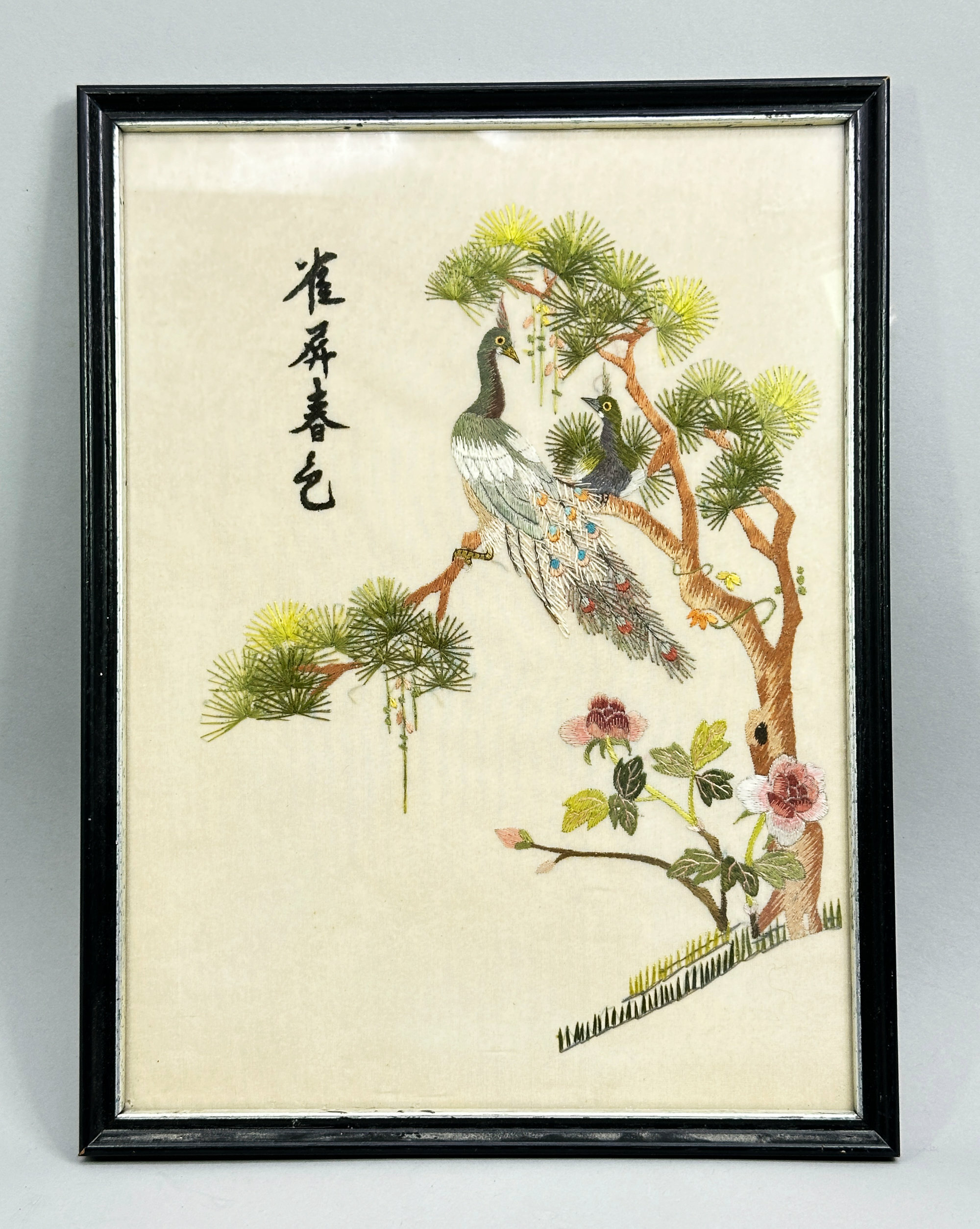Chinese & Japanese Works of Art
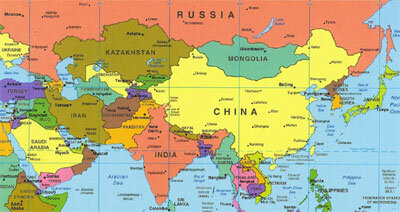

Chinese Framed Ceramic Plaque depicting Peony, C20th
Price: £150
Pair of Chinese Cloisonné Vases, mid C20th
Price: £75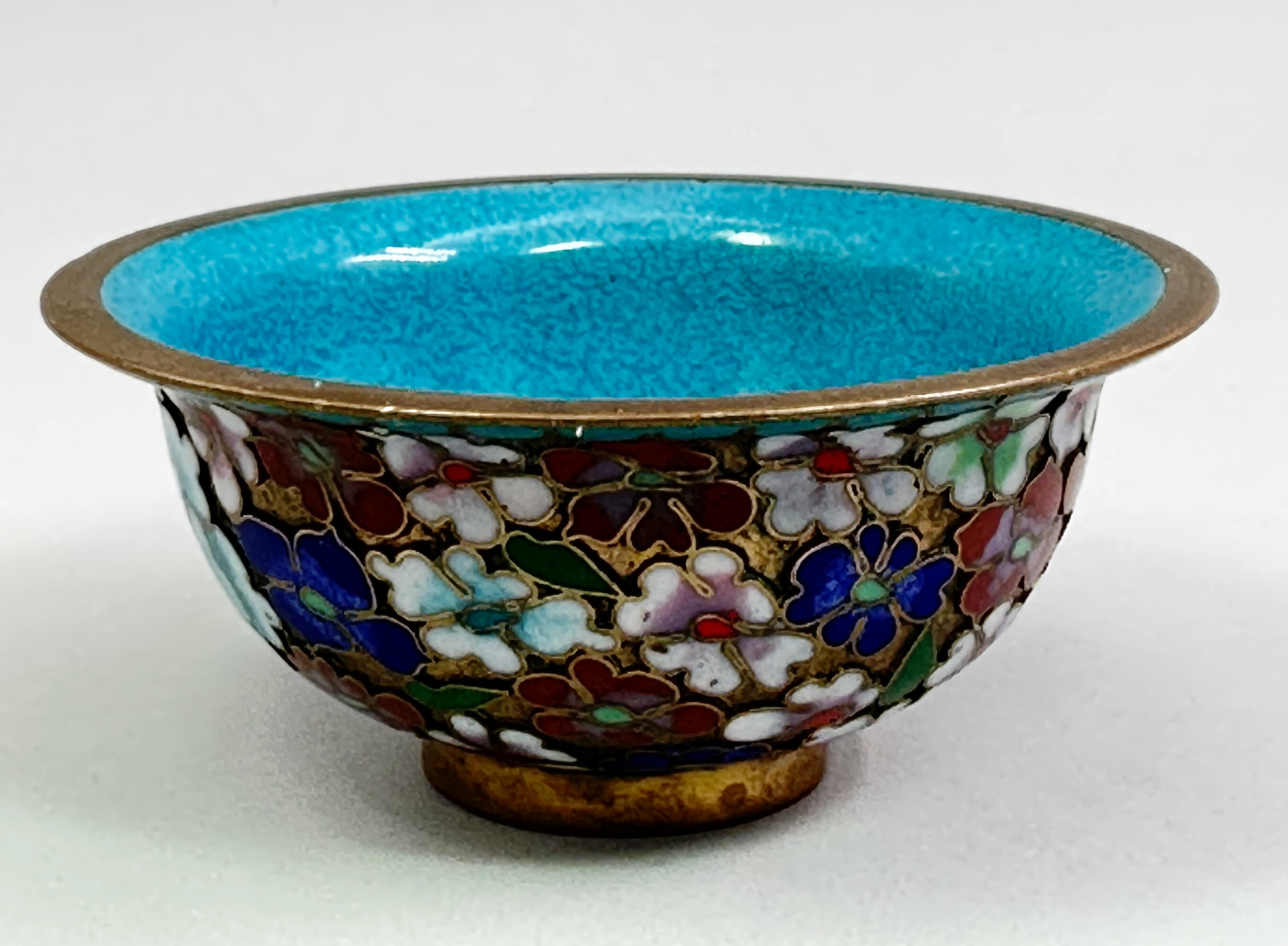
Small Chinese Gilt Ground Cloisonné Bowl, C20th
Price: £35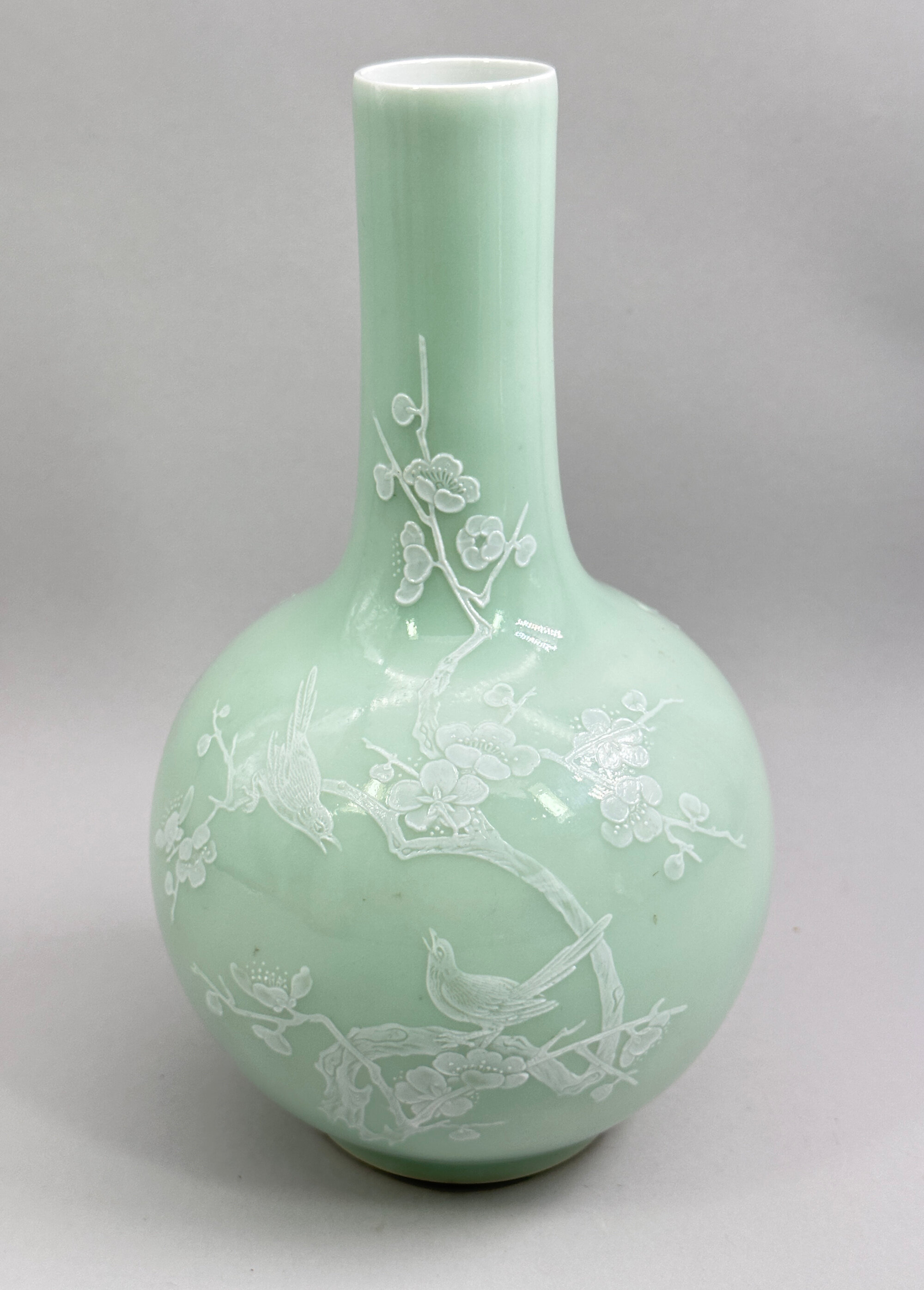
Chinese Celadon Glaze Bottle Vase with White Slip decoration, Jingdezhen mark, C20th
Price: £75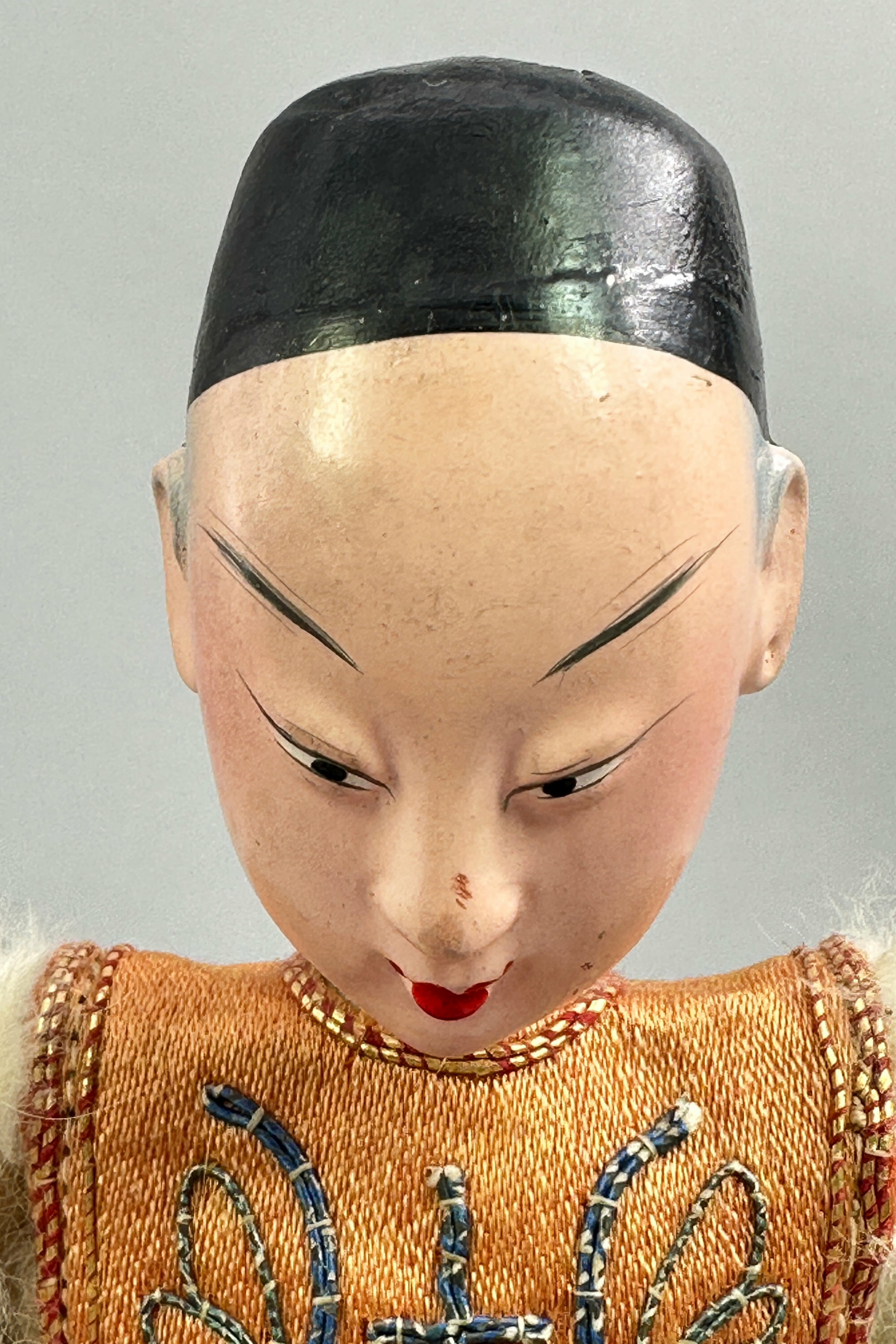
Chinese Doll of a man dressed in traditional costume, early C20th.
Price: £95
Japanese Kutani Vase of Water Dropper form, circa 1880
Price: £45Kutani (the word means 'nine valleys') porcelain was made at various factories in the former Kaga province of Japan. The earliest pieces were in a completely different style employing a palette of colours emphasising green, the so called 'Ko Kutani'. Production of this ceased around 1730, and manufacturing was not revived until the early nineteenth century when the more familiar colourings of iron red and gold were introduced. This small vase is typical of pieces exported to the West in fairly large quantities at the end of the nineteenth century. The form suggests a water dropper and is found in Imari colourings as well. Many of the Kutani pieces were marked, sometimes simply 'Ku' 'Tani' as here. The glaze was sometimes unstable with a tendency to craze as can be seen here, but this is original to the manufacture and does not detract from the piece's decorative appeal.

Japanese Arita Bowl decorated with panels of flowers and interior Scenes, circa 1820
Price: £45The rather more elaborate style of decoration here and the addition of enamel colours to the standard imari palette of underglaze blue, iron red and gold resembles 'kenjo imari' pieces produced in Japan in the eighteenth century and in the early nineteenth century, a specific type of Imari that was highly decorated and meant for domestic consumption, Kenjo, meaning 'for presentation'. The paste of the foot, harder and smoother than that used in the later nineteenth century, suggests a dating here to around 1820 before trade with the West was temporarily paused. The form suggests a cup for Sake and this piece was probably one of an original set of five, but it stands on its own as a decorative item in miniature.

Japanese Noh Figure Doll of a Lady, Showa Period (1926-1989)
Price: £55Dolls such as these were made for display, sometimes at the special ‘Doll’s Day’ or ‘Girls Day’ festival held annually on the third of March and termed ‘Hinamatsuri’. The elaborate dress is sometimes known as ‘Hagoromo’ (‘feathered’) and the mask with its fixed expression derives from the well known ‘Noh theatre’, a major form of Japanese musical drama created in the fourteenth century which combines dance, music and song and is still performed today. The actors are all male and play the female roles wearing a lady’s mask.
The craftsmanship of this piece is self evident and it was most likely made in the second half of the C20th. It can stand equally well on its own or as part of a wider collection and would be a desirable acquisition either way.

Chinese Bone Netsuke carving of a man holding a musical instrument, early C20th
Price: £25
Chinese Bone Netsuke carving of a Sage, early C20th
Price: £45
Chinese Reverse Painted Glass Globe depicting tigers, Modern
Price: £45
Chinese Reverse Painted Glass Globe depicting deities and attendants, Modern
Price: £45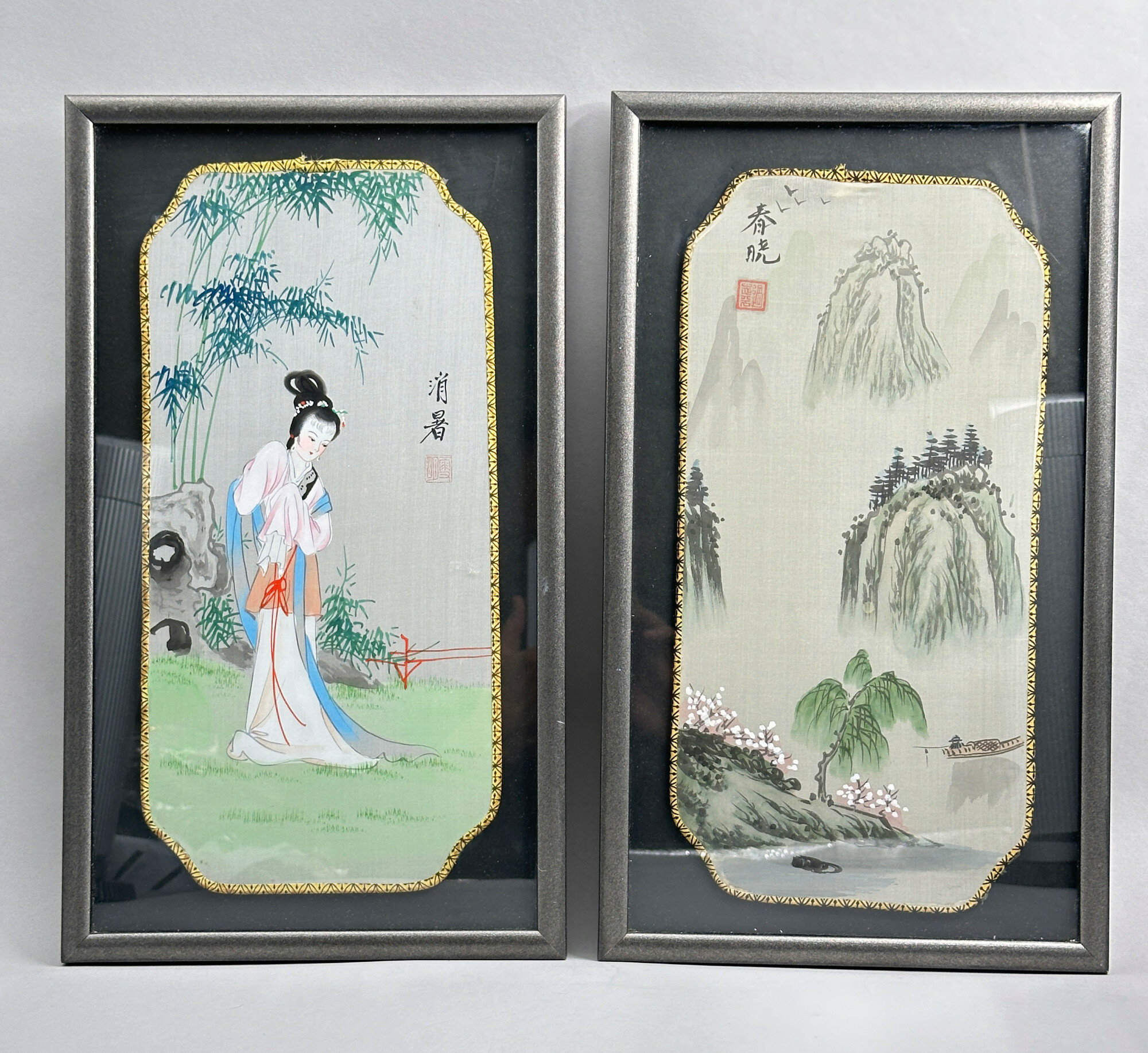
Pair of Chinese Paintings on Silk, framed, C20th
Price: £45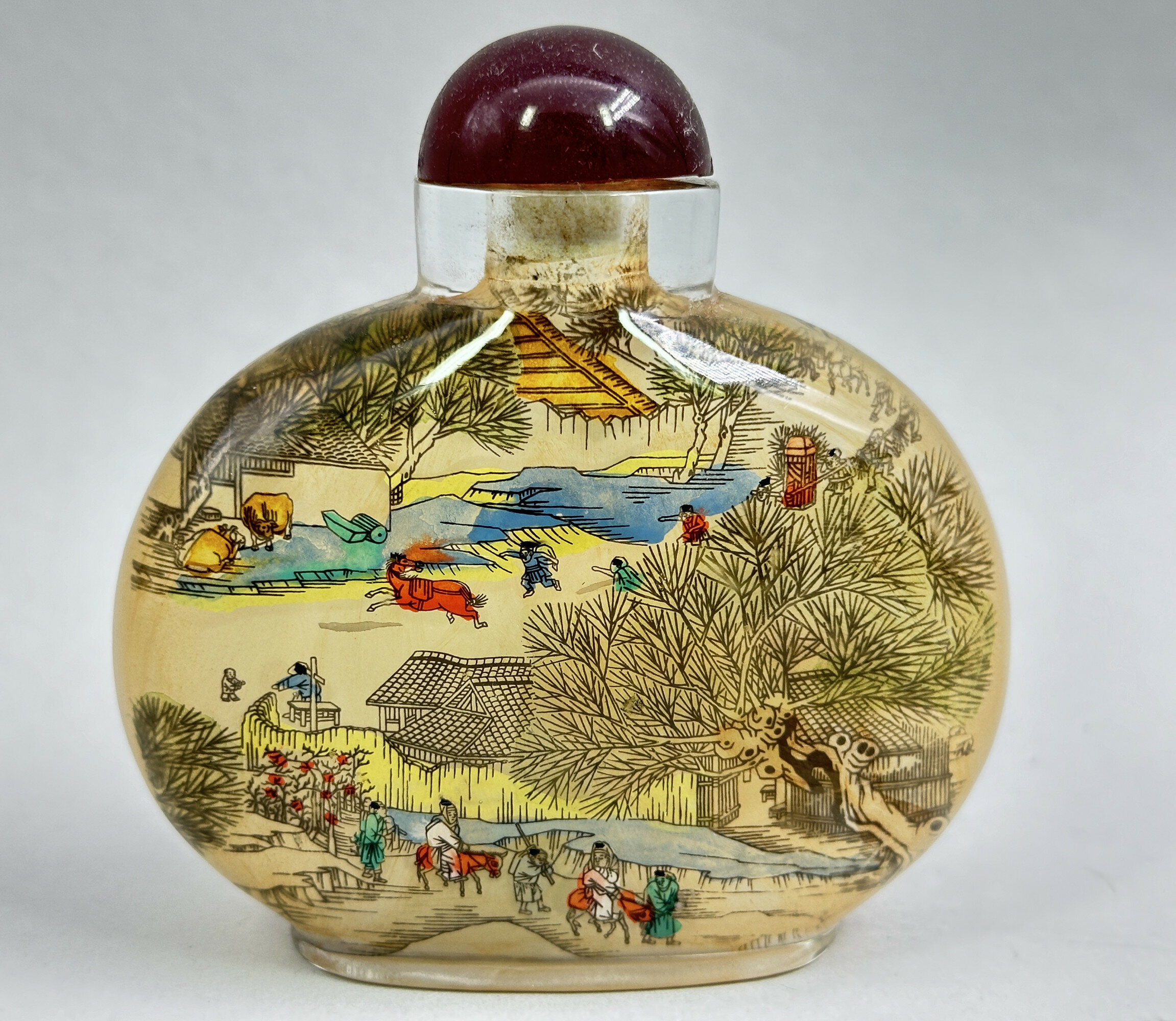
Chinese Verre Églomisé Snuff Bottle with landscape scenes, fitted box, C20th
Price: £35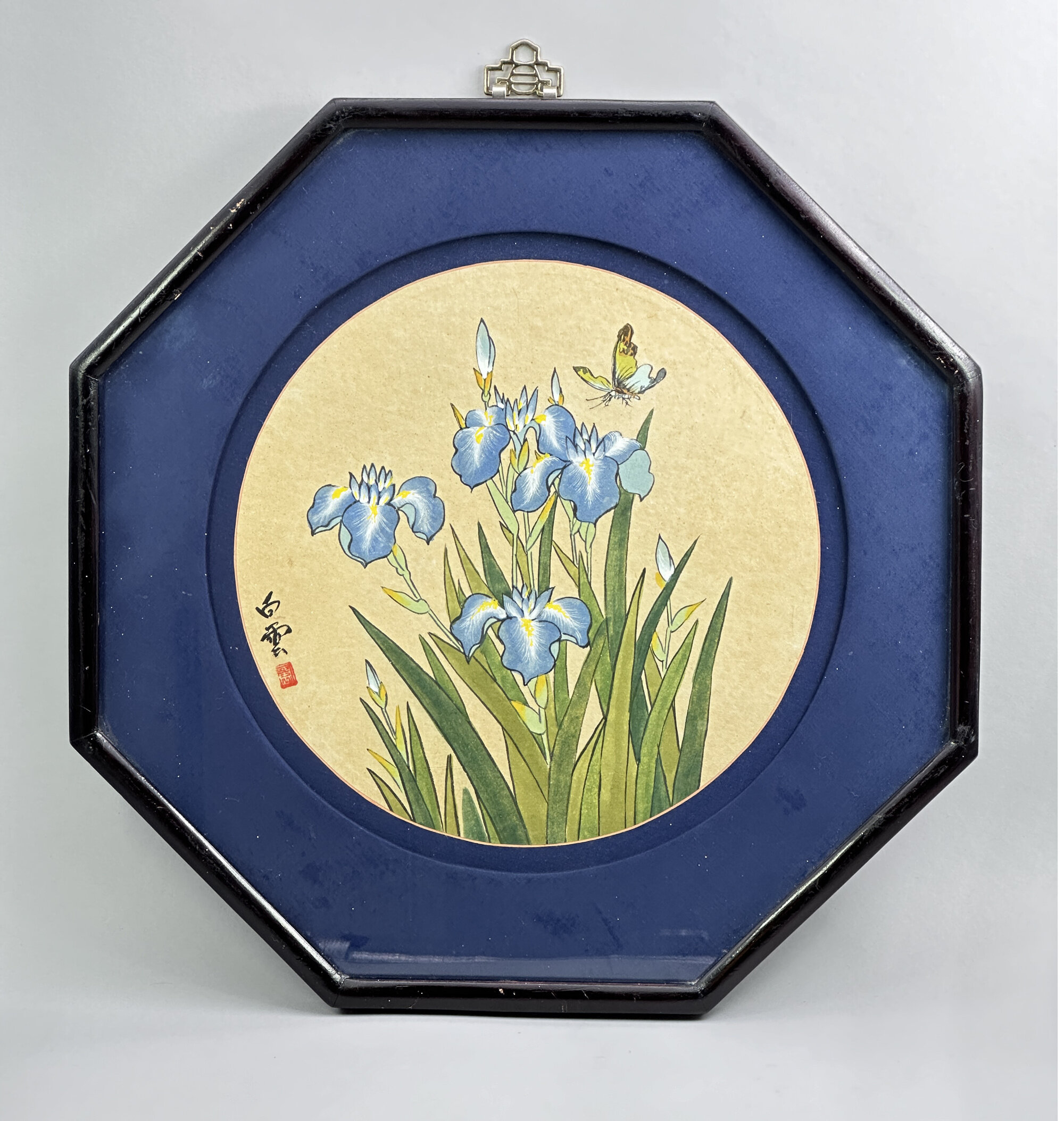
Japanese Gouache Painting of Flowering Lotus, signed and framed, C20th
Price: £45
Pair of Japanese Arita Shallow Bowls circa 1880
Price: £75The town of Arita in the former Hizen Province, northwestern Kyūshū island, was a major centre for the production of porcelains in Japan. Best known for blue and white pieces it also produced polychrome wares as well, including the familiar imari colourings. While similar to Imari, the wider palette of colours used here is usually termed ‘Arita’ and the decorative appeal of the style is clear. These bowls probably come from an original set of five and their quality is much above average. Dating is to the Meiji era (1868 - 1912) probably around 1880.
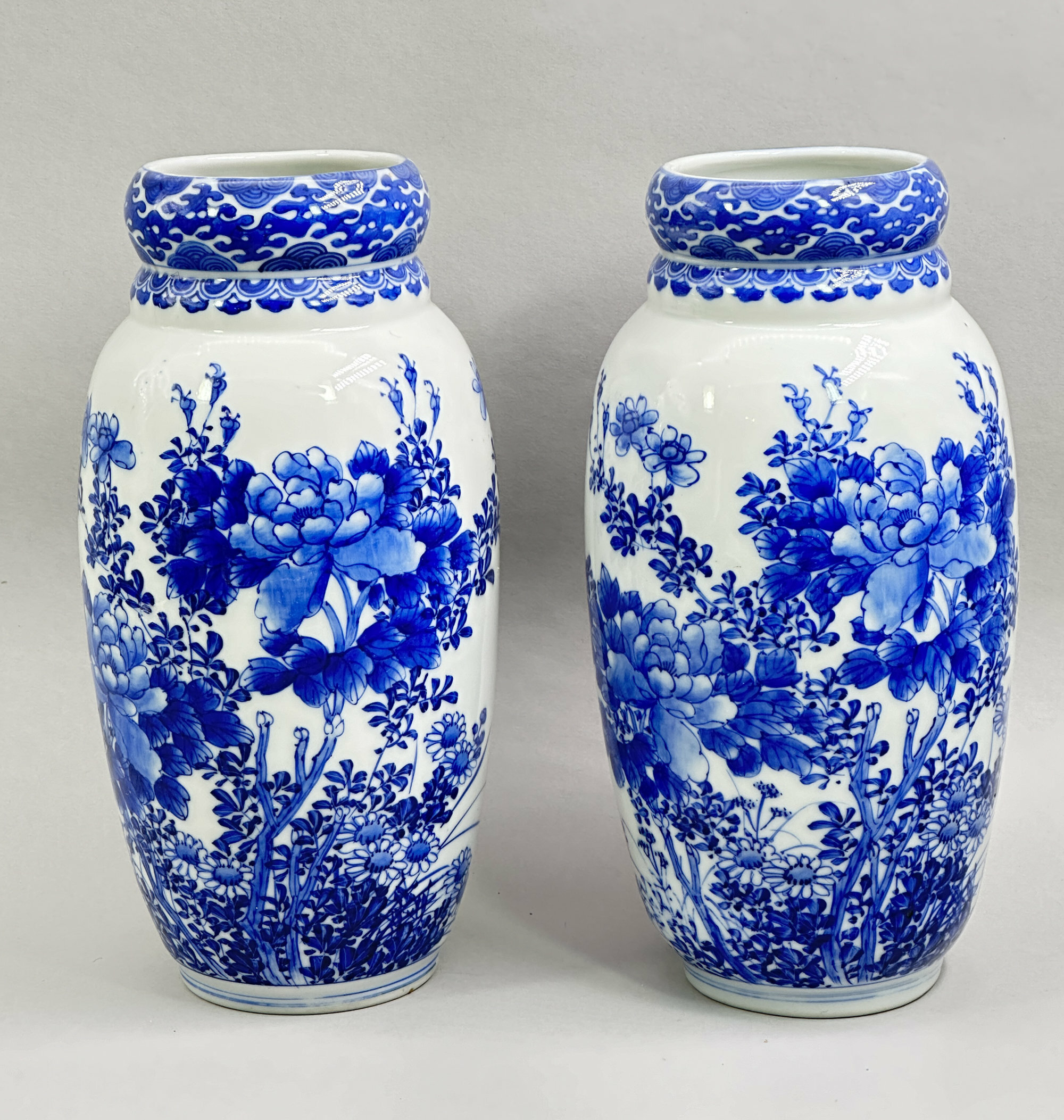
Pair of Japanese Blue and White Seto Ware Vases, early C20th
Price: £240The finely drawn brushwork here and the distinctive bright blue are characteristics of pieces made at Seto in Japan in the 19th and early 20th centuries. The city of Seto is located in the Aichi Prefecture and was the location of one of the Six Ancient Kilns of Japan. Pottery was produced there from the 13th century onwards. The kilns took part in the export of decorative wares to the West from the second half of the nineteenth century onwards producing a wide variety of forms, in particular pairs of vases, but with a speciality in flat plaques and table tops, for which they gained something of a monopoly. Their pieces are usually marked, to include the characters for Seto, and this pair of vases may have originally been signed themselves but with the marks partially obliterated in the firing process. The quality here matches anything else produced by the factories but the light weight and thinly potted body suggests a dating to the early 20th century rather than before, probably during the Taisho period (1912-1926). Nevertheless the skill in craftsmanship is obvious and contributes to a highly attractive pair of ornaments for a contemporary interior.
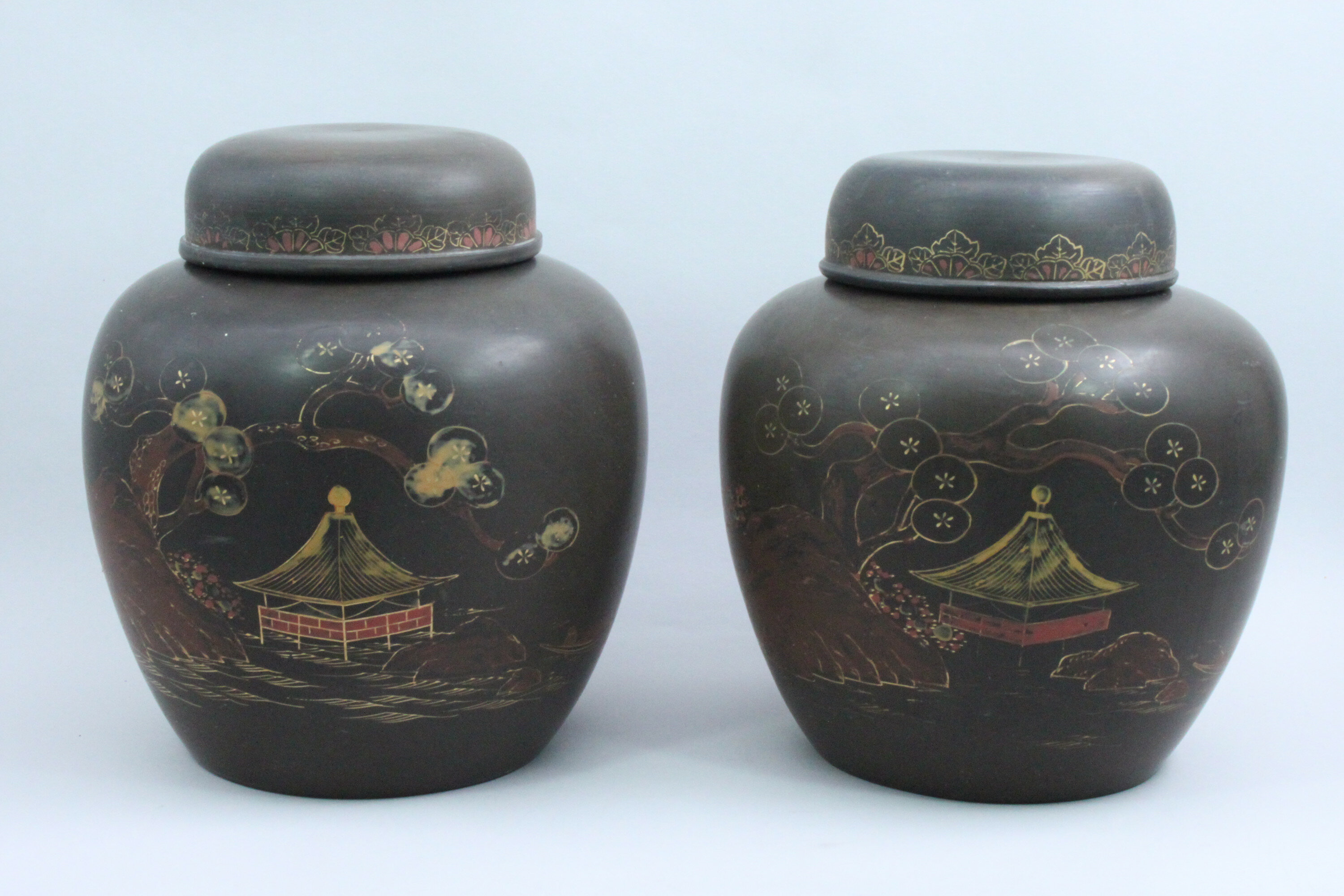
A Pair of Japanese Lacquered Porcelain Ginger Jars and Covers, late C19th
Price: £240
Japanese Blue and White Porcelain Bowl decorated with hydrangea, early C20th
Price: £25Hydrangeas flourish in Japan and also carry a hidden meaning of apology and gratitude based on a mythical story of an Emperor, who angered a woman he loved by neglecting her, and gave her in recompense a bunch of blue hydrangeas as a symbol of his deep emotion and gratitude. Used here as a decorative motif, the painting of the flowers is skilful and elegantly combined with the plainer exterior. The paste of the foot rim suggests an early C20th dating, perhaps to the late Taisho era (1912-1926).
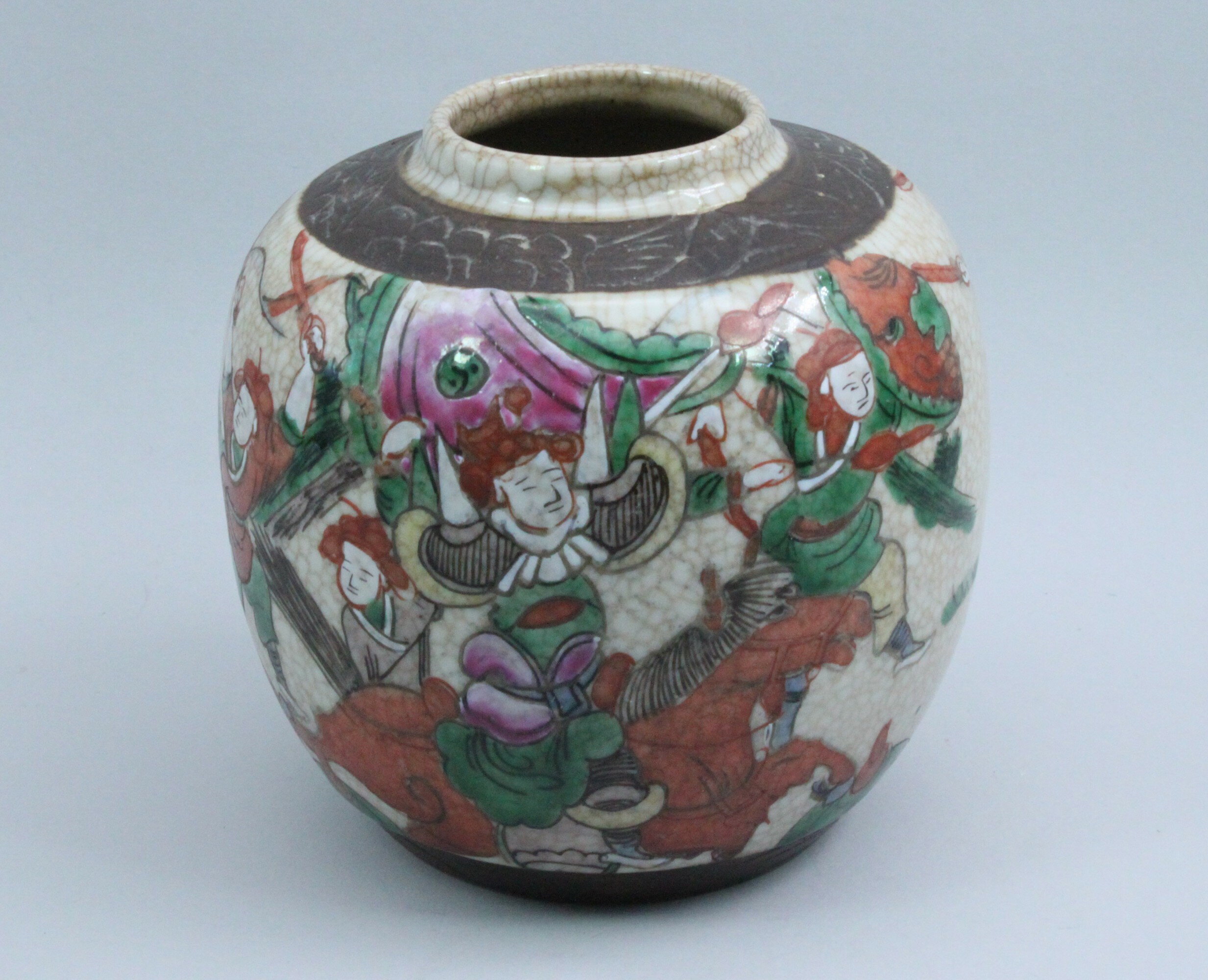
A Chinese Crackleware Famille Verte Ginger Jar decorated with Warriors circa 1880
Price: £45'Crackleware' glazed pieces, usually with 'bronzed bands, were a staple output of the Chinese potteries from the mid nineteenth century onwards and were produced in a wide variety of mainly vase shape forms, both in polychrome and blue and white and intended as decorative pieces for the Victorian rooms of the West. As with other ceramic types, the quality deteriorated and this piece is typical of late nineteenth century productions of a more modest level of craftsmanship but still retaining a naif charm. As with many ginger jars, this one lacks its original domed cover which would have been decorated to match.

Chinese Fan, painting on silk, 1960s
Price: £15
Two Chinese Fans, painting on silk, 1960s
Price: £15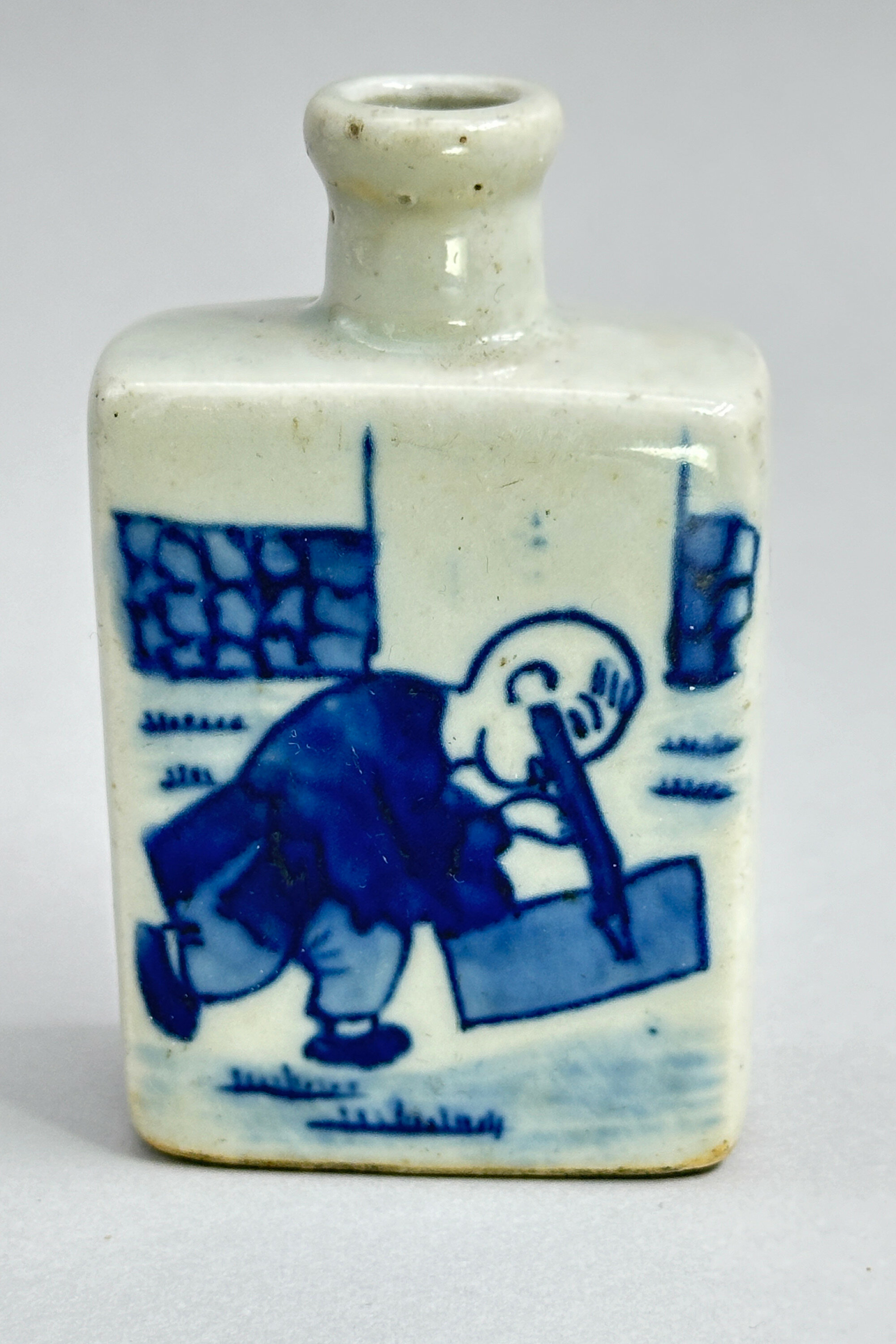
Chinese Blue and White Snuff Bottle circa 1900
Price: £45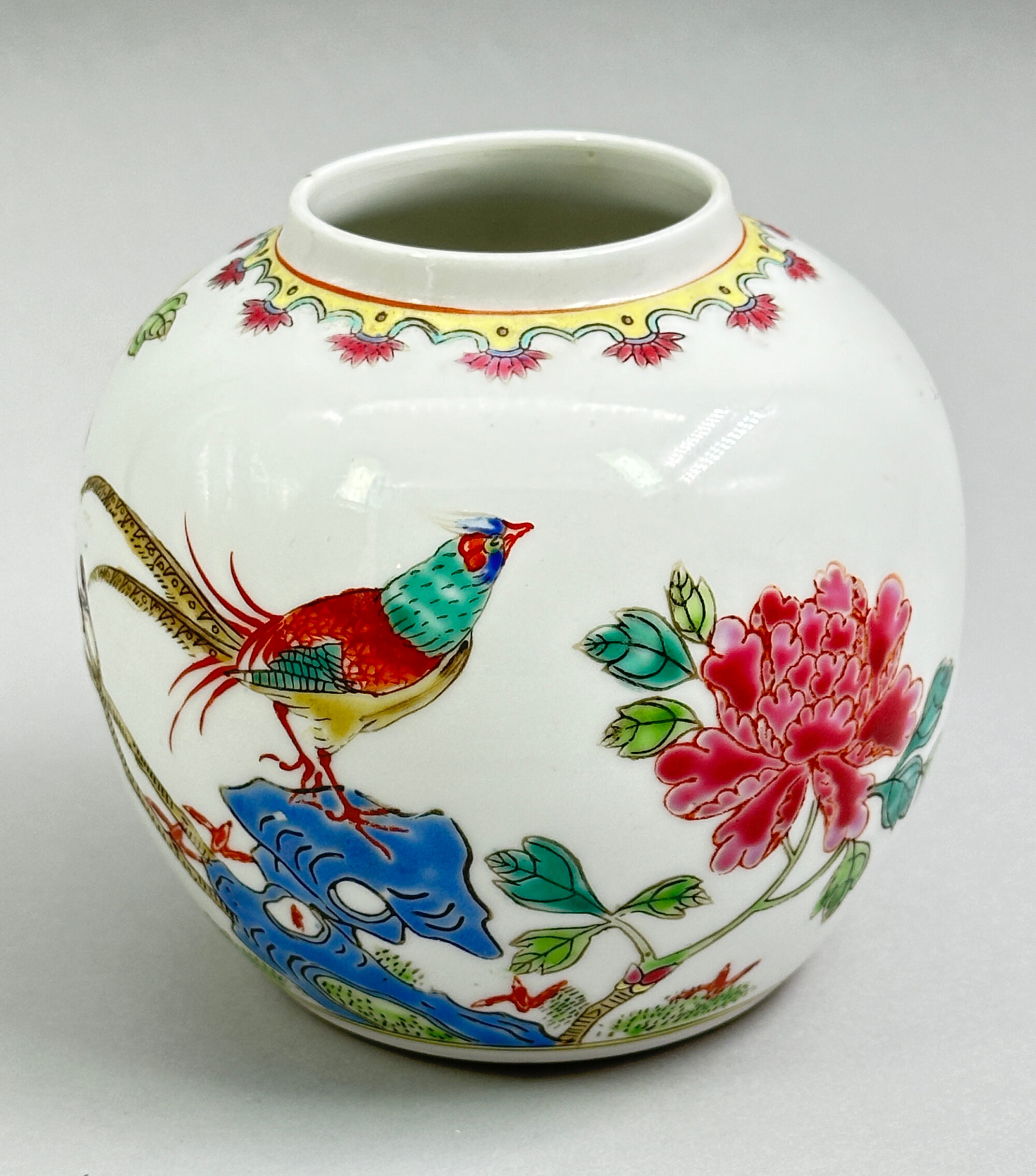
Small Chinese Ginger Jar decorated in Famille Rose enamels, second half C20th
Price: £25The stamped mark to the base reads ‘Zhongguo Jingdezhen Zhi (China Jingdezhen Made)’ with the letter ‘V’ between two lines. In the early 1950s almost all the factories in Jiangxi, the province where the kiln town Jingdezhen is situated, were merged into larger units, each made up of ten to fifteen previously independent factories. From this time factory numbers such as we have here (=V=) came to be used and many pieces are found with a wide variety of letters and numbers indicating the various cooperatives. The quality of the productions varied and it is a reasonable assumption that increasing years witnessed a decline. While other examples of this type of jar exist, some with their original domed covers, this piece is of the very best quality, indeed the work matches earlier pieces in the style very closely, and a dating to the mid 1950s seems quite plausible. It shows that the Chinese potters continued to produce to a high standard when they chose to do so and provides a pleasing memento of the closing era of a tradition of porcelain production stretching back long into the past.

Japanese Arita Blue and White Bowl, first half C20th
Price: £25This ‘swirling’ pattern is sometimes found on late nineteenth century polychrome plaques. Dating here is probably later, perhaps to around 1920, in the middle of the Taisho period (1912 – 1926), but care has been taken with this piece and the mark, which unfortunately cannot be deciphered, no doubt denotes the studio which created it.

Japanese Arita Dish circa 1880
Price: £45The town of Arita in the former Hizen Province, northwestern Kyūshū island was a major cente for the production of porcelains in Japan. Best known for blue and white pieces it also produced polychrome wares as well, including the familiar imari colourings. While similar to Imari, the wider palette of colours used here is usually termed ‘Arita’ and the decorative appeal of the style is clear. This plate probably comes from an original set of five and its quality is much above average. Dating is to the Meiji era (1868 - 1912) probably around 1880.
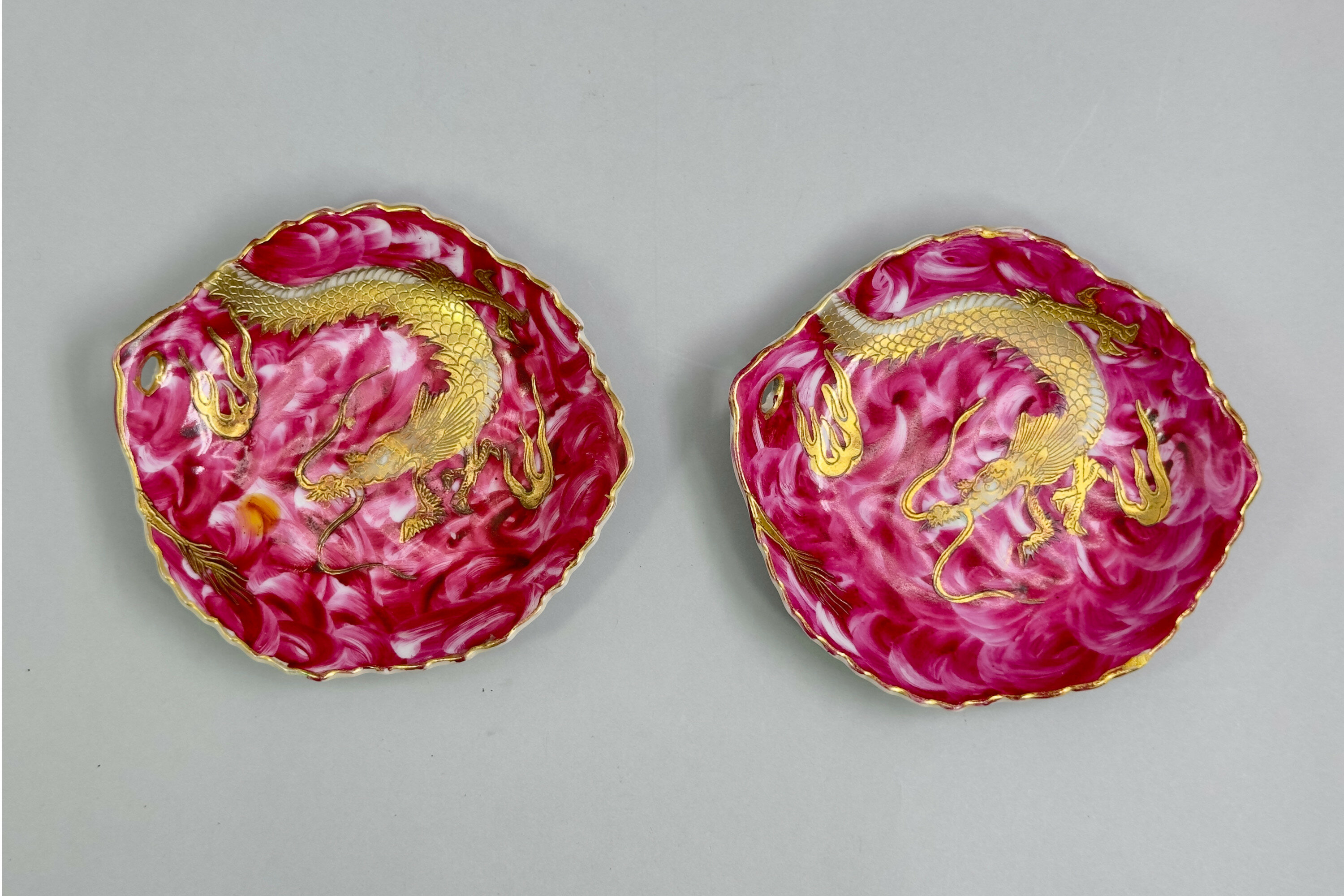
Pair of Japanese Shaped Saucer Dishes, Maruku China, 1940s
Price: £25The Maruku factory seems to have operated in Japan after the second world war producing modest but good quality wares for export, rather in the style of Noritake pieces. Usually their pieces are marked in addition ‘Made in Japan’ but for some reason not here. The forms, colourings and designs here are quite unusual and while modest, these are good quality decorative items suitable for a contemporary interior.
PLEASE NOTE THAT THERE IS FREE UK SHIPPING ON THIS ITEM. For international buyers the shipping cost will be reduced by the UK shipping cost, so don't worry if you are outside the UK, you still receive this benefit!

Nesting Set of Four Small Brass Trays with an engraved designs of Bats, Chinese C20th
Price: £30
Brown Alabaster Egg painted with a bird and flowers, fitted wood stand, Chinese C20th
Price: £25
Japanese Kutani Shell Shape Dish, circa 1880
Price: £55Kutani (the word means 'nine valleys') porcelain was made at various factories in the former Kaga province of Japan. The earliest pieces were in a completely different style employing a palette of colours emphasising green, the so called 'Ko Kutani'. Production of this ceased around 1730, and manufacturing was not revived until the early nineteenth century when the more familiar colourings of iron red and gold were introduced. Many pieces were exported to the West in a variety of forms including vases and wall plates. This shell dish is more unusual; the shape is more normally found in Chinese ceramics. Perhaps one of an original pair, this dish, like its Chinese counterparts, was probably intended as a serving dish and could even be used as such today although it can well stand as a decorative item.
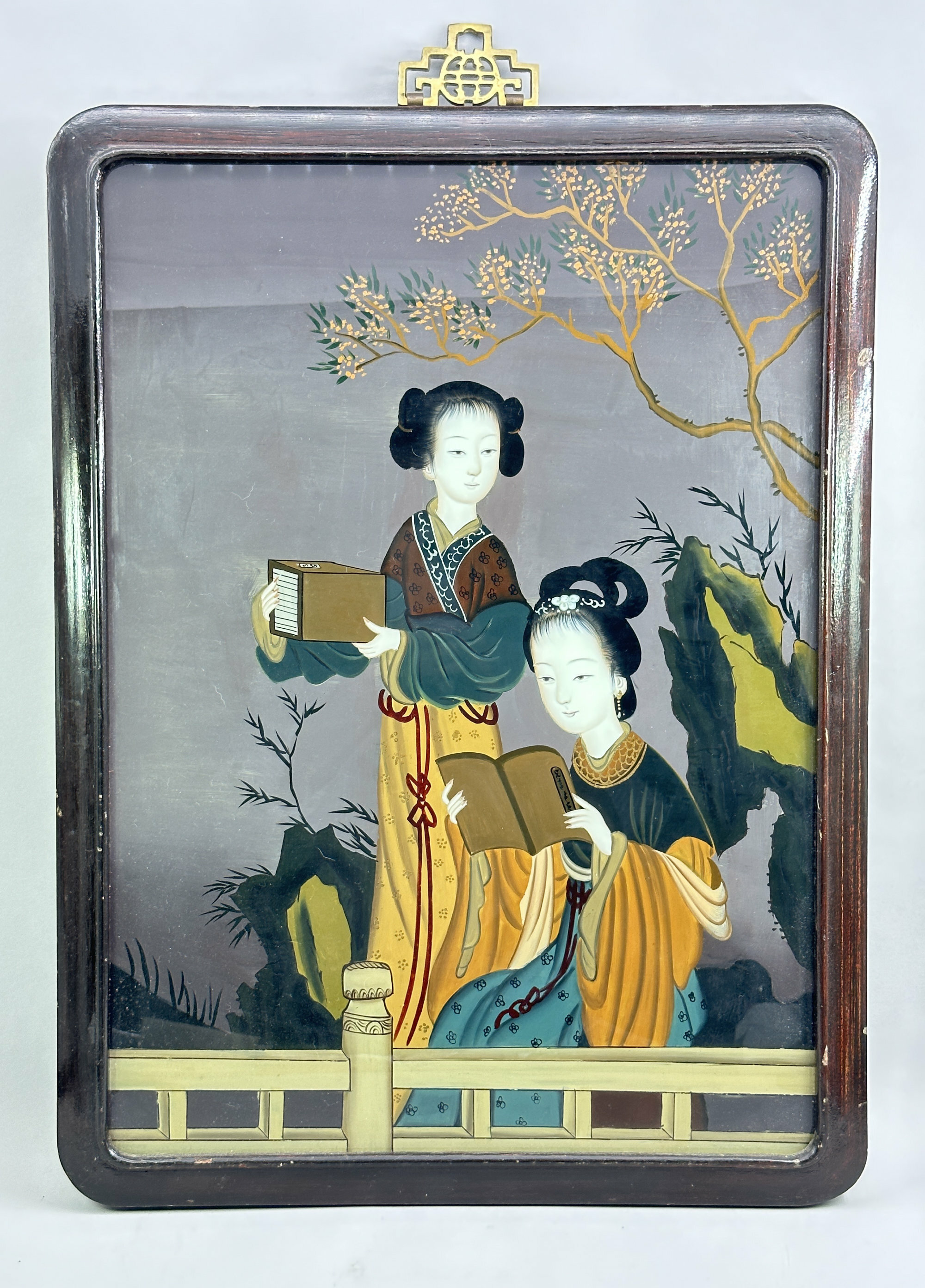
Chinese Reverse Glass Painting of Two Ladies on a Garden Terrace, first half C20th
Price: £240
Pair of Japanese Noritake Vases, early C20th
Price: £35The Noritake compnay was set up by the Morimura family at Noritake near Nagoya in the early twentieth century. Called at first 'Nippon Toki Kaisha Ltd' on its founding in 1904, the business soon changed its name to 'Noritake' and began the manufacture of porcelains for the domestic and export markets. The mark seen here is interesting. It comprises a 'Komaru' symbol, crowned with "Noritake" and with the mark 'Made In Japan'. The centre symbol said to be taken from the Japanese character "Komaru", meaning "overcoming difficulties". According to the Noritake company tradition this mark was designed when contact with the different culture of the west early in the 20th century caused problems of adaptation. It is also known as the 'tree crest mark' which is the clan crest of the Morimura family. This mark is said to have been registered in London for the UK market by 1908. The curled up ends of the Komaru symbol seen here distinguish this mark from later versions and allow a dating of this piece to the early twentieth century.
Noritake porcelain became synonymous with finely potted tea and breakfast services made in great quantities for export. These vases are a rather more unusual production and show the factory capable of producing high quality pieces with decorative potential.

Chinese Soapstone Brushwasher decorated with flowering Lotus, early 20th Century
Price: £45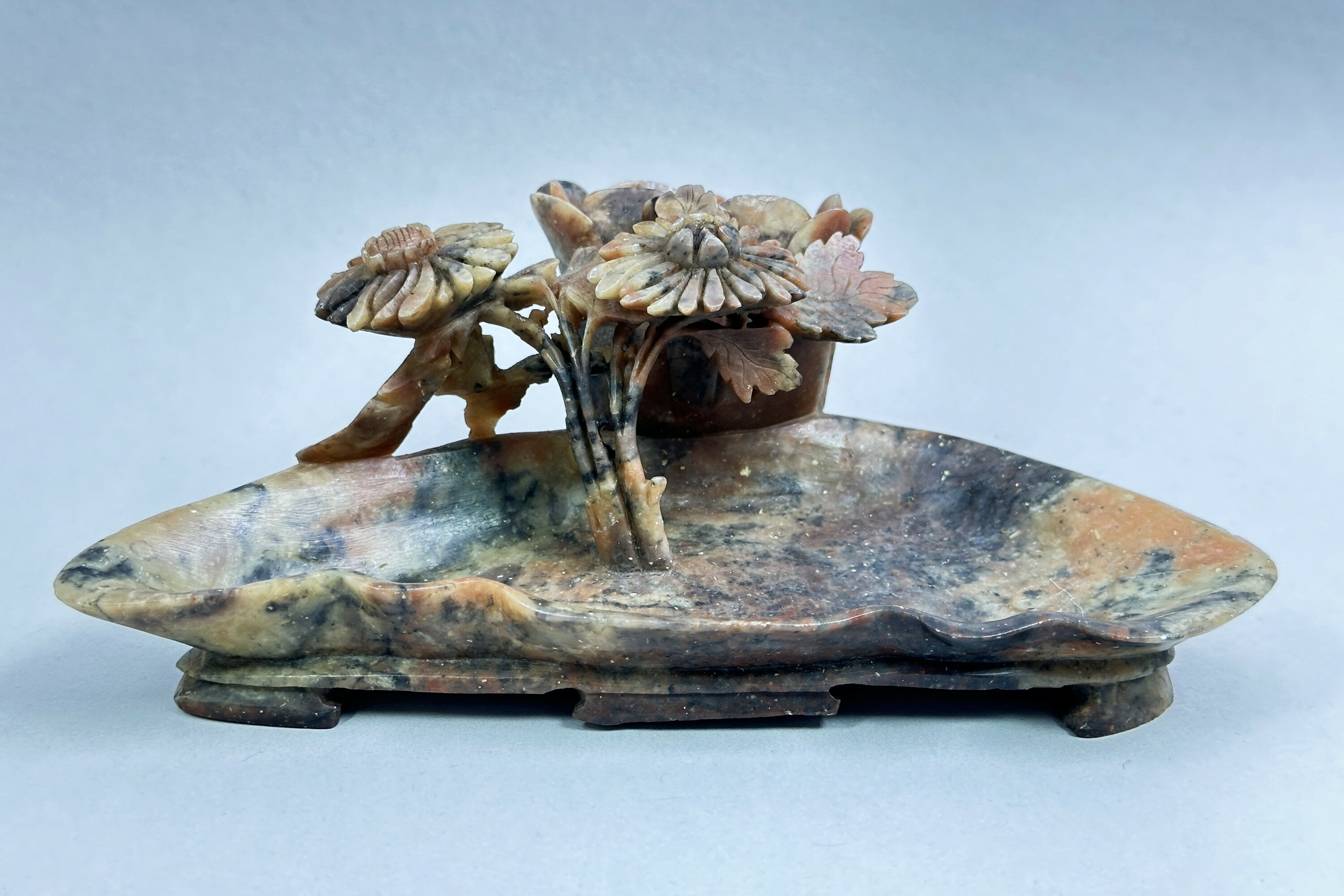
Chinese Soapstone Brushwasher with flowering lotus, early C20th
Price: £95
Set of Four Chinese Plates, Beauties of the Red Mansion, Jingdezhen, 1980s
Price: £75Please note that the stands are for display purposes only.
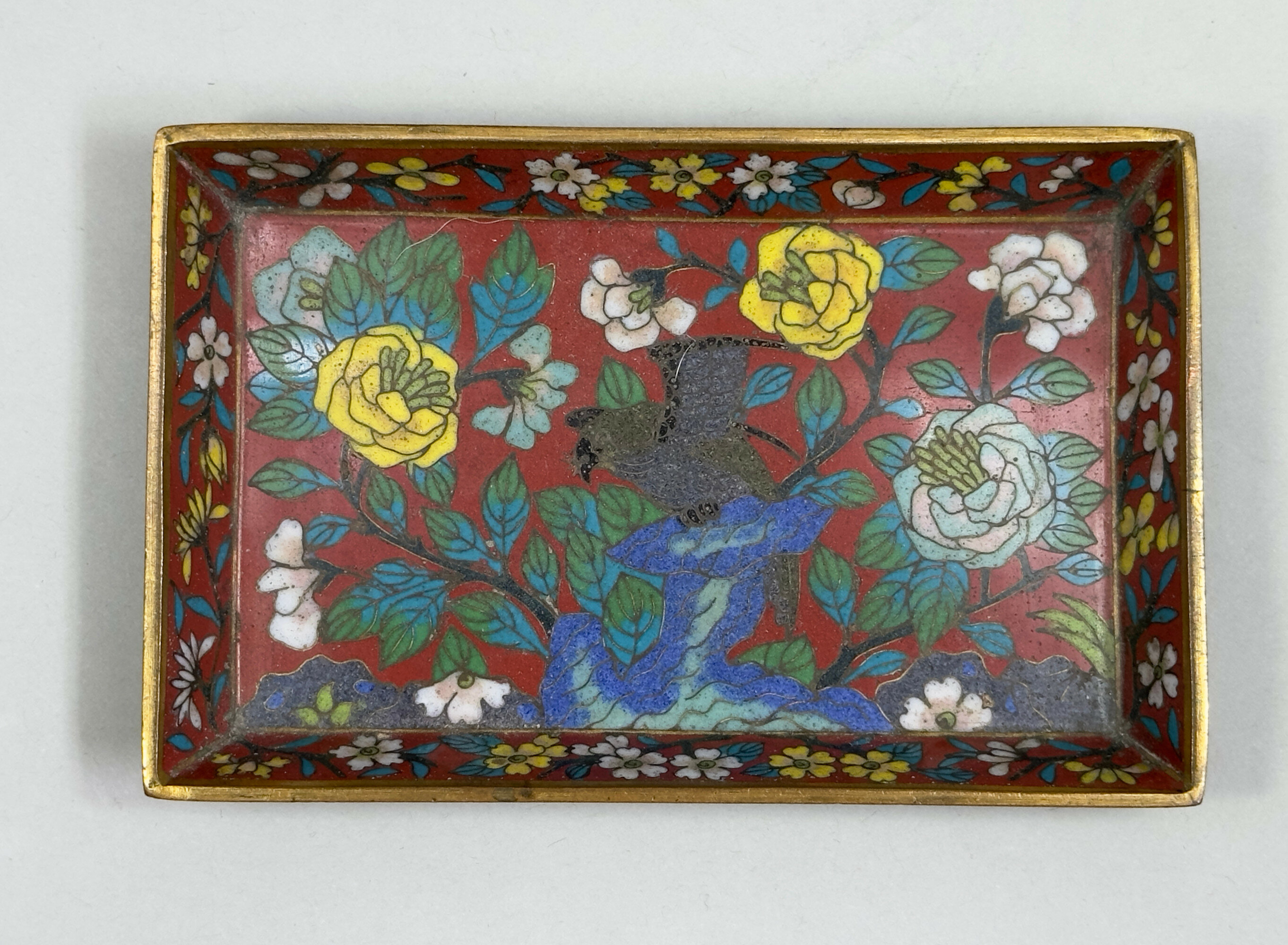
Chinese Cloisonne Small Tray decorated with Flowers and Rocks, 19th Century
Price: £150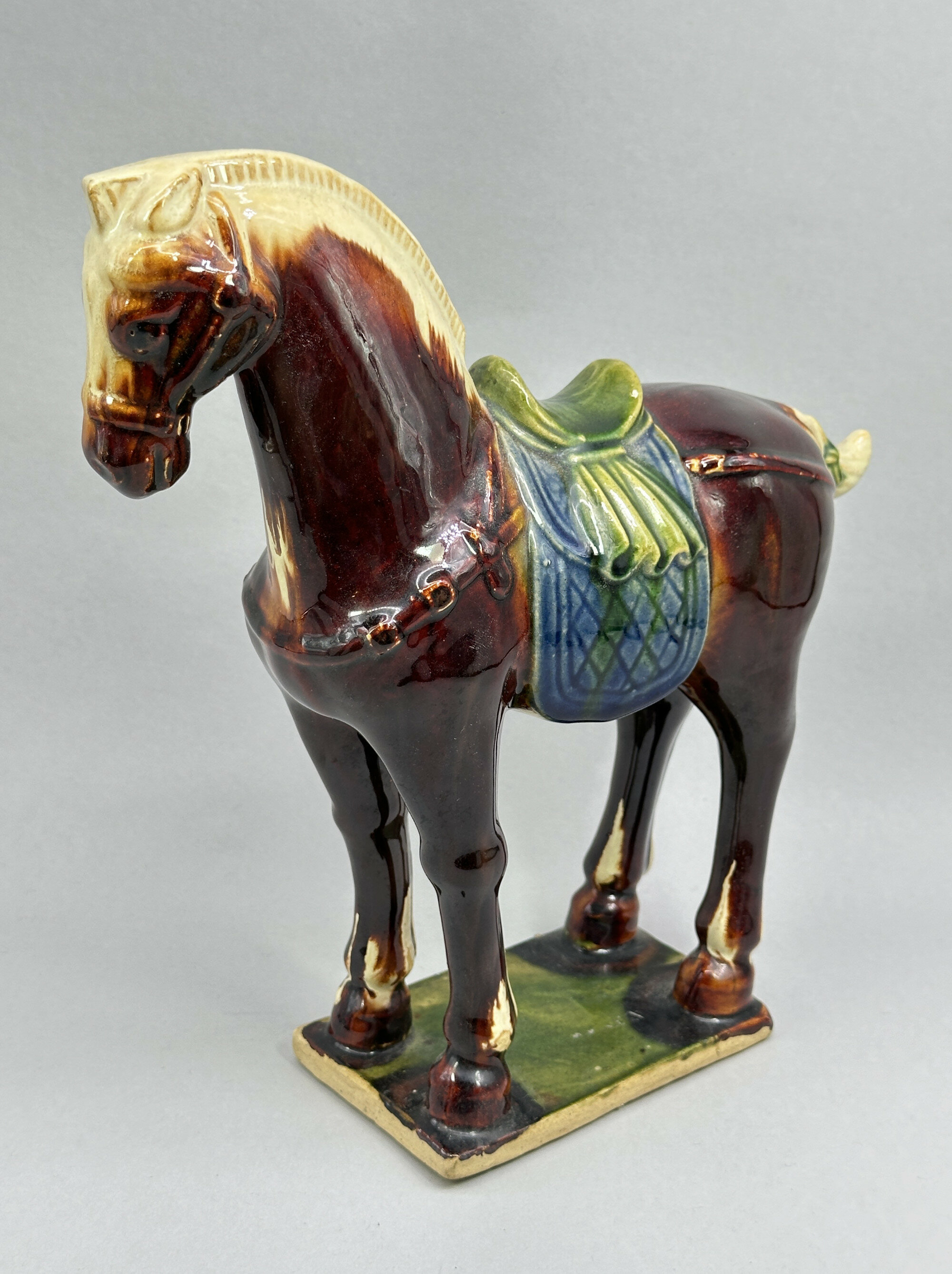
Chinese Sancai Glaze Model of a Horse in the Tang Dynasty Style, 20th Century
Price: £45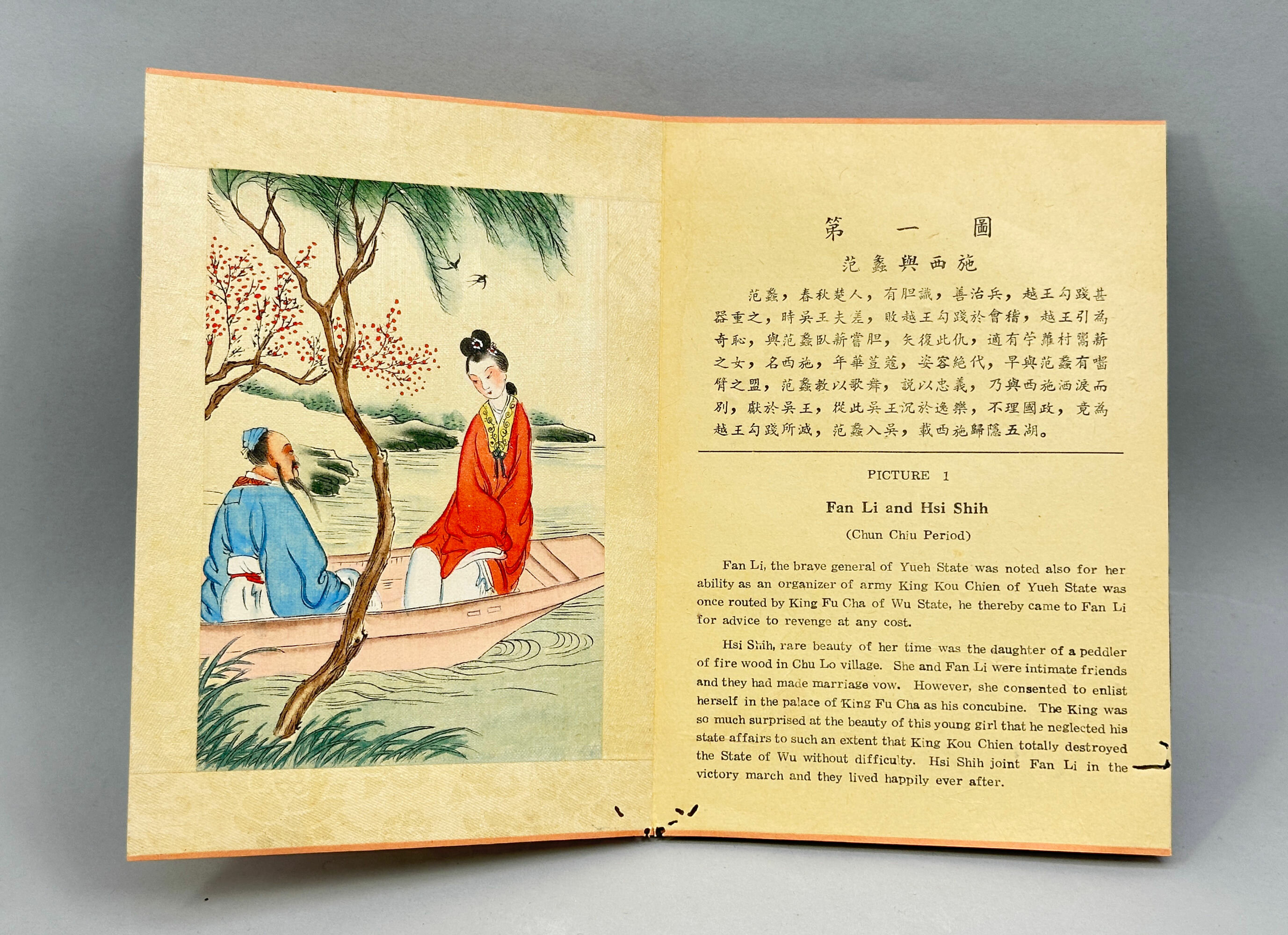
The Braves and the Fair Men of Letters and Women of Fame of Old China circa 1900
Price: £75Each of the ten characters are described in a double page spread, the right hand containing texts in both Chinese and English and the left hand with hand coloured illustrations on silk , delicately rendered. All ten ‘couples’ represent the Confucian of harmony between husband and wife. The book 'works' from right to left and the reverses of the pages are left blank. At each end are fabric covered boards, the front board with a pasted paper inscription in Chinese with a small red seal mark. Other examples are finished with boards in wood, but these are, perhaps, not original or a more deluxe version of the volume. In addition there are other books in a near identical format and presumably issued by the same publisher including ‘Stories of Ancient Chinese Noted Beauties’ and ‘Eight Fairies Festival’.
The illustrations are in excellent condition with the colours still bright. The yellow finish to the paper is original and perhaps intended to give an 'antique' effect. Each of the end boards are very slightly scuffed at the borders. Some of the pages, including the title page and the two end papers, suffer from varying degrees of 'worm hole' perforation. There are also various small tears. A full set of illustrations can be seen above and further images (and a more detailed condition report) are, of course, available on request. But these condition issues should not necessarily detract from the charm of the item which is an attempt to present some of the folk lore of China for Westerners keen to know more about the culture of a country which had attracted such popular interest during the Victorian period.
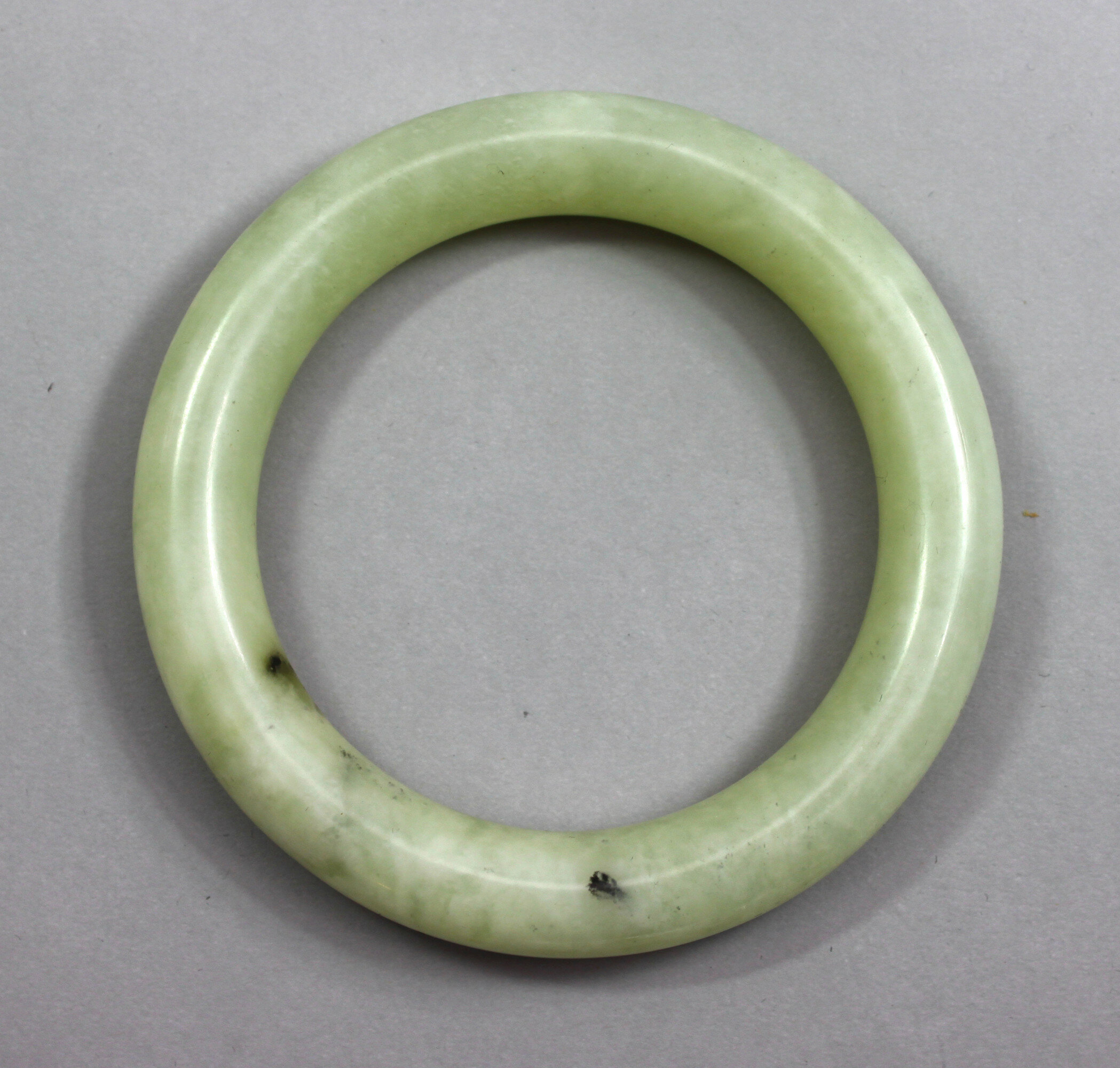
Chinese Pale Celadon Jade Bangle, probably Nineteenth Century
Price: £45Jade is usually divided into two types, nephrite jade and jadeite jade. The latter is heavier and slightly harder, making it more difficult to scratch. The weight of this piece suggests that we do have jadeite here. The stone was selected for carving on the basis of its attractive appearance and the finish, which bears no trace of machine tooled manufacture, suggests a pre twentieth century dating, but certainty in these matters is notoriously difficult
The size of this piece is unusually large, suggesting that it would have been intended for a male wearer. This too suggests an earlier rather than later time of manufacture. The stone is exceptionally pleasant to the hand and would have been an elegant accompaniment to any wardrobe.

Large Chinese eglomise scent bottle 1950s
Price: £75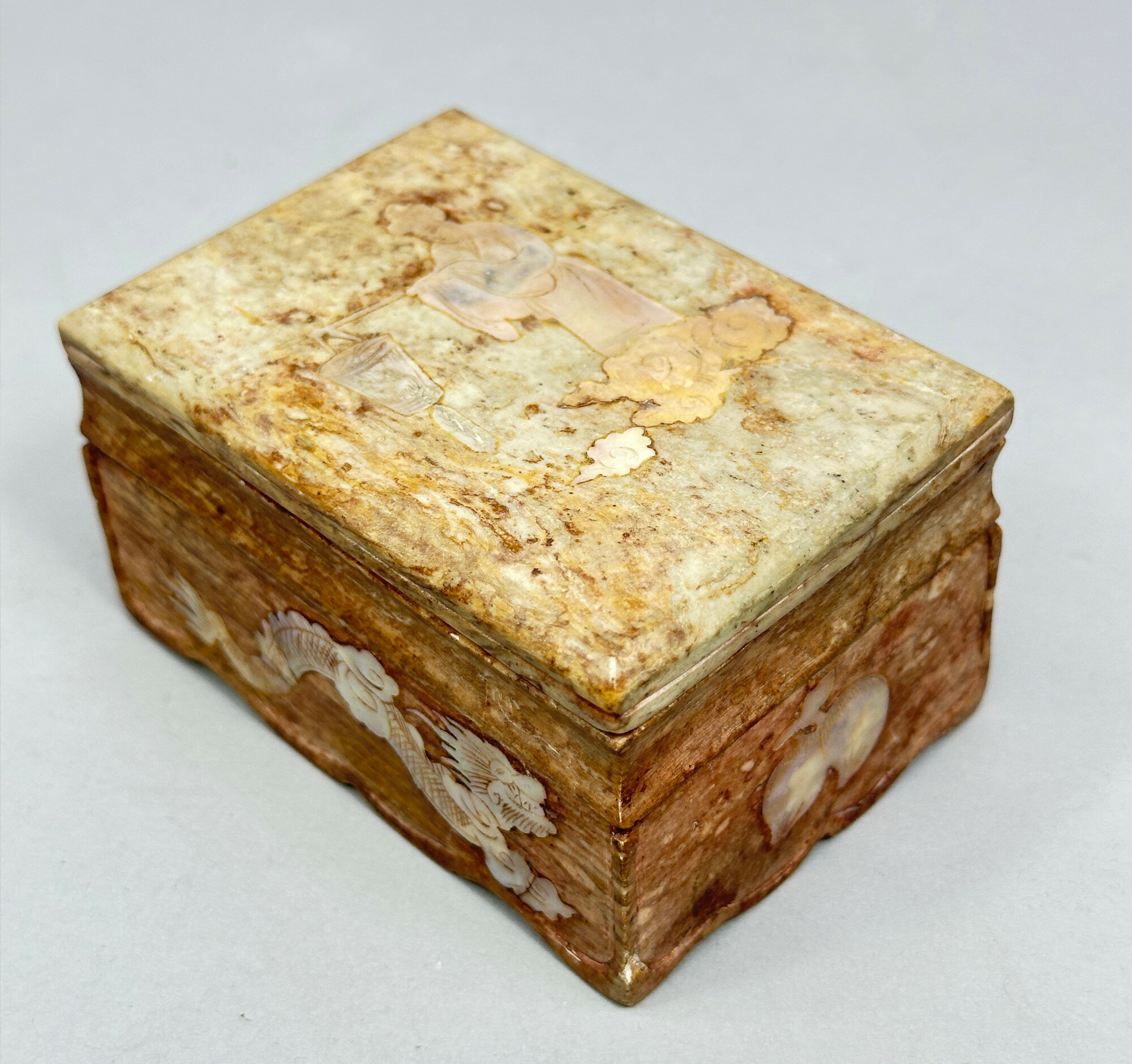
Chinese Soapstone Box and Cover with Mother of Pearl Inlay, C20th
Price: £55
Chinese four panel Table Screen with embroidered silk panels, signed and boxed, C20th
Price: £110
Chinese Famille Rose Bowl decorated with ladies, Qianlong mark, Republican period
Price: £45PLEASE NOTE THAT THERE IS FREE UK SHIPPING ON THIS ITEM. For international buyers the shipping cost will be reduced by the UK shipping cost, so don't worry if you are outside the UK, you still receive this benefit!

Pair of Japanese Prints, C20th
Price: £25PLEASE NOTE THAT THERE IS FREE UK SHIPPING ON THIS ITEM. For international buyers the shipping cost will be reduced by the UK shipping cost, so don't worry if you are outside the UK, you still receive this benefit!

Pair of Japanese red lacquered low stands, Taisho period
Price: £150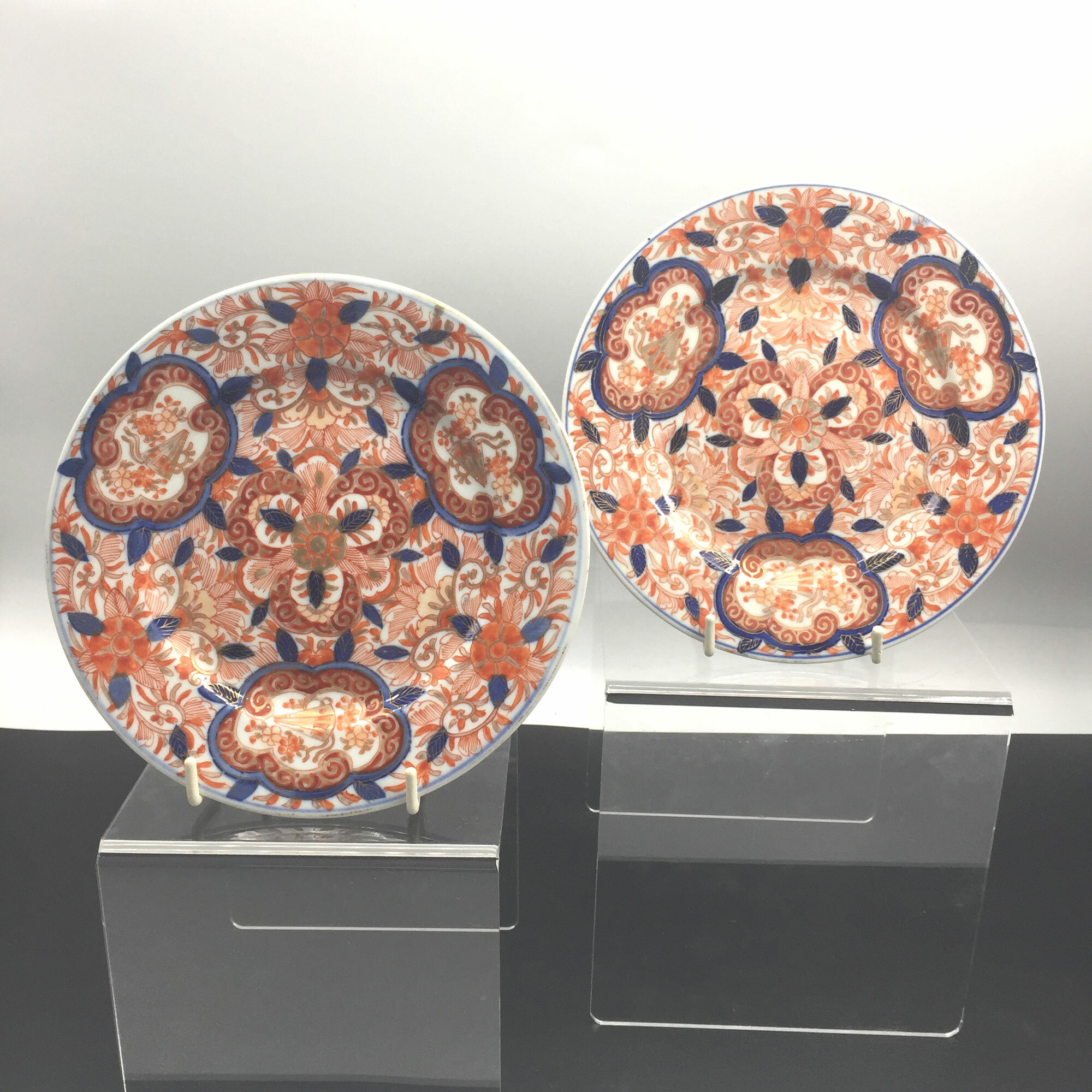
Pair of Japanese Imari Plates, Meiji Period circa 1880
Price: £150
Chinese Bronze Mounted Emerald Green Jade pendant, Qing dynasty
Price: £180It has been suggested that the form of the stone indicates it was intended as a handling token, some sort of a 'pass key', but this may well be apocryphal, although it does indeed sit comfortably when gripped. But the decorative qualities of this piece are clear and the maker clearly saw that this was a stone to be exploited and displayed. A contemporary wearer now would certainly attract attention! The weight and quality of the bronze suggest a reasonably early dating, perhaps to the late eighteenth century.

Three Chinese Canton Enamel Dishes, Nineteenth Century
Price: £45
Japanese Fukagawa Imari Bowl, signed, circa 1880
Price: £380The Fukagawa kilns produced the best quality Imari items made in Japan in the late nineteenth century for export to the West. Their history starts with Ezaiemon Fukagawa who in 1856 became head of his family's porcelain business and in 1875 founded Koransha (The Company of the Scented Orchid) in Arita, Japan, to produce tableware for export. In 1894 the modern Fukagawa company was founded by Chuji Fukagawa, with the Fukagawa trade mark of Mount Fuji and a stream, as its trade mark. Dating here is within the Meiji period (1868 - 1912) probably around 1880. This conforms with the script mark used as opposed to the later symbol design.

Translucent celadon jade recumbent horse
Price: £25
Japanese Fukagawa Imari Vase of Sake Bottle Form circa 1880
Price: £180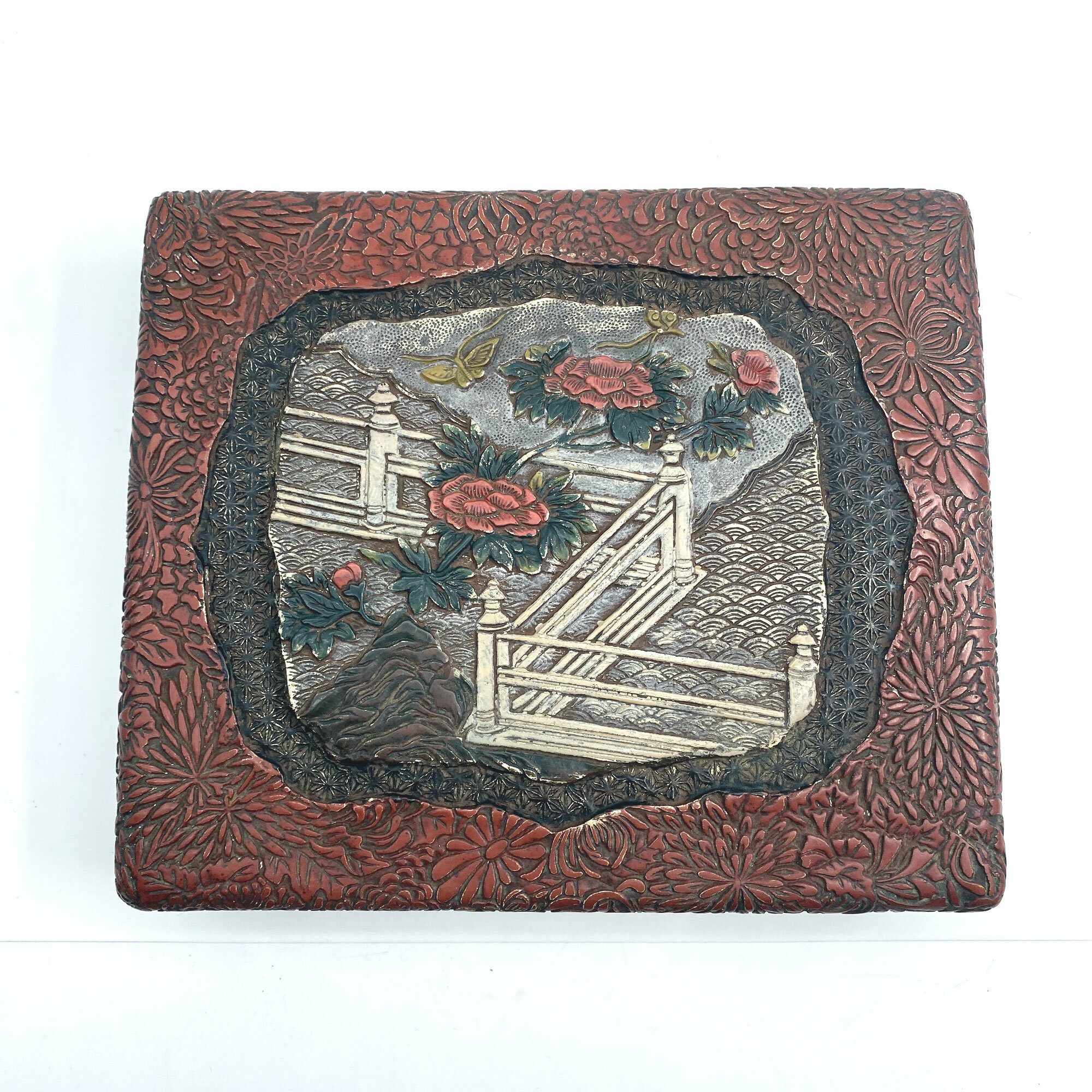
Japanese red lacquer Box and Cover with inset bone plaque, late C19th
Price: £75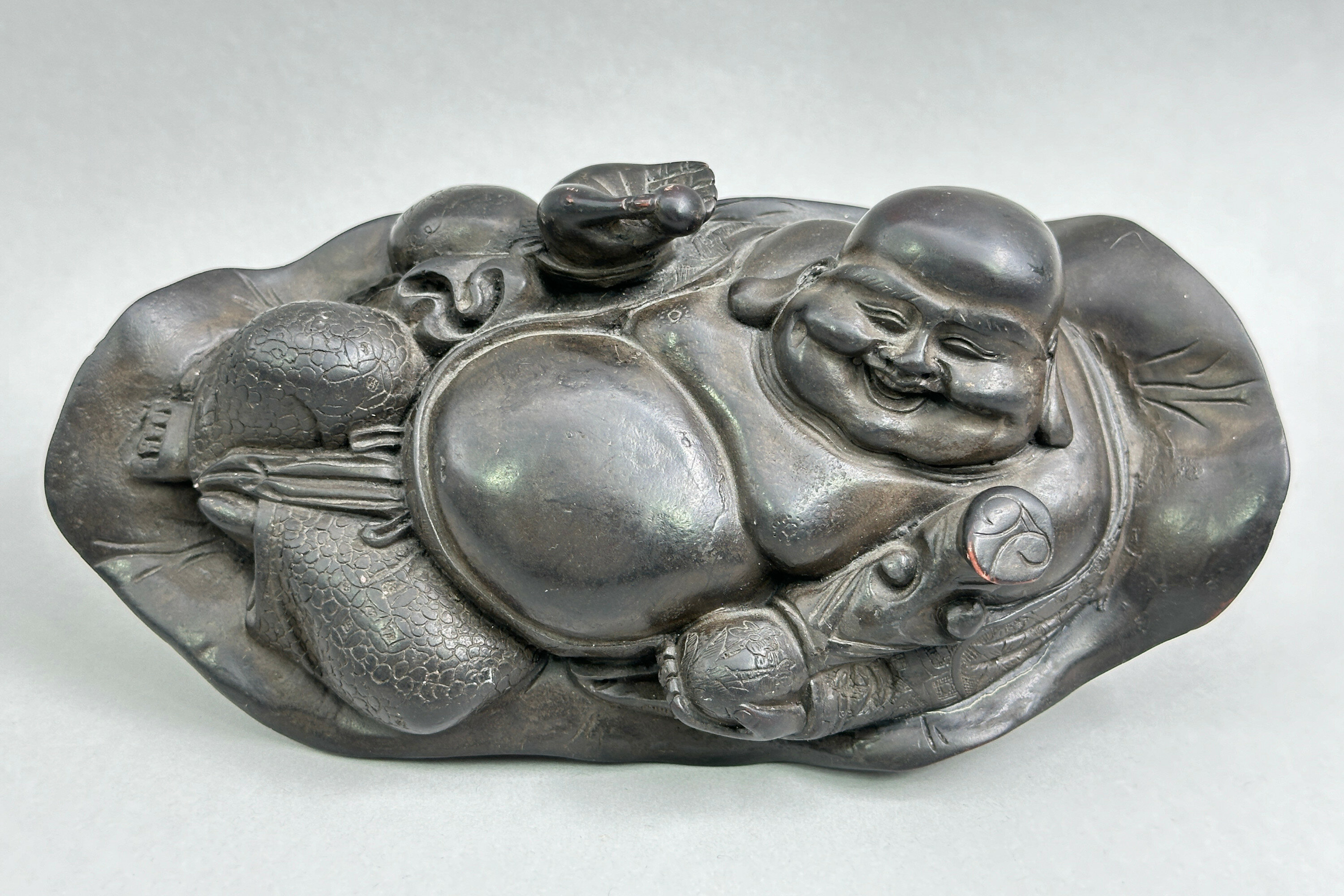
A Chinese Carved Wood Figure of Budai, signed, C 19th
Price: £75
Chinese Rice Grain Plate decorated in underglaze blue, iron red and gold, circa 1900
Price: £45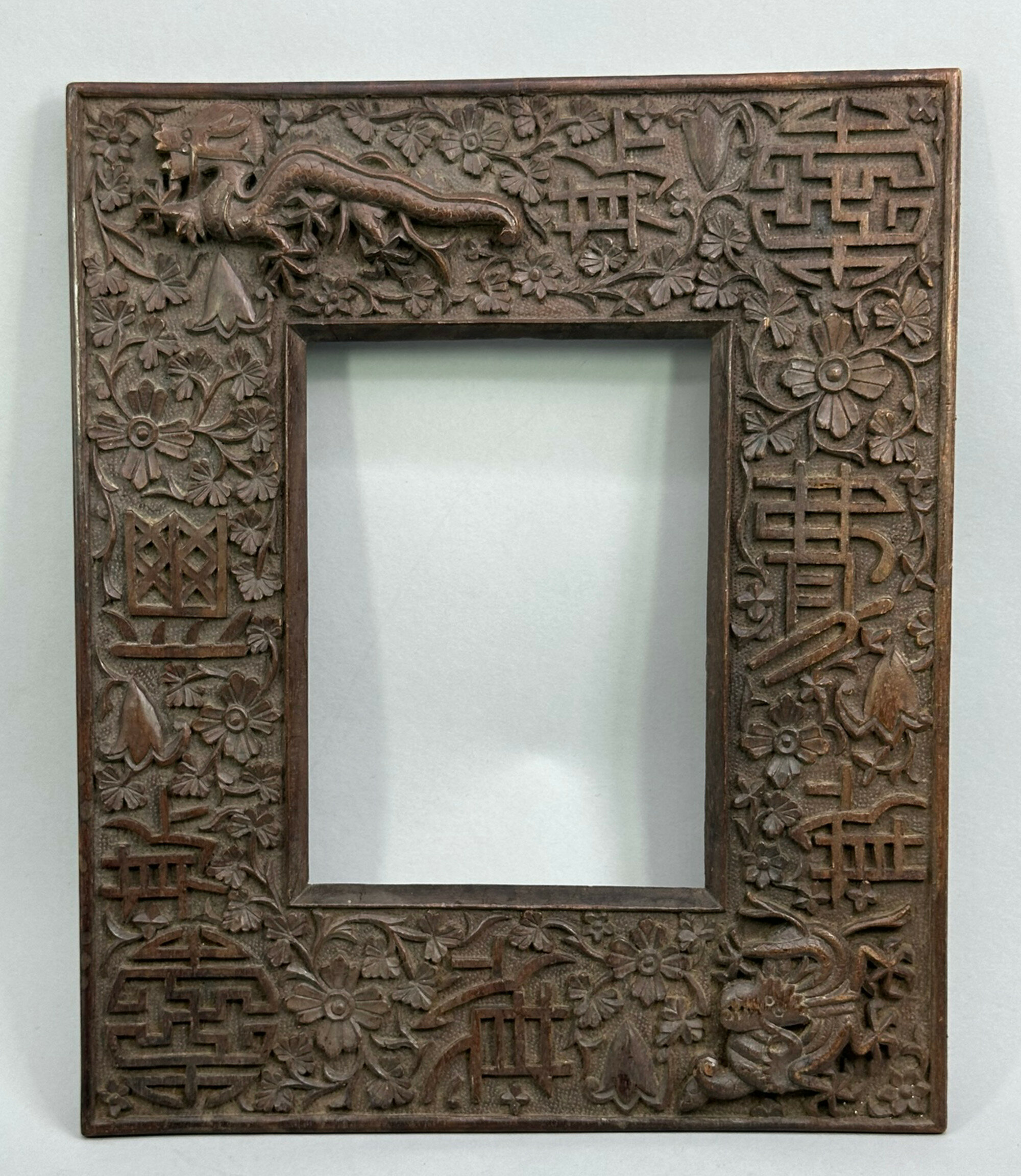
Chinese carved hardwood frame, 1920s
Price: £55
Small Chinese Bronze Vase of Ku Form with Elephant Head Handles, Qing Dynasty circa 1800
Price: £75
Set of two vintage Chinese painted eggs in glass display boxes
Price: £25
Lot of 3 vintage Chinese miniature cork groups
Price: £25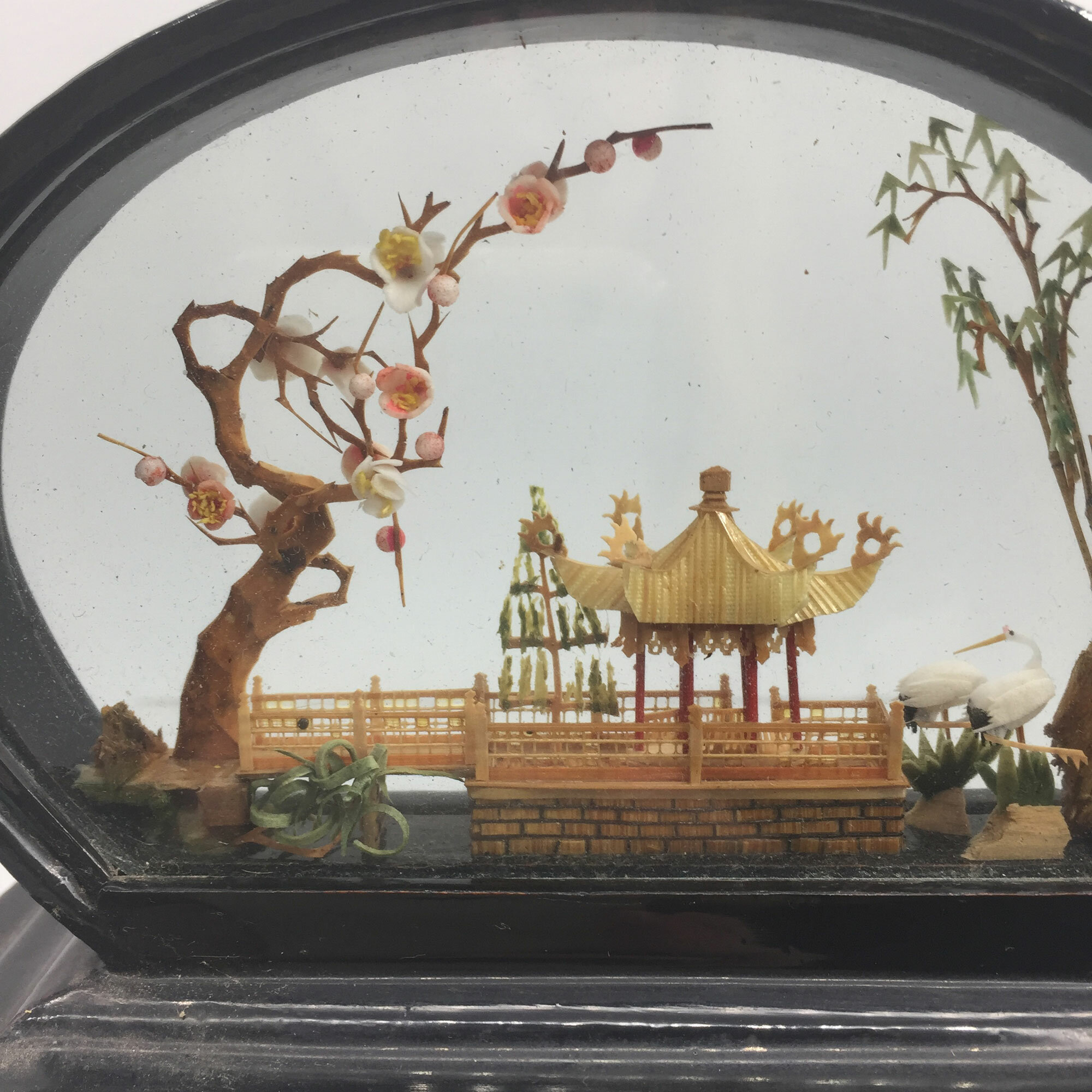
Lot of two vintage Chinese miniature Cork Groups
Price: £25
Very fine pair of vintage Chinese painted eggs in a pentagonal glass case
Price: £25
Unusual Chinese Bowl decorated in the Japanese Kutani Style, early 20th Century
Price: £45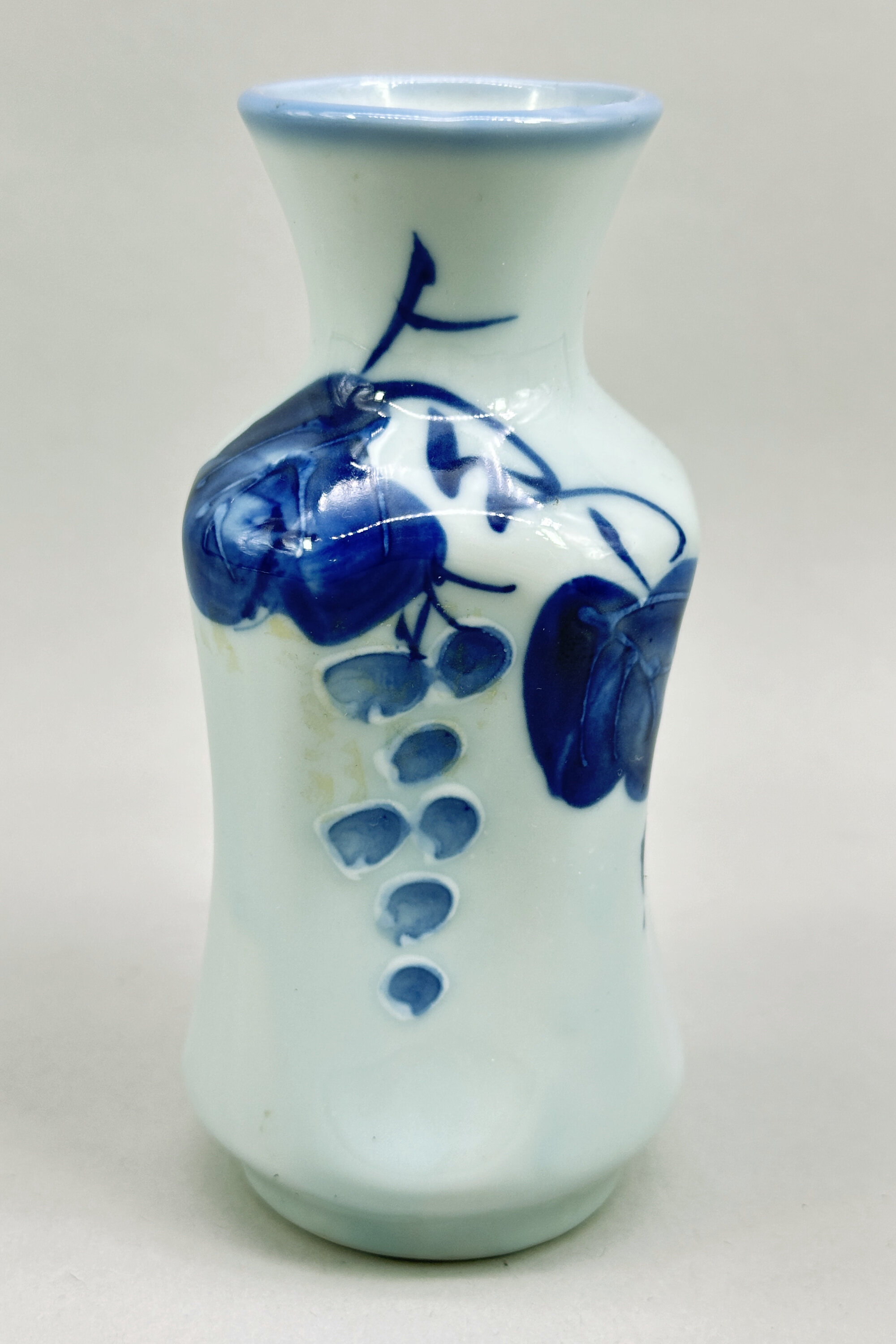
Fine Quality small Japanese Blue and White Vase, C20th
Price: £25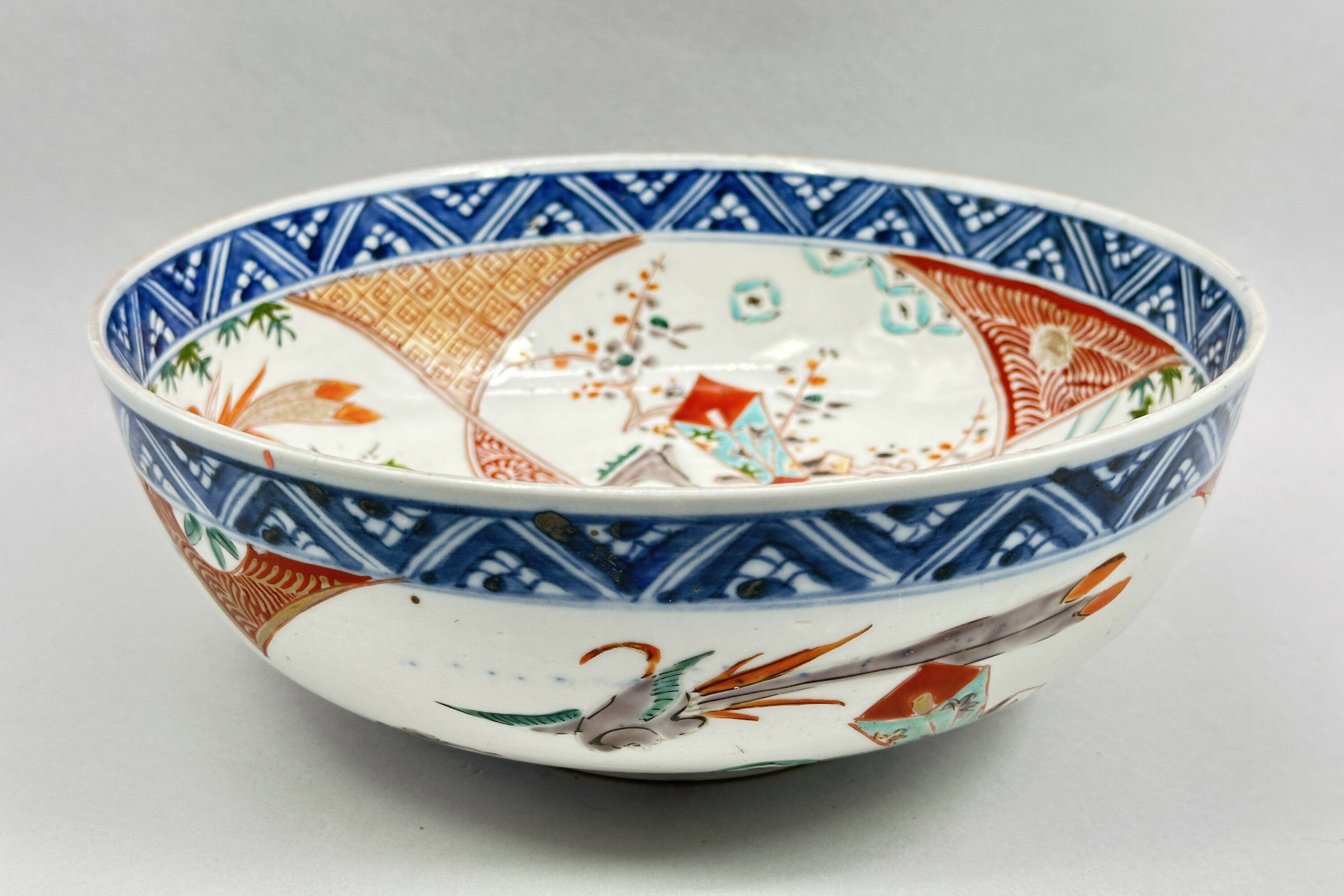
Japanese Arita Bowl decorated with Ho Ho Birds circa 1880
Price: £45
Chinese Blanc de Chine Figure of Guanyin, C20th
Price: £45The white glazed wares known as ‘Blanc de Chine’ are a well known feature of Chinese ceramic art. Pieces of this white ware originally came from the porcelain potteries in Dehua, Fujian province, north of the harbour city of Canton on the South Chinese coast. Eventually production was taken up by the kilns of Jingdezhen, the ‘ceramics city’ of China, but the clay used was rather different to that of Fujian and, when seen unglazed, has a rather ‘drier’ effect. Dehua Blanc de Chine tends to date to the eighteenth and nineteenth centuries or even before whereas the Jingdezhen productions mainly belong to the twentieth century but dating within that period is next to impossible. Quality was maintained even in ‘late’ pieces and the clay used was pretty consistent throughout the period.
Guanyin was the well known Goddess of Mercy and inspired a multitude of images in many art forms. She is often represented with lotus, as here, which is a Buddhist symbol of purity. The pose and modelling of this piece is little different to earlier examples but the paste of the foot indicates Jingdezhen work and the impressed numbers at the base, which seem to read ‘10’, imply a late twentieth century dating. Whether intended as a recreation or a reproduction it is hard to say but the workmanship is not so inferior that this figure cannot be enjoyed as a modest example of a quintessential Chinese ceramic genre.

Vintage Japanese Doll of a Hat Seller, C20th
Price: £25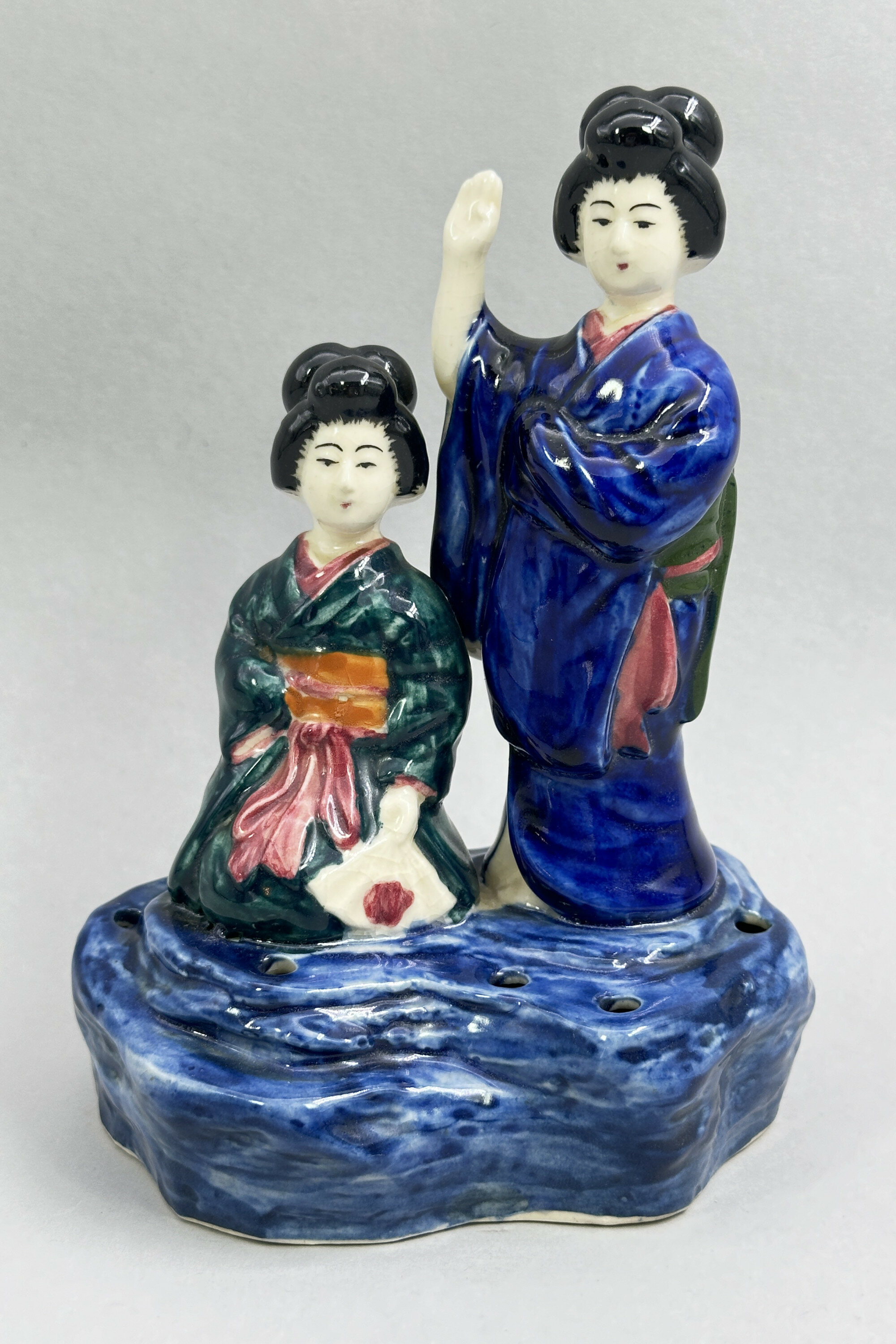
Japanese Ceramic Figural Group of two Geisha, late C19th
Price: £25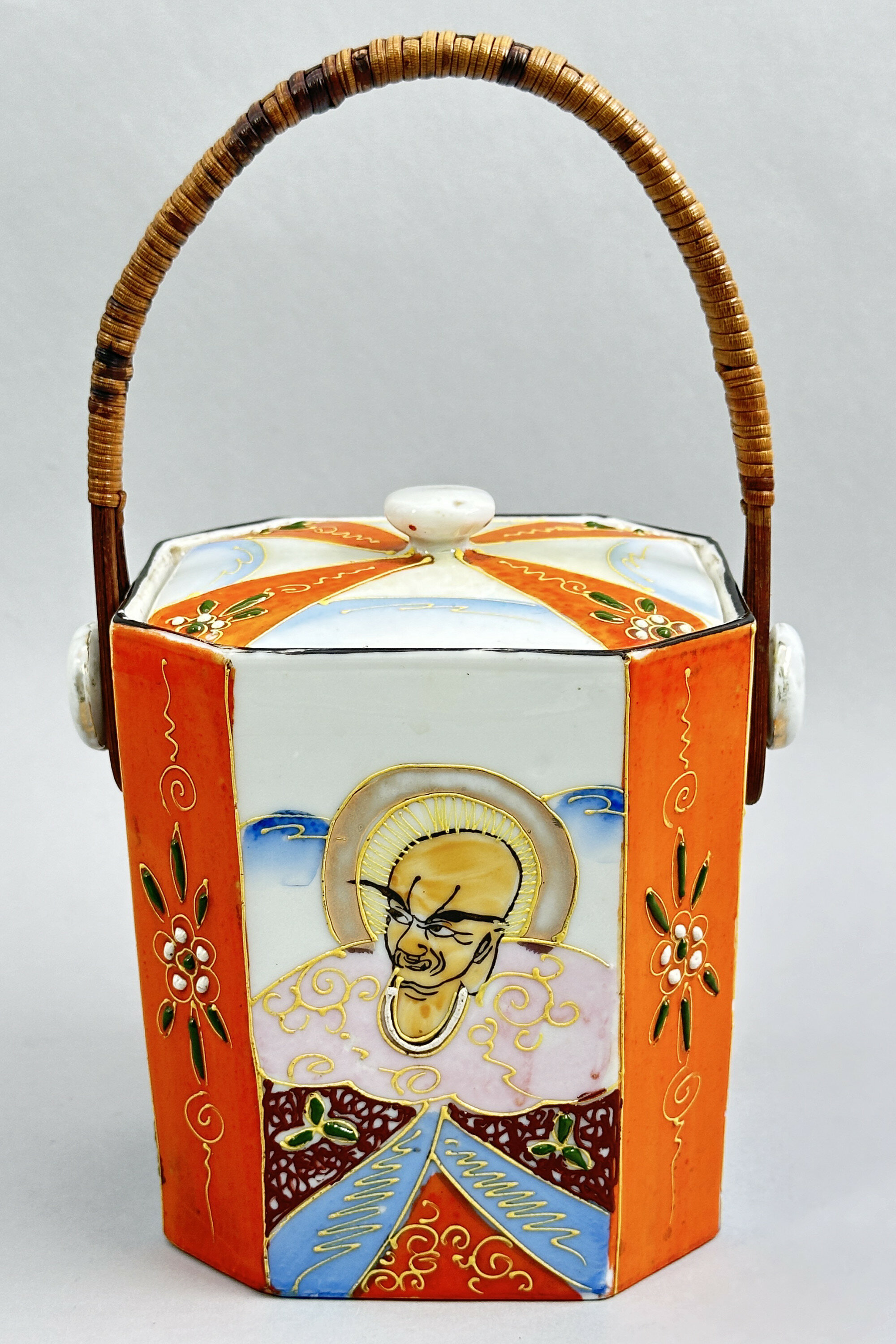
Japanese Samurai China Biscuit Box and Cover, C20th
Price: £25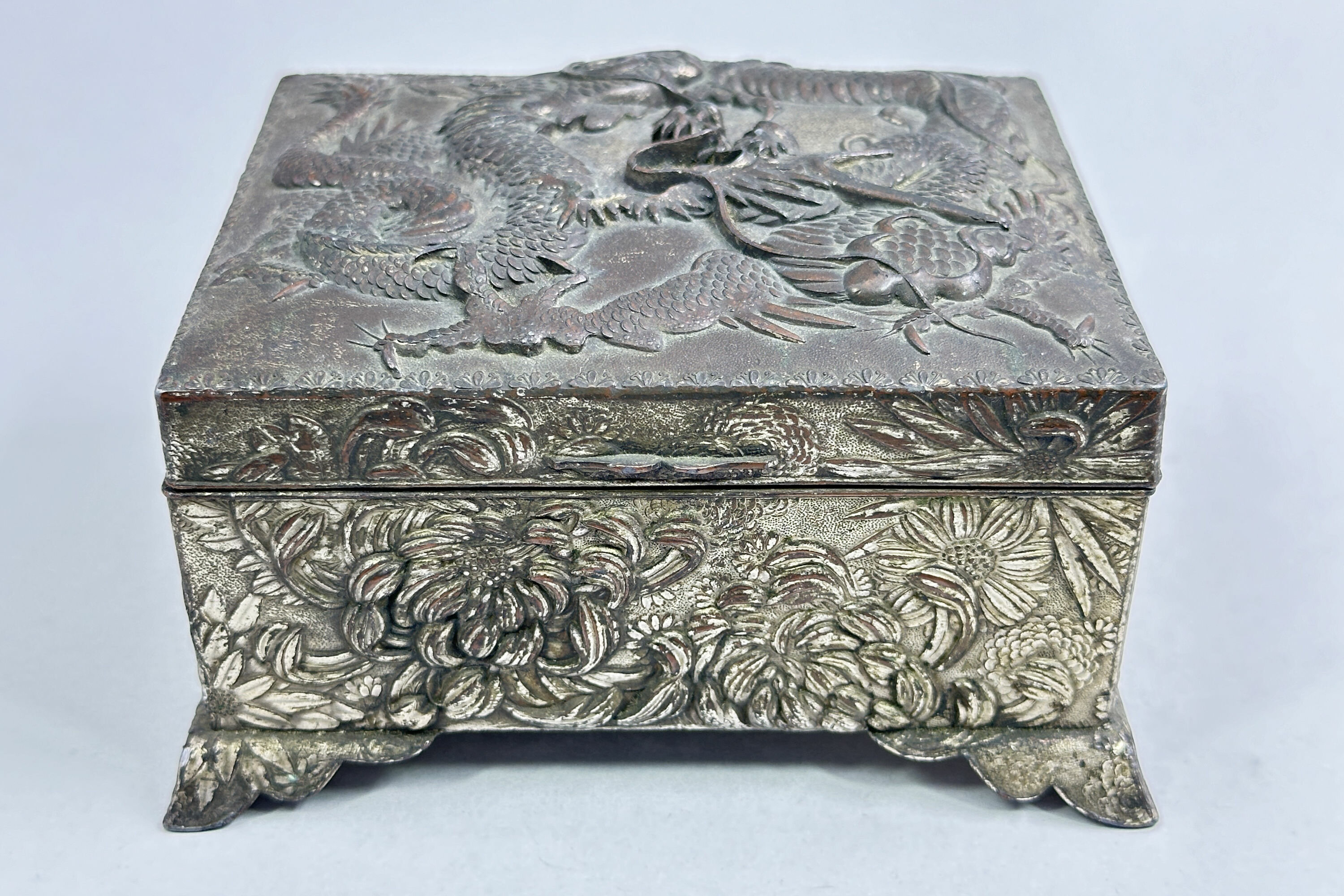
Oriental Silver Metal Box decorated Dragons and Chrysanthemum, C20th
Price: £25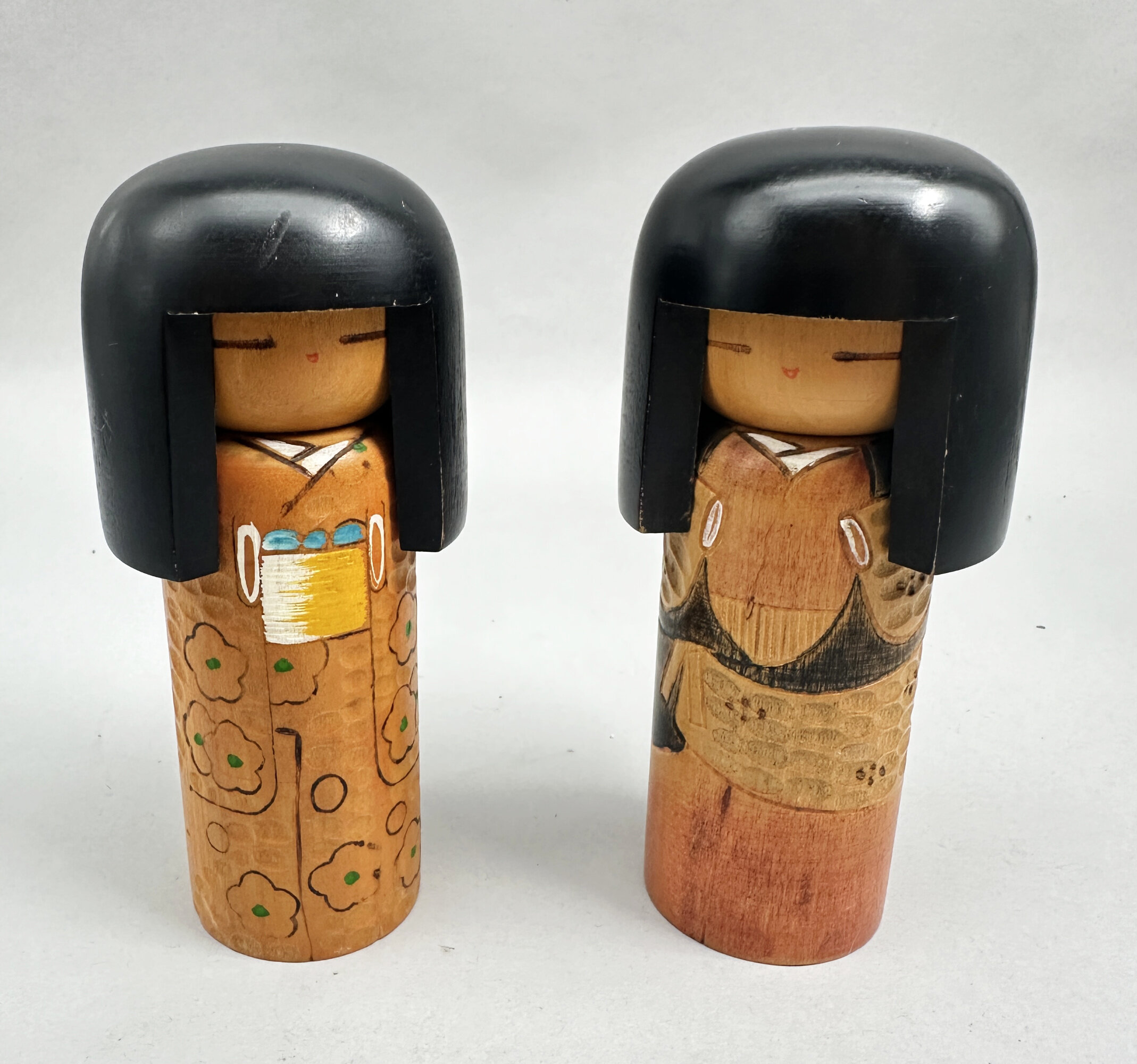
Pair of Vintage Japanese Kokeshi Dolls, signed, late C20th
Price: £25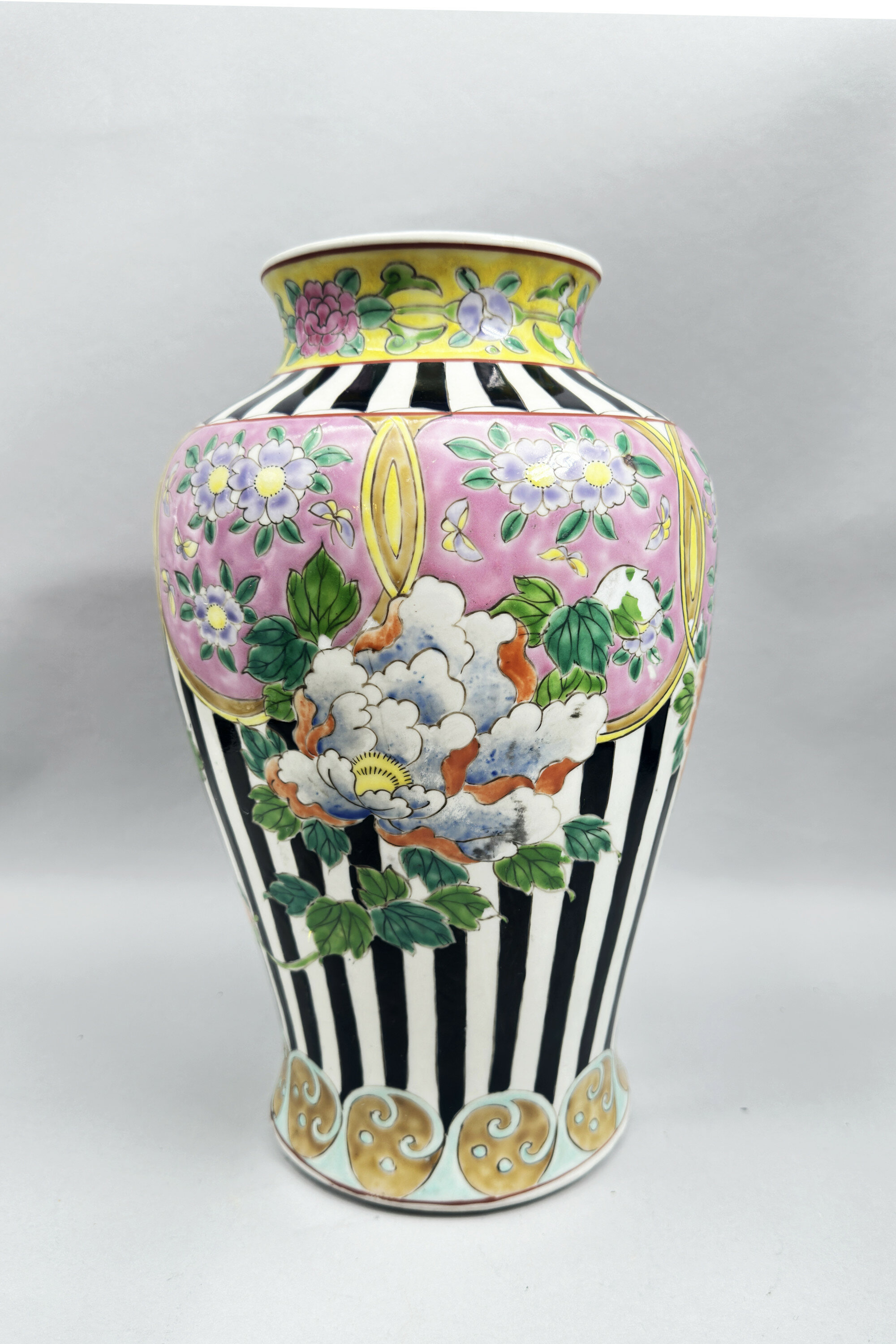
Japanese Arita Vase with Famille Rose Decoration and Black Stripes, early C20th
Price: £55In the late nineteenth century the Japanese potters at Arita turned their hand to producing pieces decorated in the Chinese ‘Famille Rose’ (rose family) palette. These were surprisingly effective and have sometimes deceived later collectors, mistakenly believing them to be Chinese. The decoration here is typical of the style but the striped ground is most unusual giving the piece a much more ‘modern’ appearance. Dating is pretty clear though. The stamped ‘Nippon’ (Japan) mark was used from around 1890 to the early 1920s. From 1891 imports to America were required to be marked with the country of origin, in western characters. Thus Japanese exports to America were marked with ‘Nippon’ in English from this date to 1922, when the requirement was changed so that the word ‘Japan’ should be used. Other countries had importing requirements too and the presence of ‘Nippon’ here is a pretty accurate pointer to the early C20th which is consistent with both the style of decoration and the paste of the foot. The unglazed top suggests that this vase originally had a matching lid. This has gone and, of course, the vase was later used as a lamp base and drilled accordingly. If reused now in the same way it would be a striking and individual lighting feature.
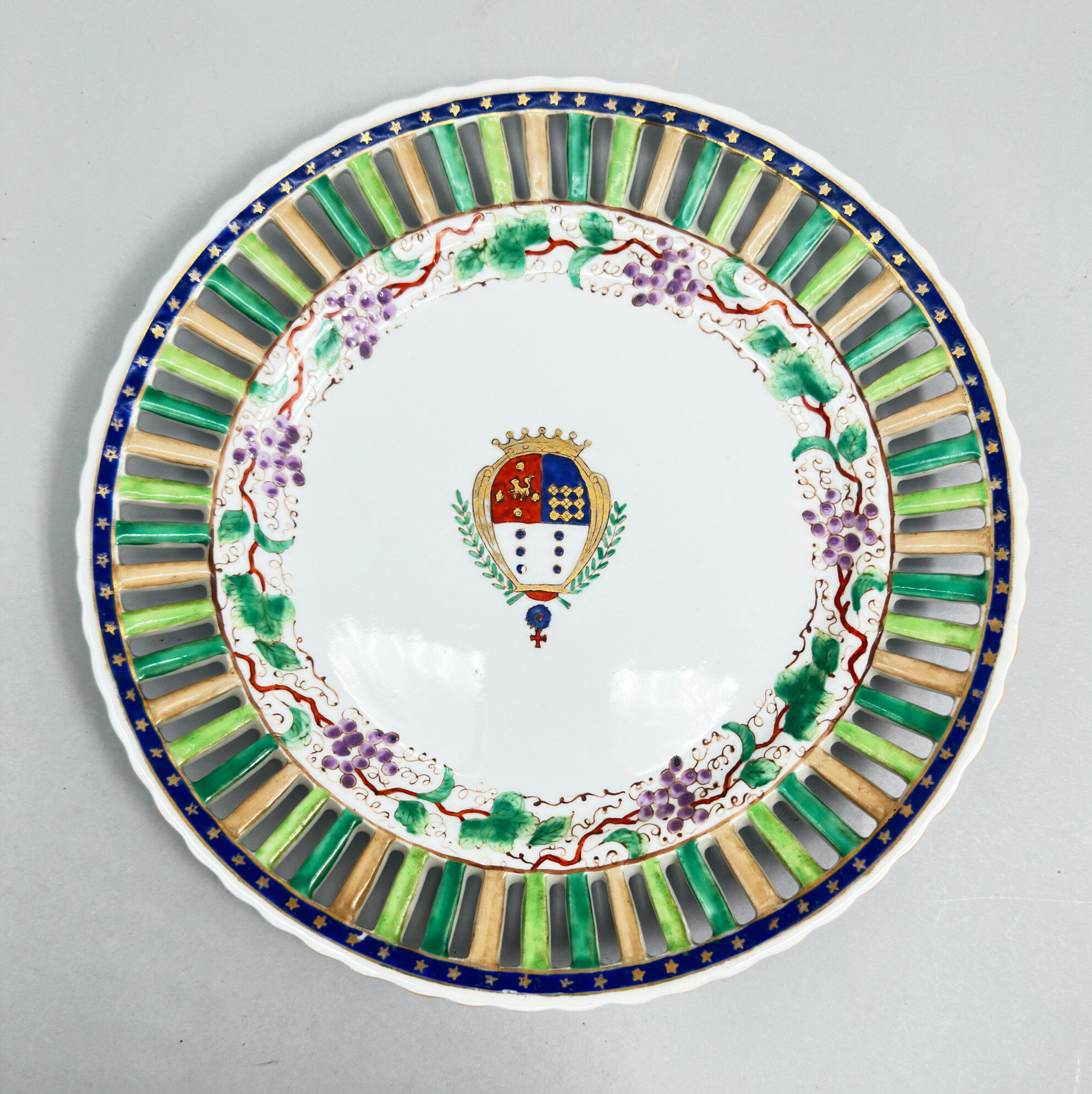
Compagnie des Indes style reticulated edge Armorial Plate, Chinese C20th
Price: £45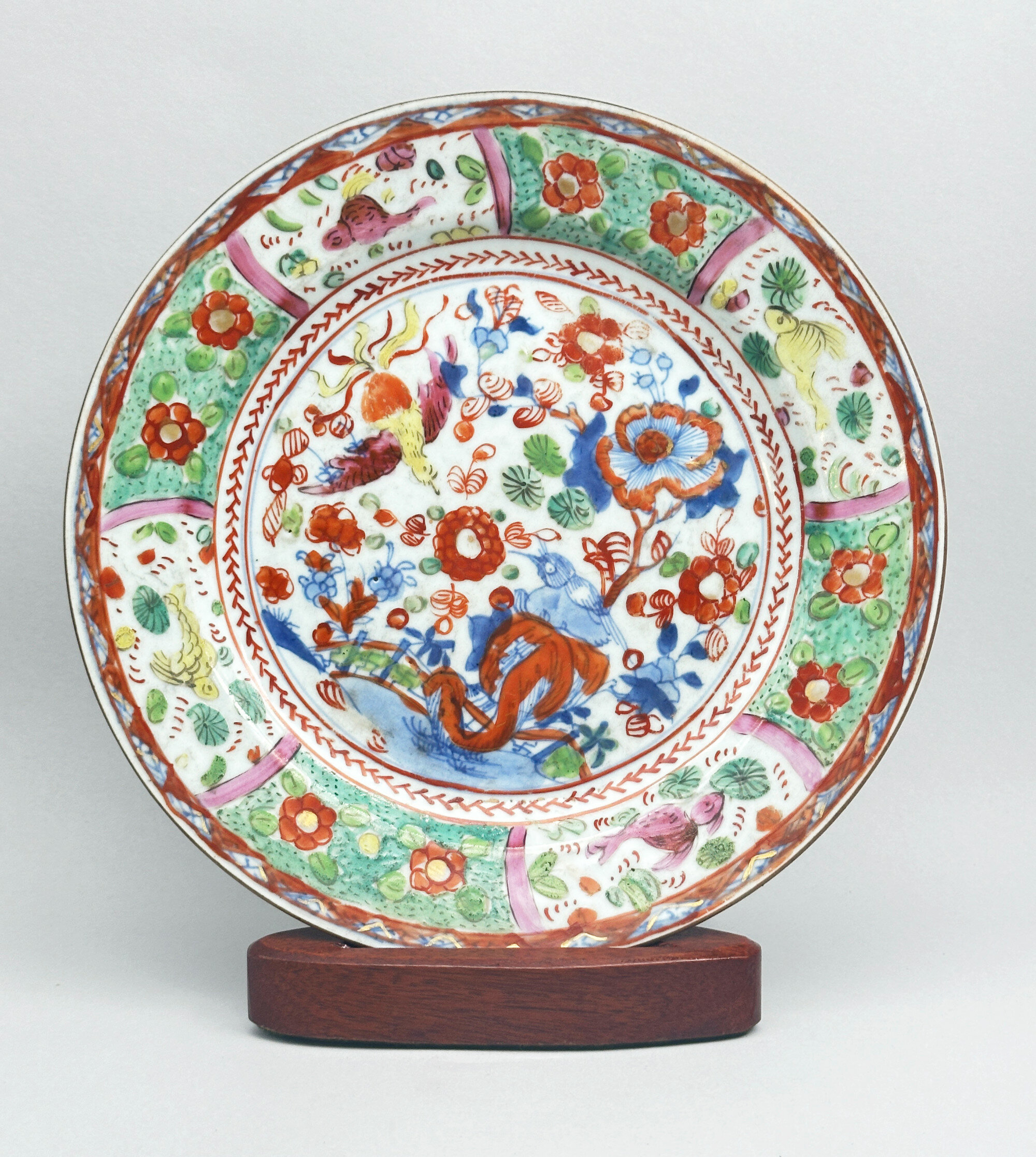
Chinese Export Blue and White Plate with Clobbered Decoration, circa 1780
Price: £75The demand in Europe for polychrome wares from China and Japan was sometimes greater than the supplies sent over and this was remedied on occasion by a second firing on arrival or later to add the colouration desired. The additional enamel decoration would fire at a much lower temperature than the original blue and white so the process was quite safe. The main exponents of the technique were based in Holland and England, often operating as quite small concerns, and there is considerable variation in the quality and style of the decoration they applied. At its best, as here, it can have a naif charm of its own. From the middle of the nineteenth century in England such pieces began to be referred to as ‘clobbered’, a word derived from ‘clobber’ which originally referred to shoe and then clothing repair work. The form and foot rim of this plate allows a secure dating to the late Qianlong period (1736-1795) and the decoration was probably applied in Holland not so long after. By 1900 its use to describe these hybrid porcelains was common and has remained so ever since. The wares are not ones for purists but for those who enjoy a bit of whimsy in a decorative style which is certainly the case here!
Please note that the wood stand is for display purposes only and is not incuded with this lot.
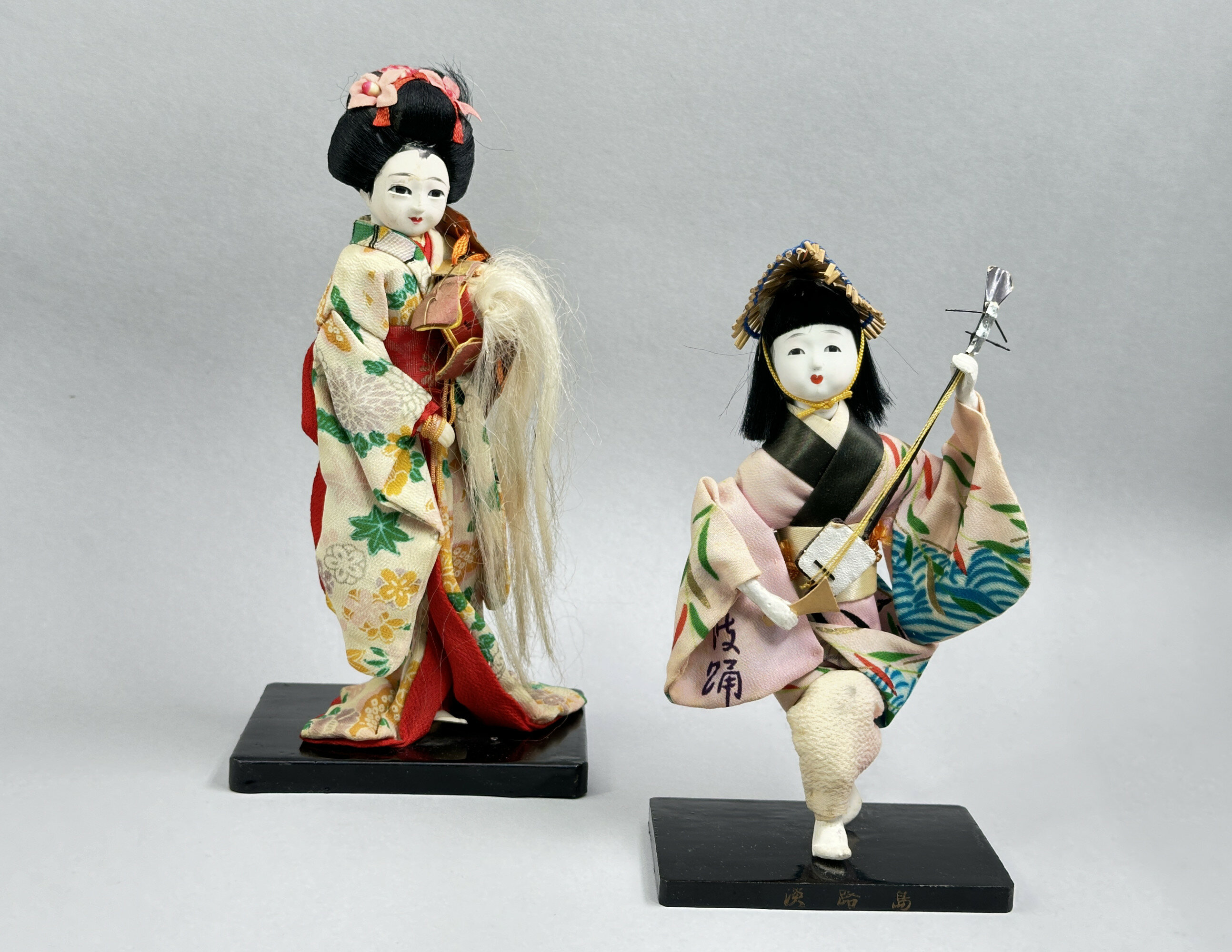
Two Vintage Japanese Geisha Dolls, C20th
Price: £25
Chinese Cloisonné Bowl with a wavy edge, 20th Century
Price: £25
Chinese Mandarin Pattern Saucer circa 1780
Price: £45This is a typical example of the ‘Mandarin’ pattern produced by the Chinese in the late eighteenth century for export to the West where it enjoyed great popularity. The name derives from the male court figures, mandarins, who form such an important component of the designs. The scenes are carefully composed with much charm and rendered in a wide variety of coloured enamels with much emphasis on deep pink (‘Famille Rose’) and iron red. A wide variety of wares were produced in the pattern including vases, bowls, dinner services and tea sets, as here, where there would have been a set of bowls and saucers along with matching serving items. The charm and quality of this piece speaks for itself and presents an excellent and collectible example of this opulent pattern from the eighteenth century.
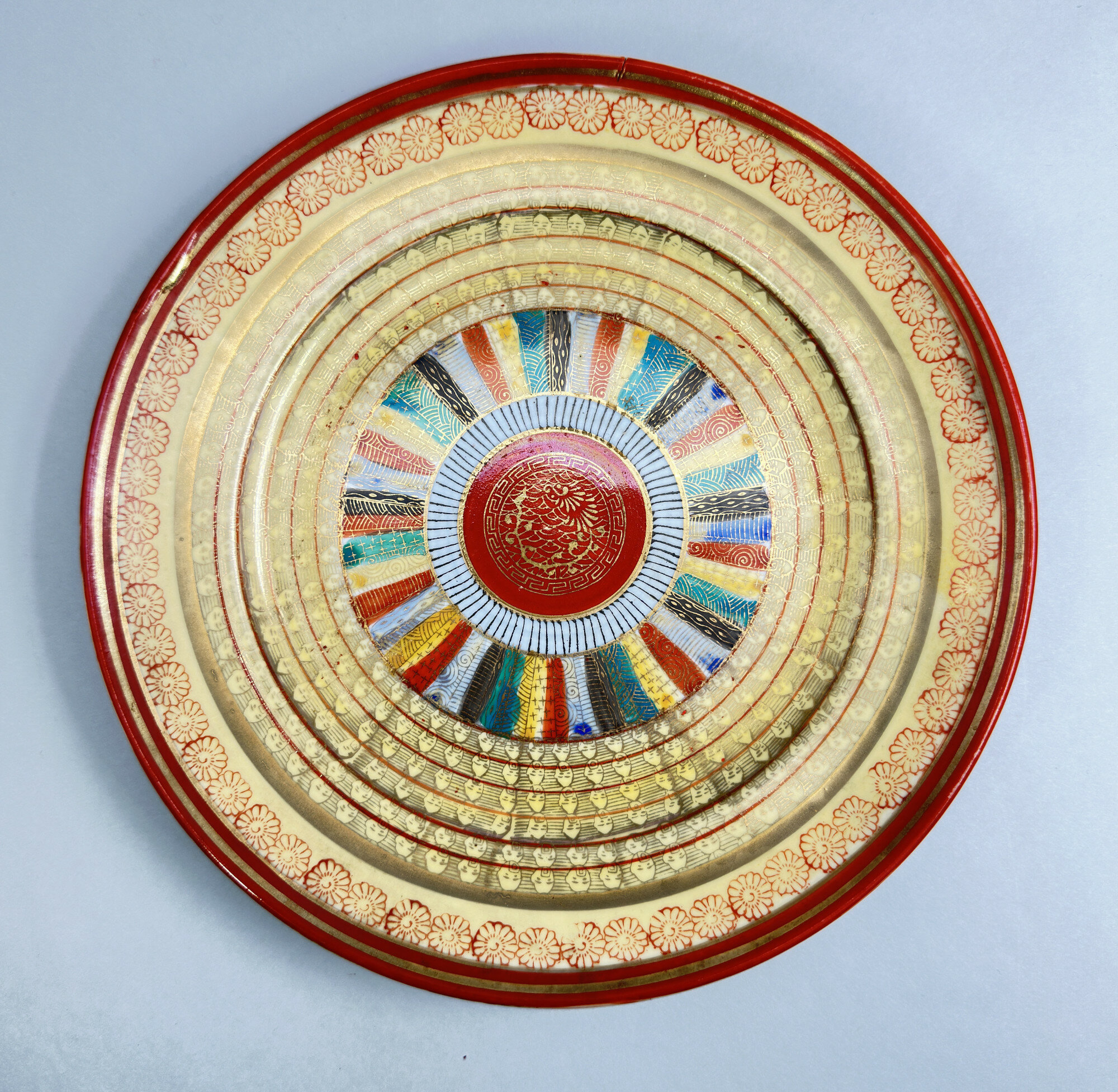
Japanese Kutani Dish decorated with the Thousand Faces pattern, first half C20th
Price: £45The colourings and style of work here clearly indicate the workshops of Kutani (the word means 'nine valleys') in the former Kaga province of Japan. By the nineteenth century the majority of their pieces were decorated in iron red and gold but sometimes with other colours in addition, as here. The ‘thousand faces’ pattern (an apocryphal term and this cataloguer has not attempted to count the number of faces appearing here) seems to have been evolved around the end of the nineteenth century and then continued in production until the mid twentieth. Both plates in various sizes and even tea sets are found in the design. The mark ‘Made in Japan’ was usually employed after 1941 (in the previous twenty years ‘Japan’ was the norm) but there are exceptions and the paste of the foot rim here does suggest a slightly earlier date, perhaps around 1930. In perfect condition, with very little wear to the decoration, this piece is a fine example of a rather eccentric decorative patttern.
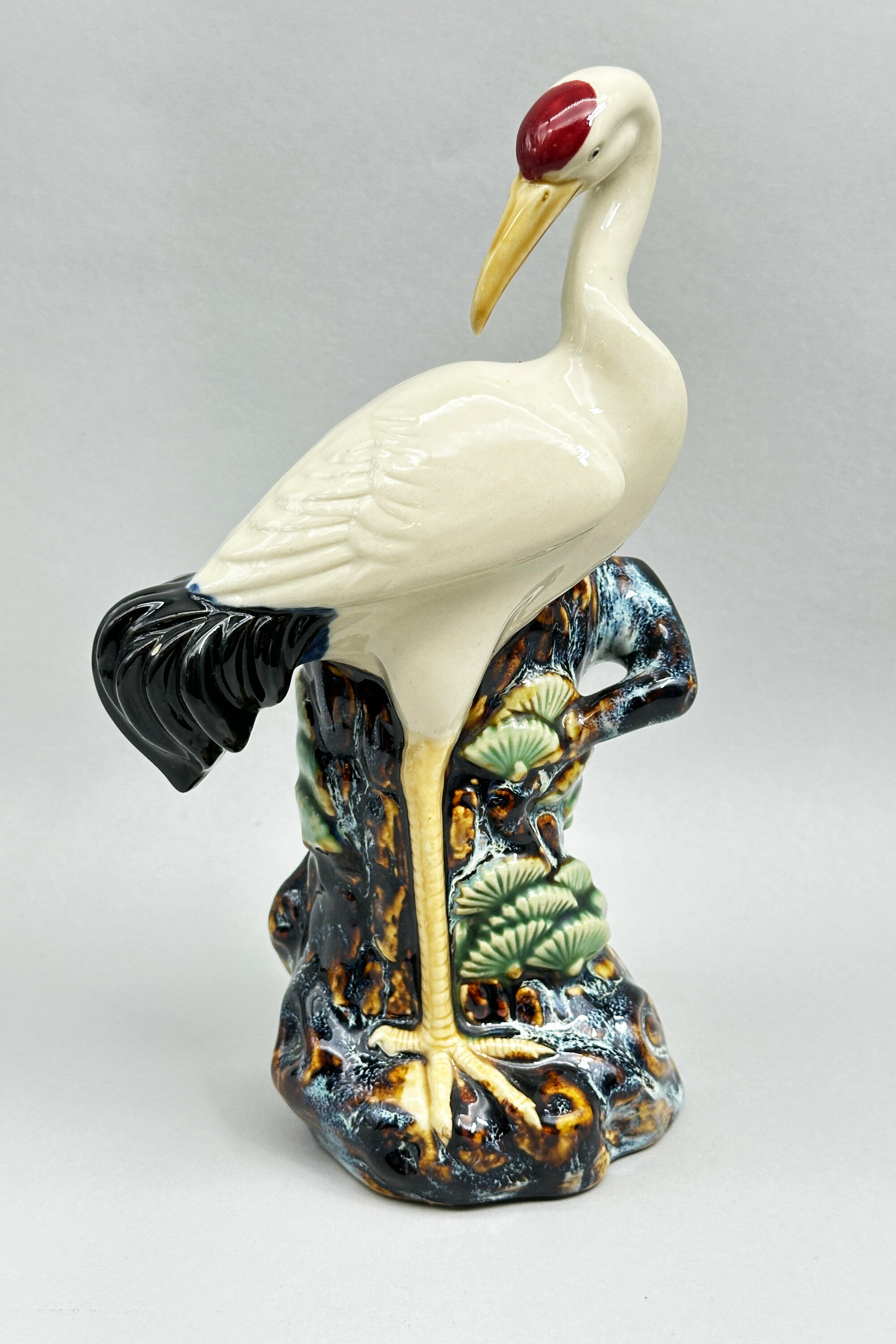
Chinese Majolica Style Brush Holder modelled as a Crane, mid C20th
Price: £25
Chinese small Blue and White and Copper Red Bottle Vase, late C20th
Price: £25Underglaze copper red was first developed in China in the north-western Chinese province of Shaanxi during the Tang dynasty (618 – 907) and continued in production during the Yuan, Ming and Qing dynasties. But working with copper oxide as the colouring agent was notoriously difficult with little guarantee of success when the pieces were fired. Often the finished colour more resembled a dull grey or even brown. There were, though, many successes and such pieces were highly prized, sometimes forming part of the ‘imperial’ ware produced for the Emperors (see image 6 : Kangxi Mark and Period). More modern techniques allowed the colour to be produced more easily and this piece, while a very recent example, actually displays it rather well. The quality of the potting and painting is excellent but the paste of the foot betrays fairly recent manufacture at Jingdezhen, probably not much before the beginning of the current century. On the other hand the purchase price is much more modest than that of its forebears!
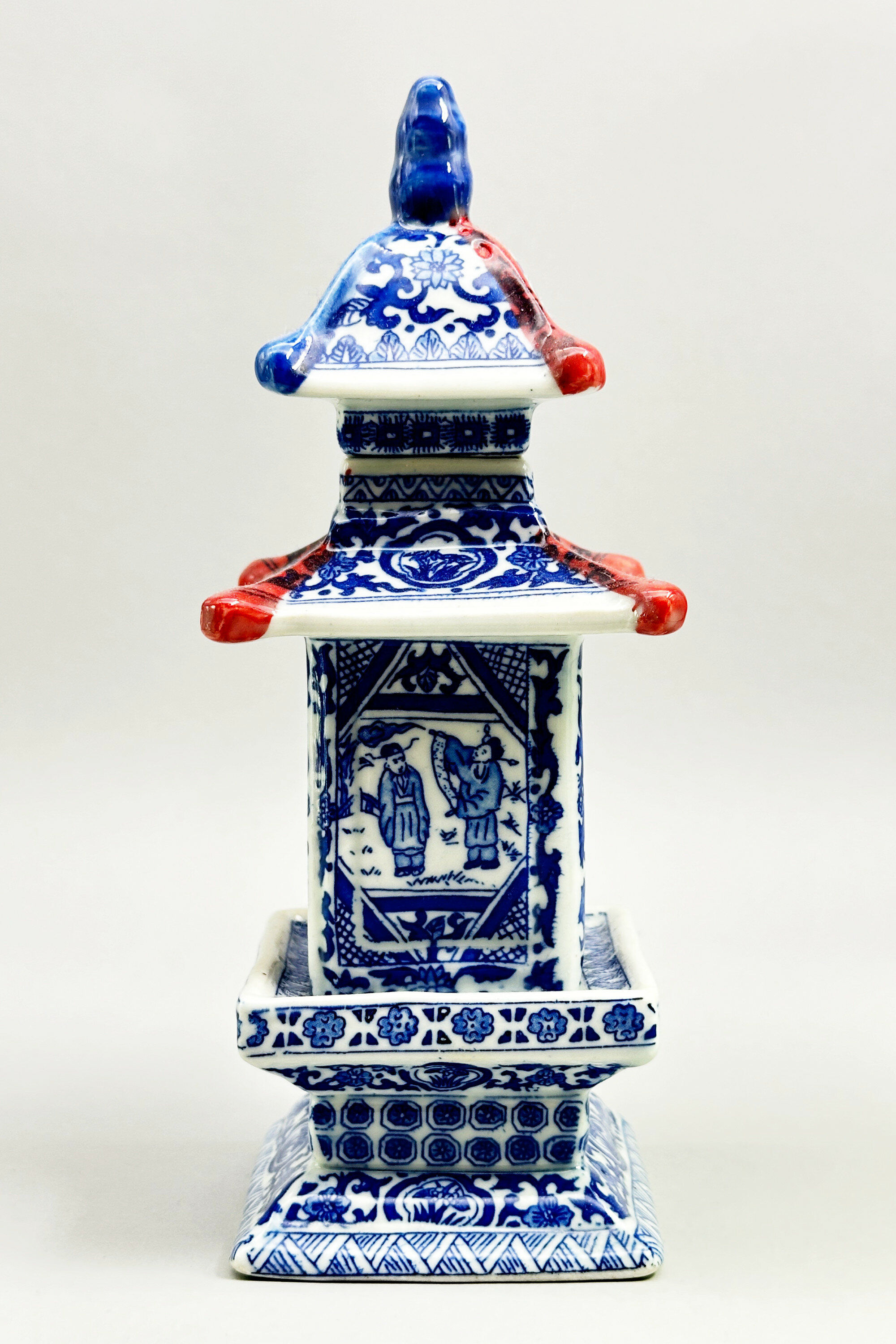
Chinese Blue and White Vase and Cover in the form of a Pagoda, end C20th or later
Price: £30
Chinese porcelain Plate in the Mille Fleur Pattern, Qianlong Mark, mid C20th
Price: £45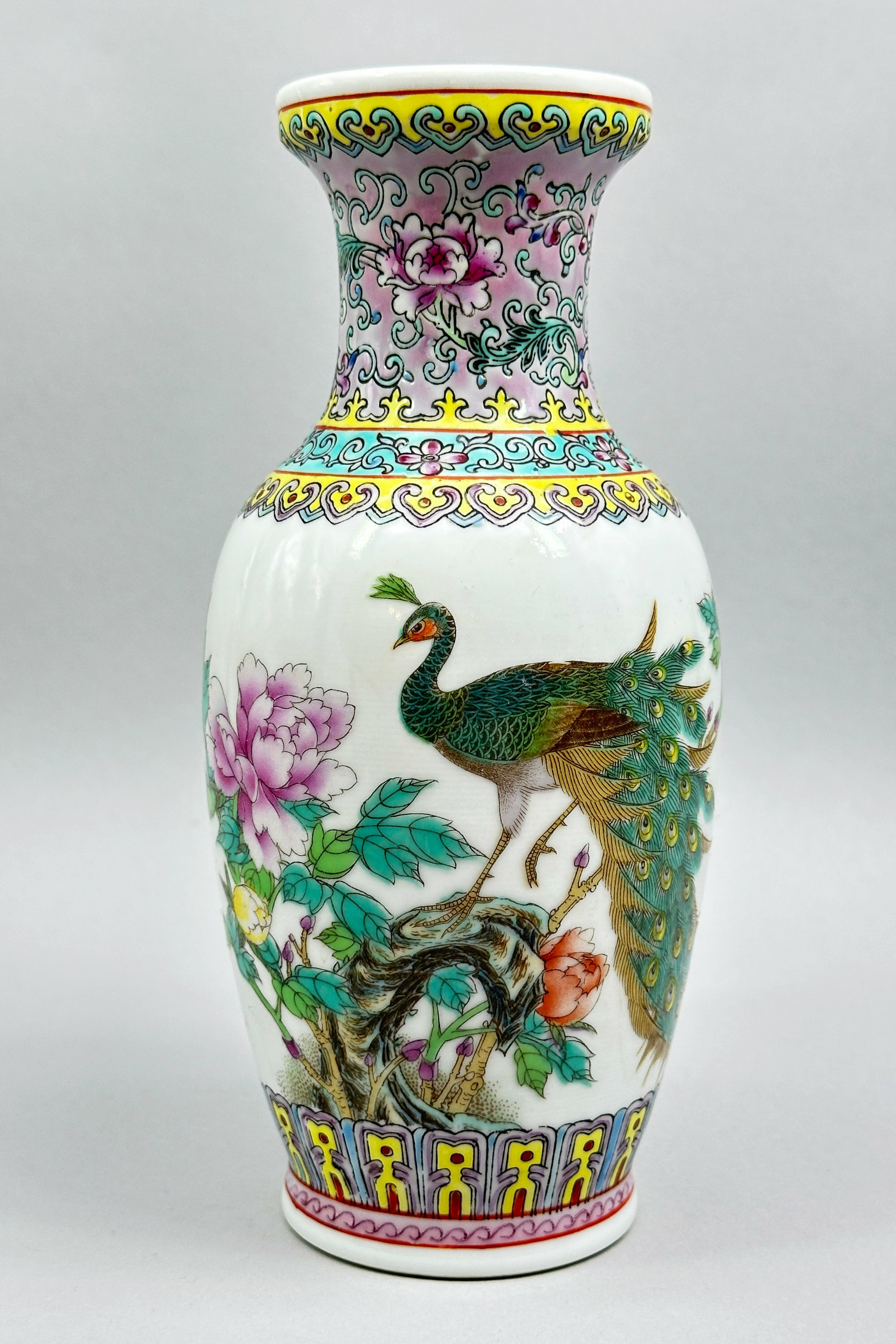
Chinese Famille Rose Vase decorated Peacock and Flowers, Jingdezhen mark, late C20th
Price: £25
Two Vintage Japanese Kokeshi Doll Groups, C20th
Price: £25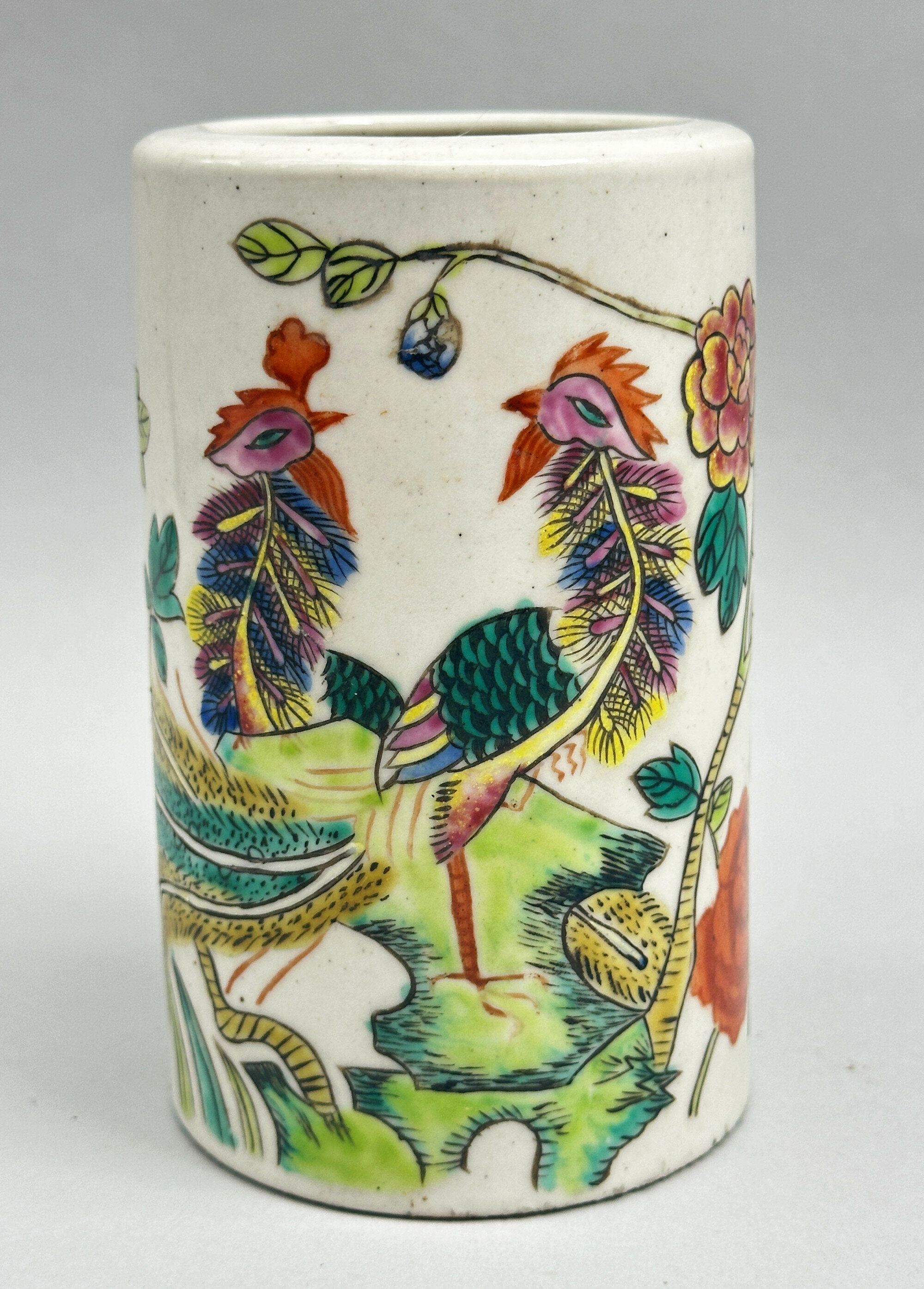
Chinese Famille Rose Brush Pot (bitong) decorated Phoenix, late C19th
Price: £45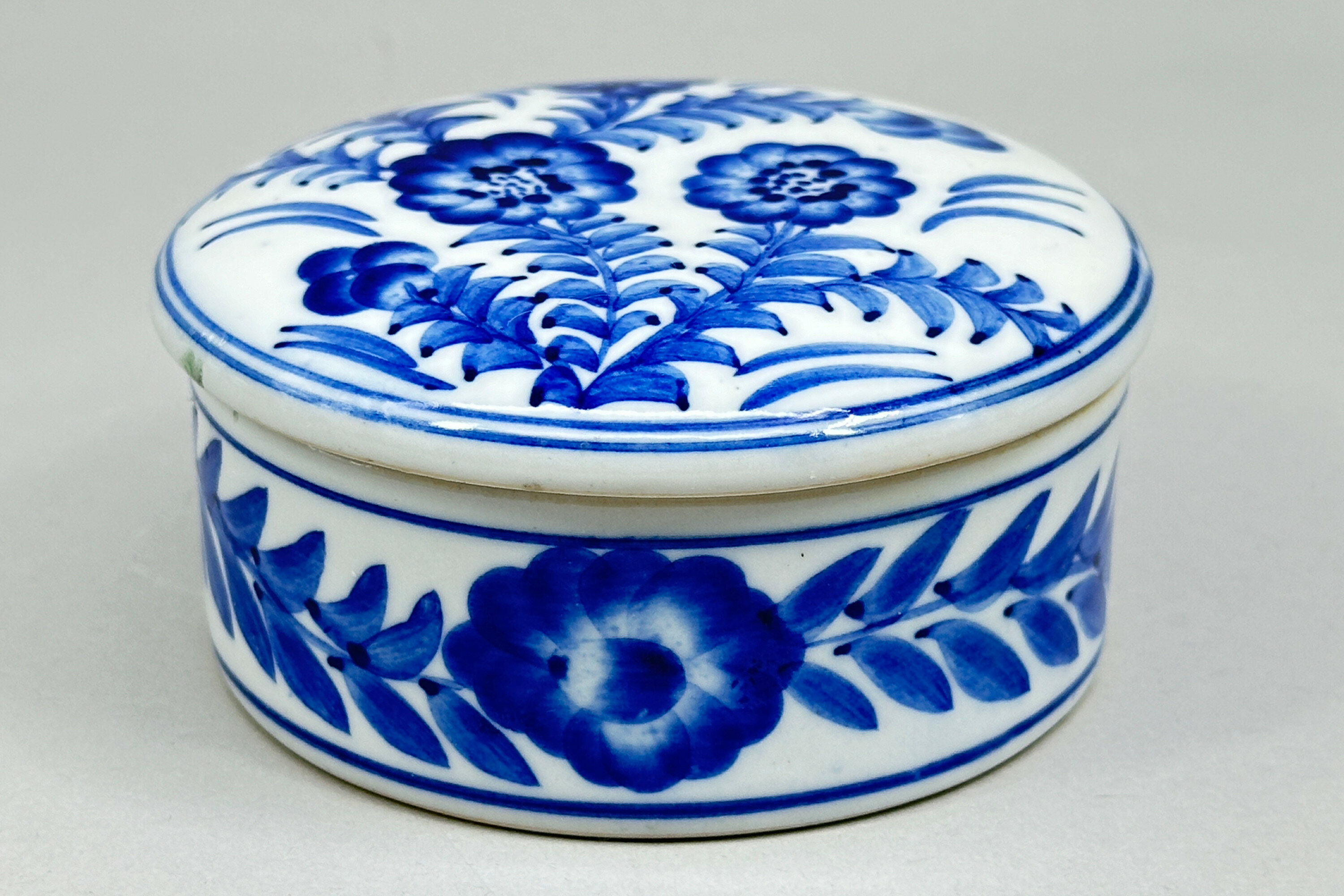
Chinese Blue and White Powder Box and Cover decorated Lotus, mid C20th
Price: £25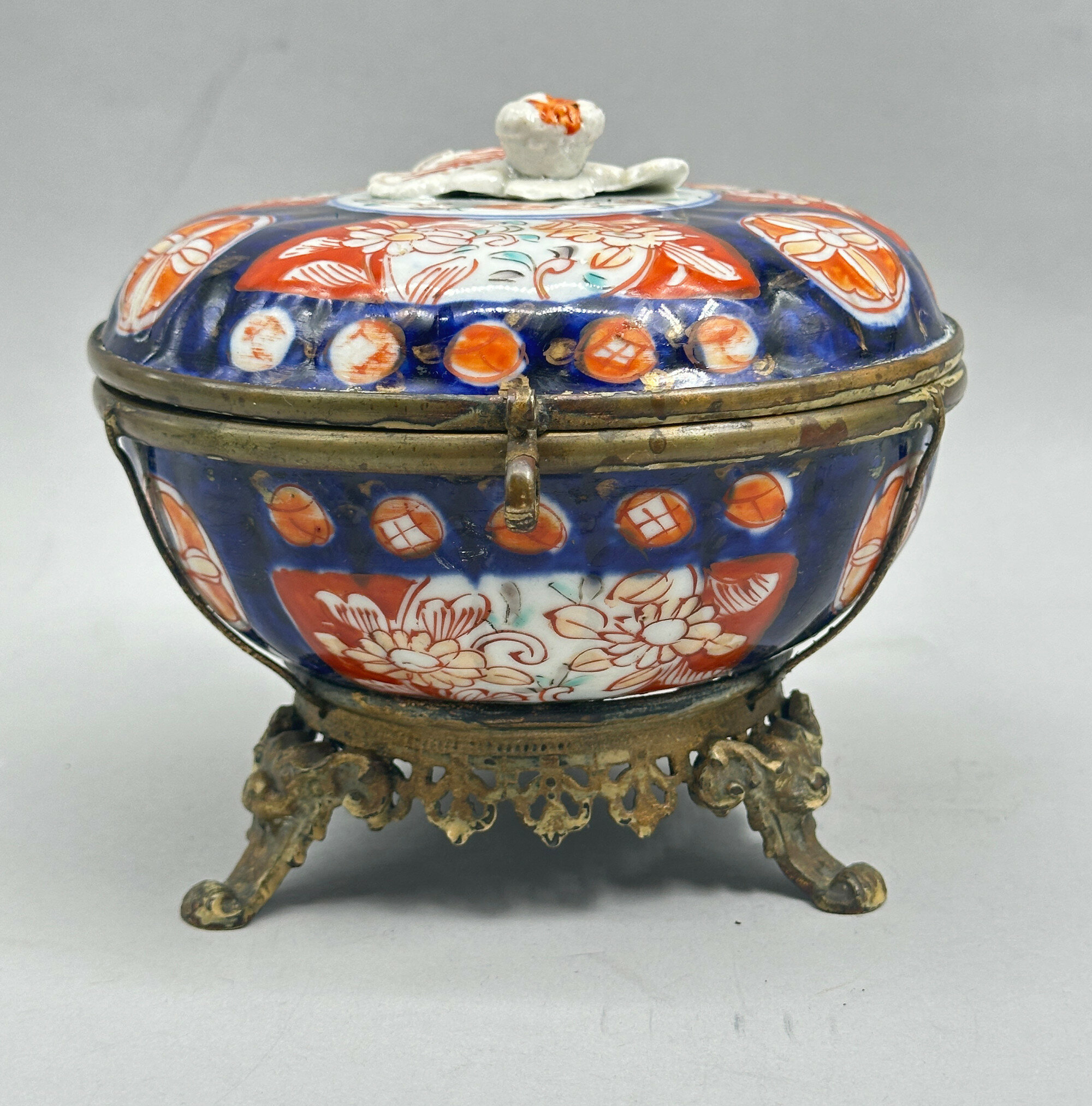
Gilt Metal Mounted Japanese Imari Box and Cover, late C19th
Price: £45Considerable care was taken to adapt this quite modest piece of Japanese export ware to what was presumably an addition to a boudoir dressing table. Evidently the original was felt by its owner to be a bit too plain and some enhancement was requested. The metal work is probably continental, perhaps French, and the hybrid result retains nevertheless a degree of provincial charm.
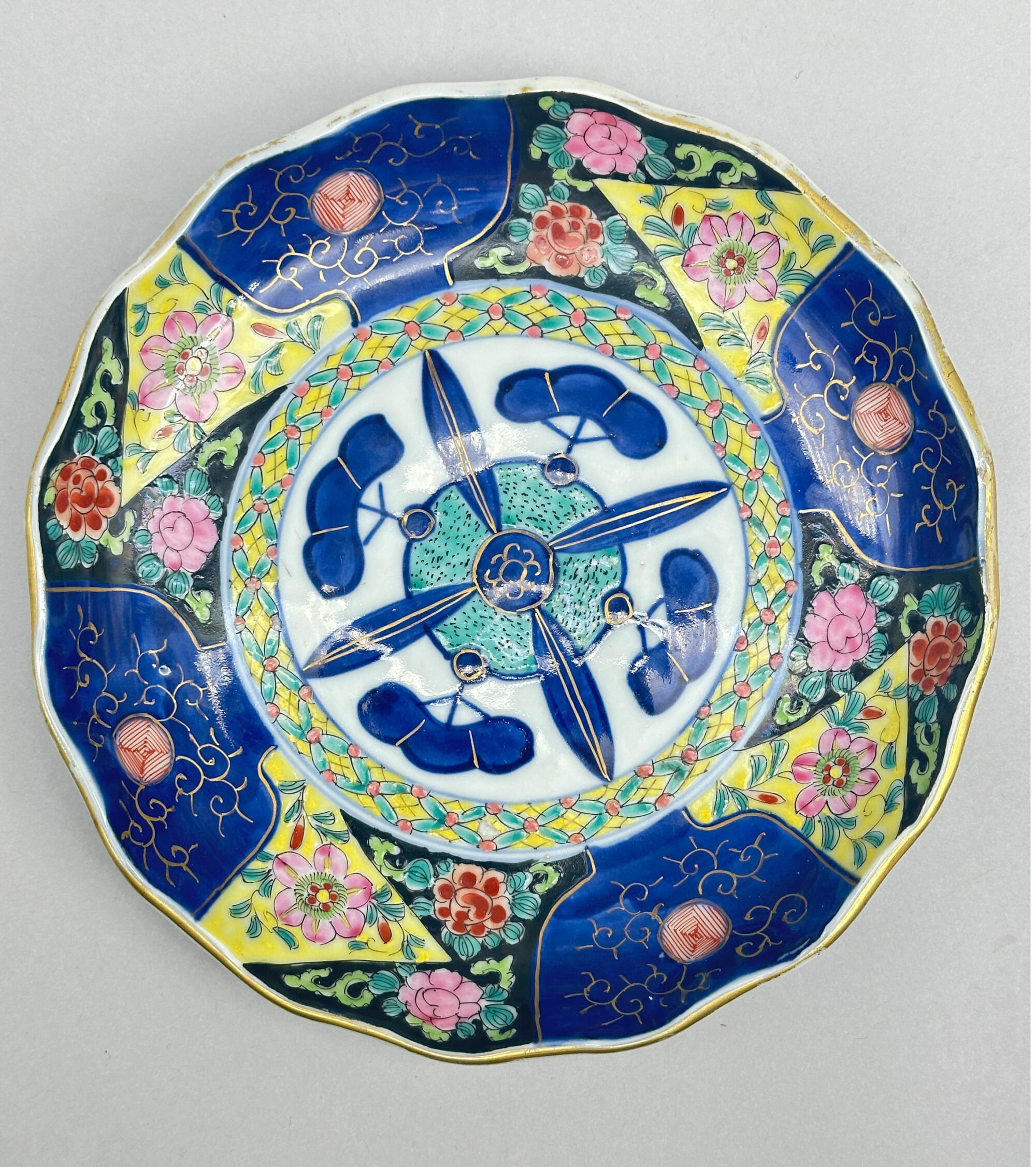
Japanese Arita Plate with Famille Rose Decoration, late C19th
Price: £45Ceramics decorated in the Chinese ‘Famille Rose’ palette were exported by Japan in the late nineteenth century and are sometime confused with their counterparts but there is nothing ‘Chinese’ about the decoration here and the range of colours, the irregularly shaped panels and the striking use of the underglaze blue ground are distinctively ‘Japanese’ and quite arresting in their effect.
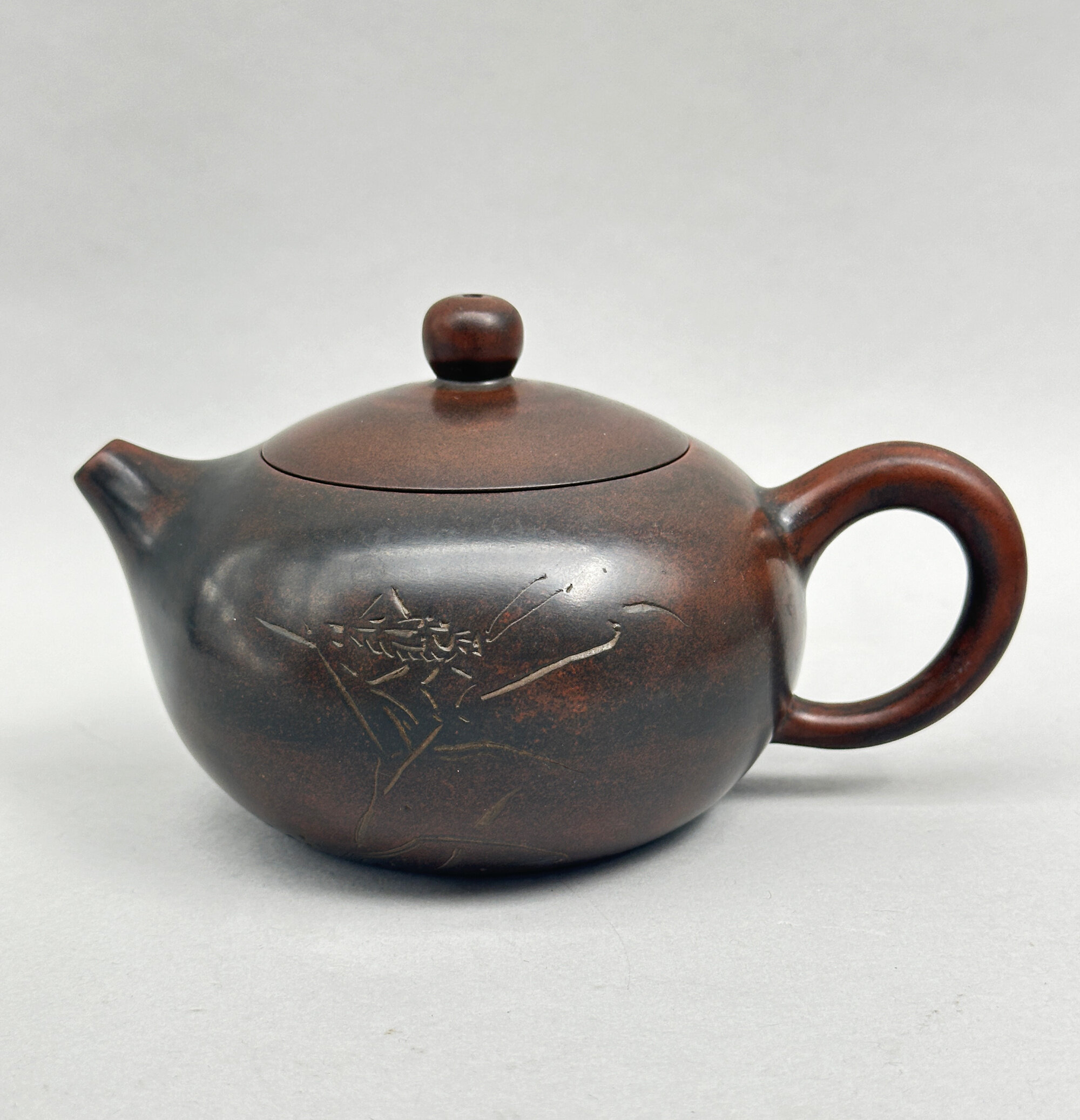
Fine Quality Japanese Yixing style Teapot decorated locust, signed, mid C20th
Price: £95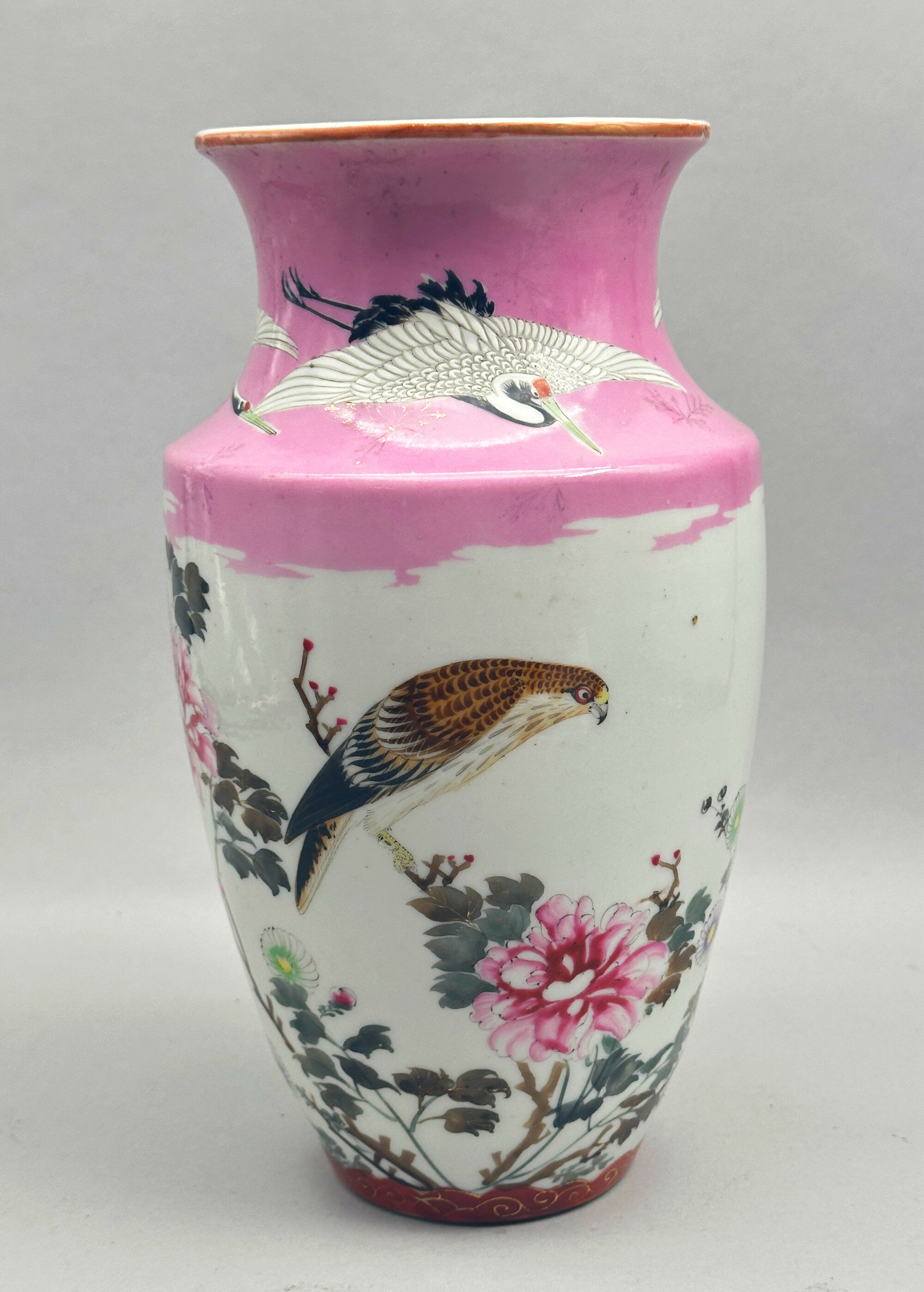
Unusual Japanese Kutani Vase with Pink ground, late C19th
Price: £75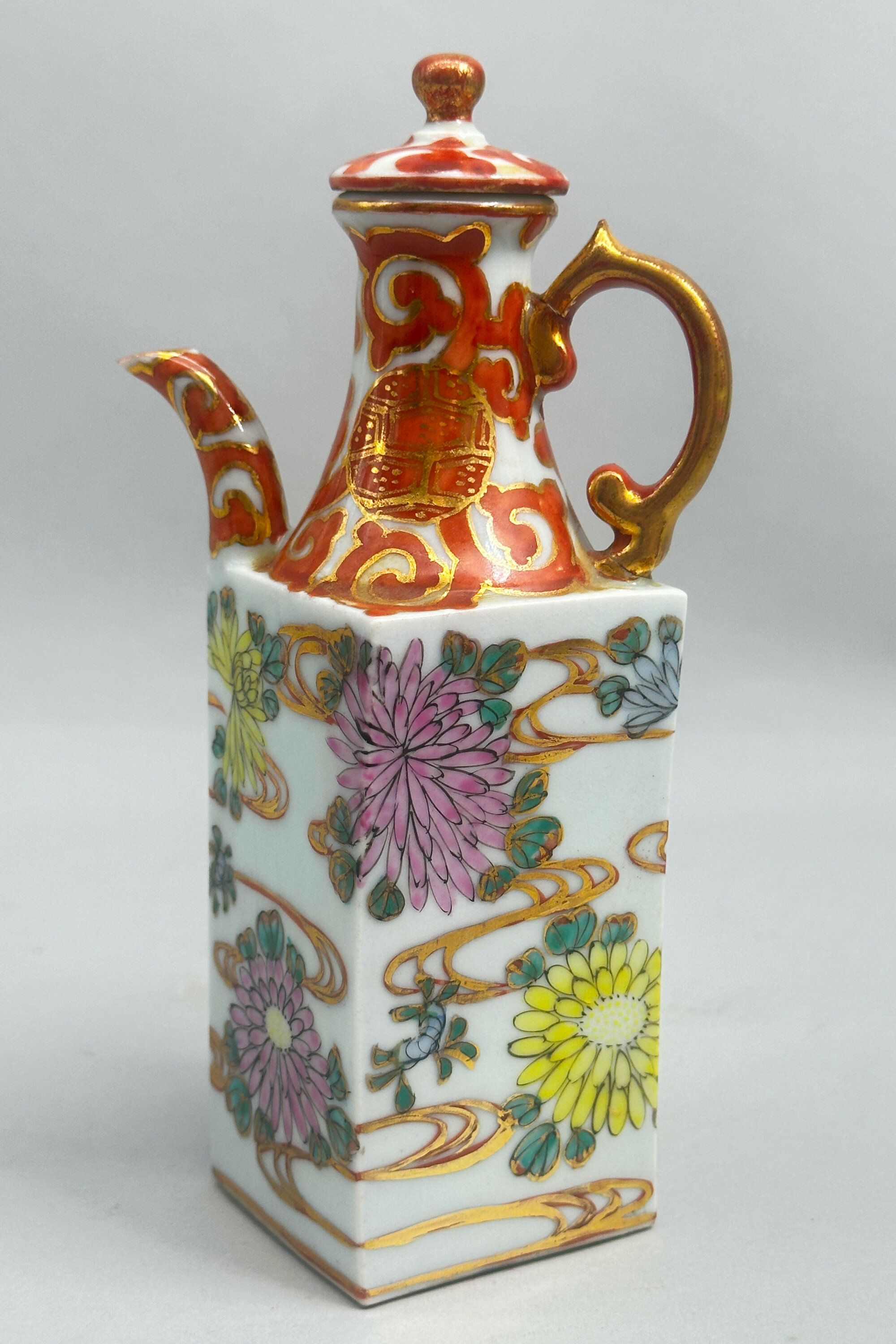
Japanese Arita Square Sake Flask and Cover decorated flowers, C20th
Price: £25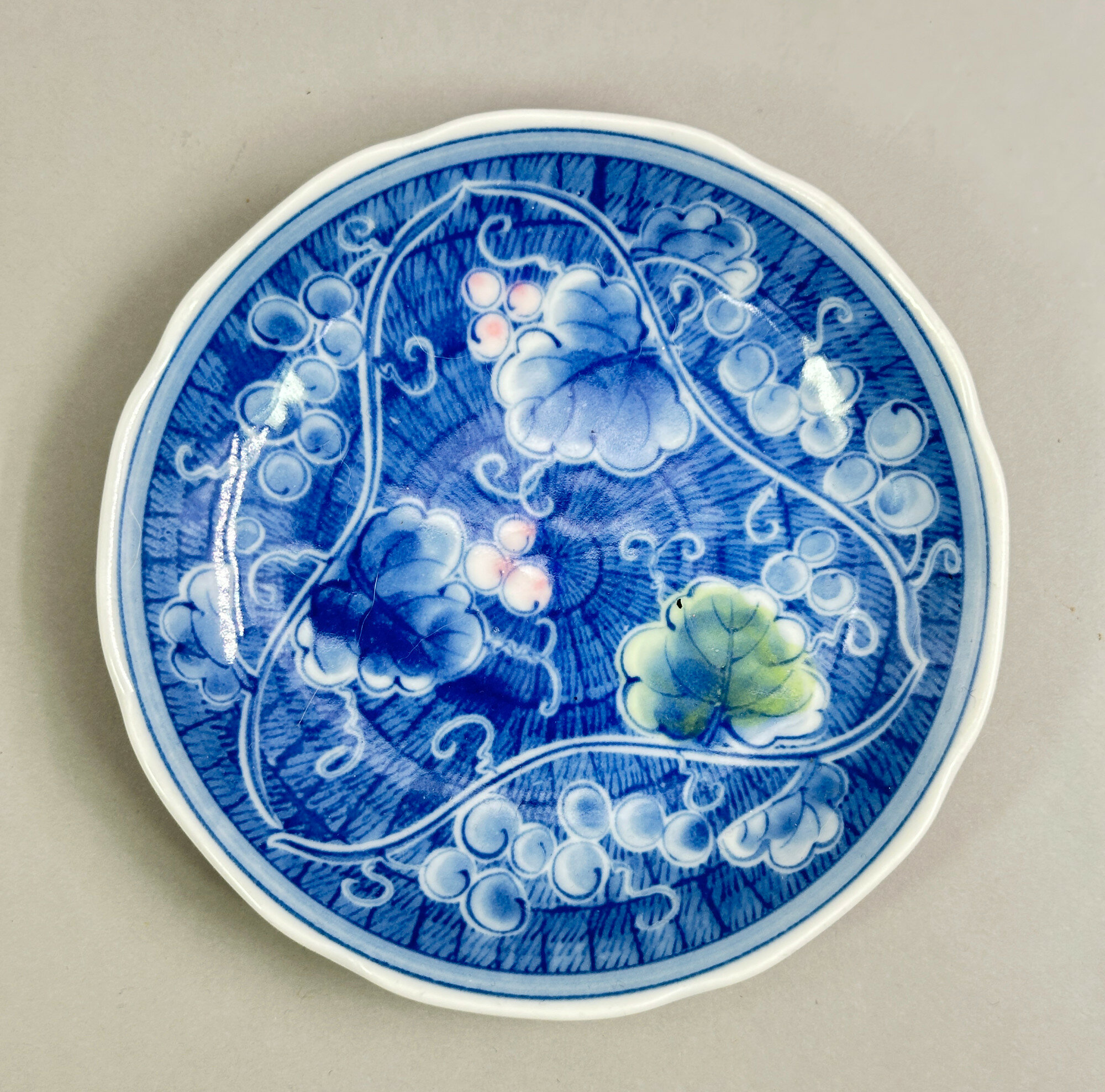
Japanese Arita Blue and White Saucer decorated Gourd and Grapes, mid C20th
Price: £15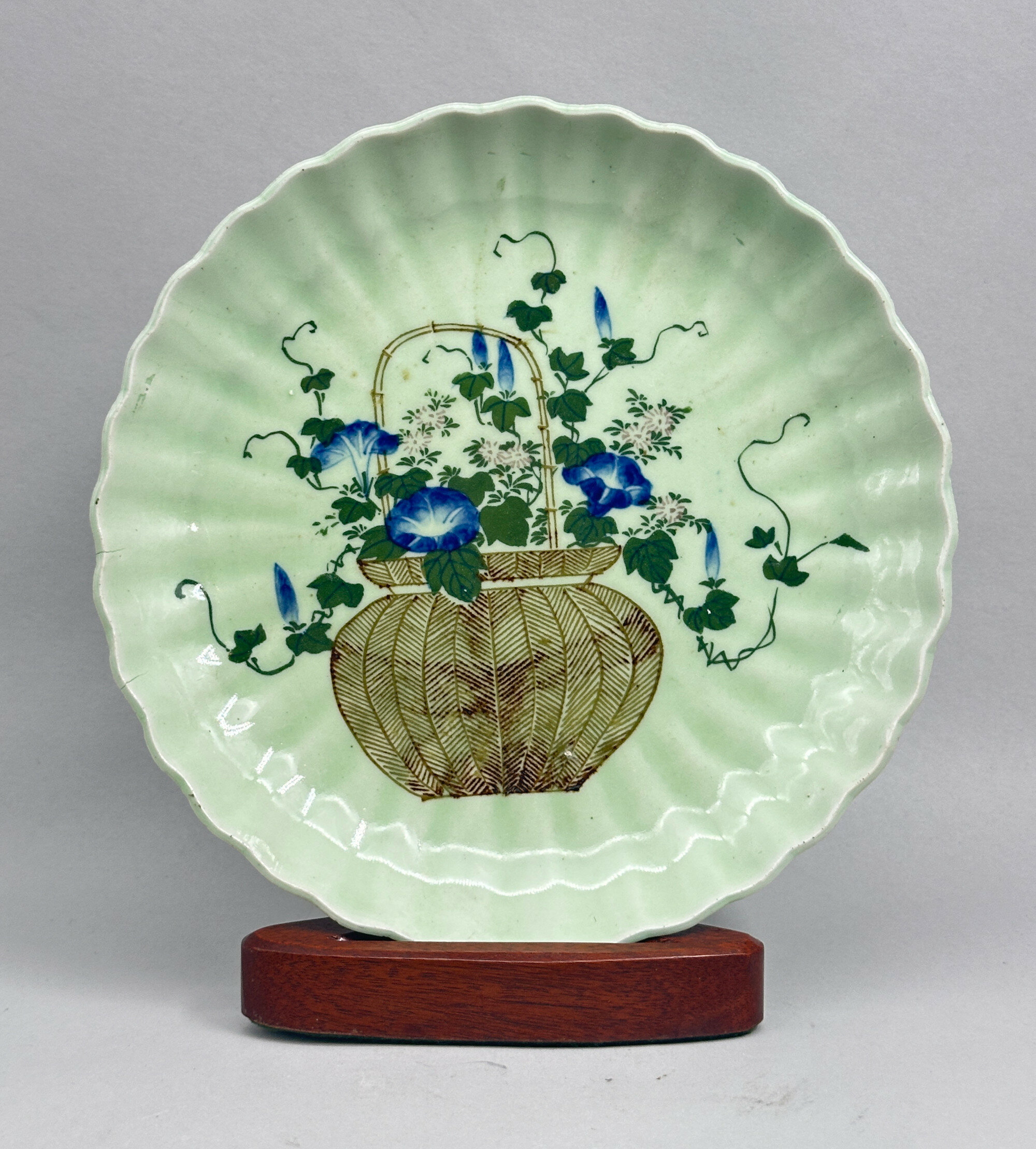
Japanese Celadon Dish decorated basket of flowers, circa 1900
Price: £45Celadon glazed wares with enamel decoration in fairly muted colours are a familiar product amongst the ceramics produced by Japanese potters at the end of the nineteenth century but examples of this type of dish are rather less commonly found. The basket of flowers is a regular decorative feature of Chinese ceramics, but given here a slightly different interpretation with the depiction of lotus, the emblem of summer. The mark probably imitates Chinese ‘commendation’ marks inscribed within the foot rim, another nod on the part of the Japanese potters towards their Chinese counterparts.
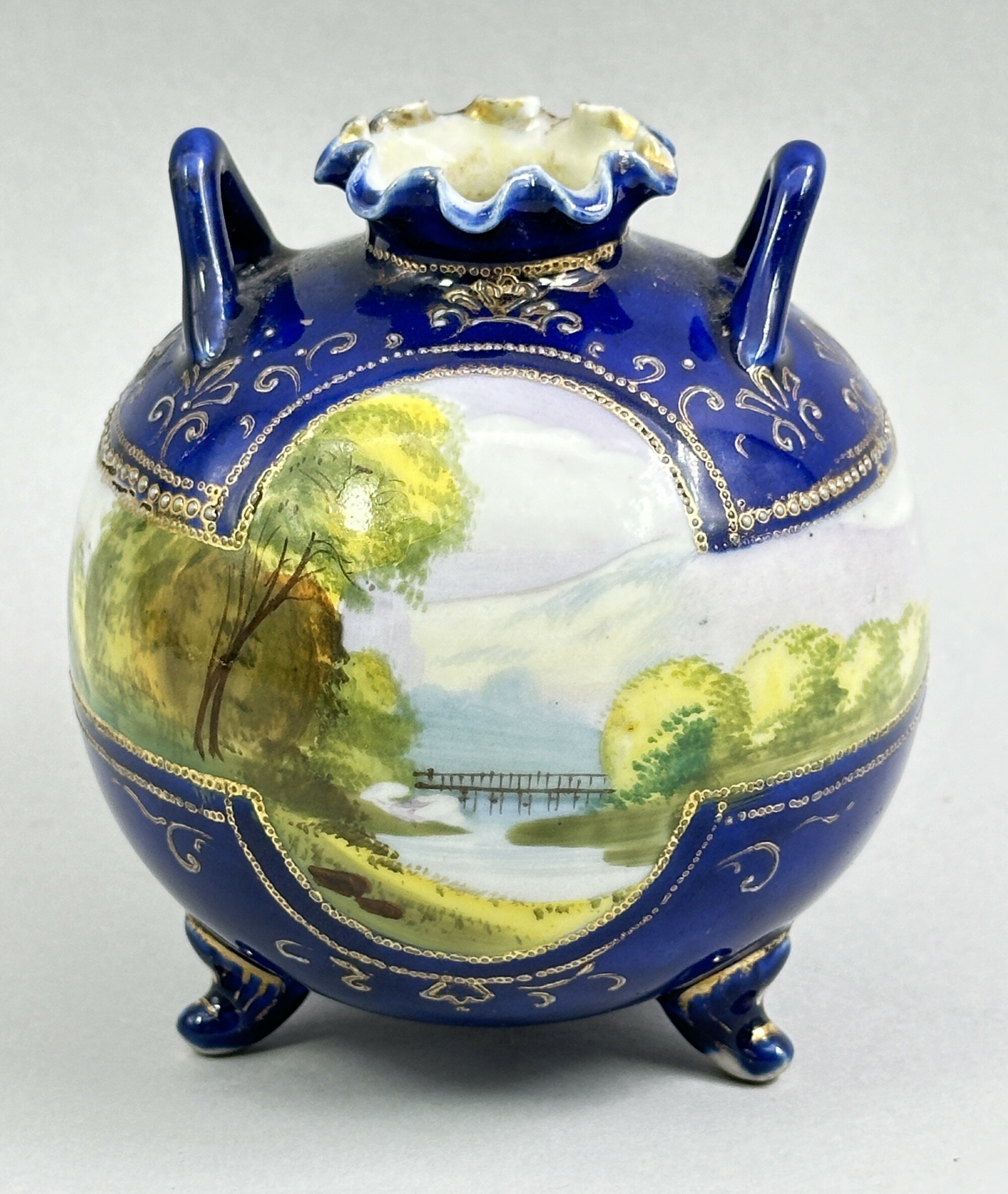
Noritake Vase in the Form of a Pomegranate, marked, Japanese, early 20th Century
Price: £25The Noritake compnay was set up by the Morimura family at Noritake near Nagoya in the early twentieth century. Called at first 'Nippon Toki Kaisha Ltd' on its founding in 1904, the business soon changed its name to 'Noritake' and began the manufacture of porcelains for the domestic and export markets. The mark seen here is interesting. It comprises a 'Komaru' symbol, crowned with "Noritake" and with the mark 'Made In Japan'. The centre symbol said to be taken from the Japanese character "Komaru", meaning "overcoming difficulties". According to the Noritake company tradition this mark was designed when contact with the different culture of the west early in the 20th century caused problems of adaptation. It is also known as the 'tree crest mark' which is the clan crest of the Morimura family. This mark is said to have been registered in London for the UK market by 1908. The curled up ends of the Komaru symbol seen here distinguish this mark from later versions and allow a dating of this piece to the early twentieth century.
Noritake porcelain became synonymous with finely potted tea and breakfast services made in great quantities for export. This vase is a rather more unusual production and shows the factory capable of producing high quality pieces.
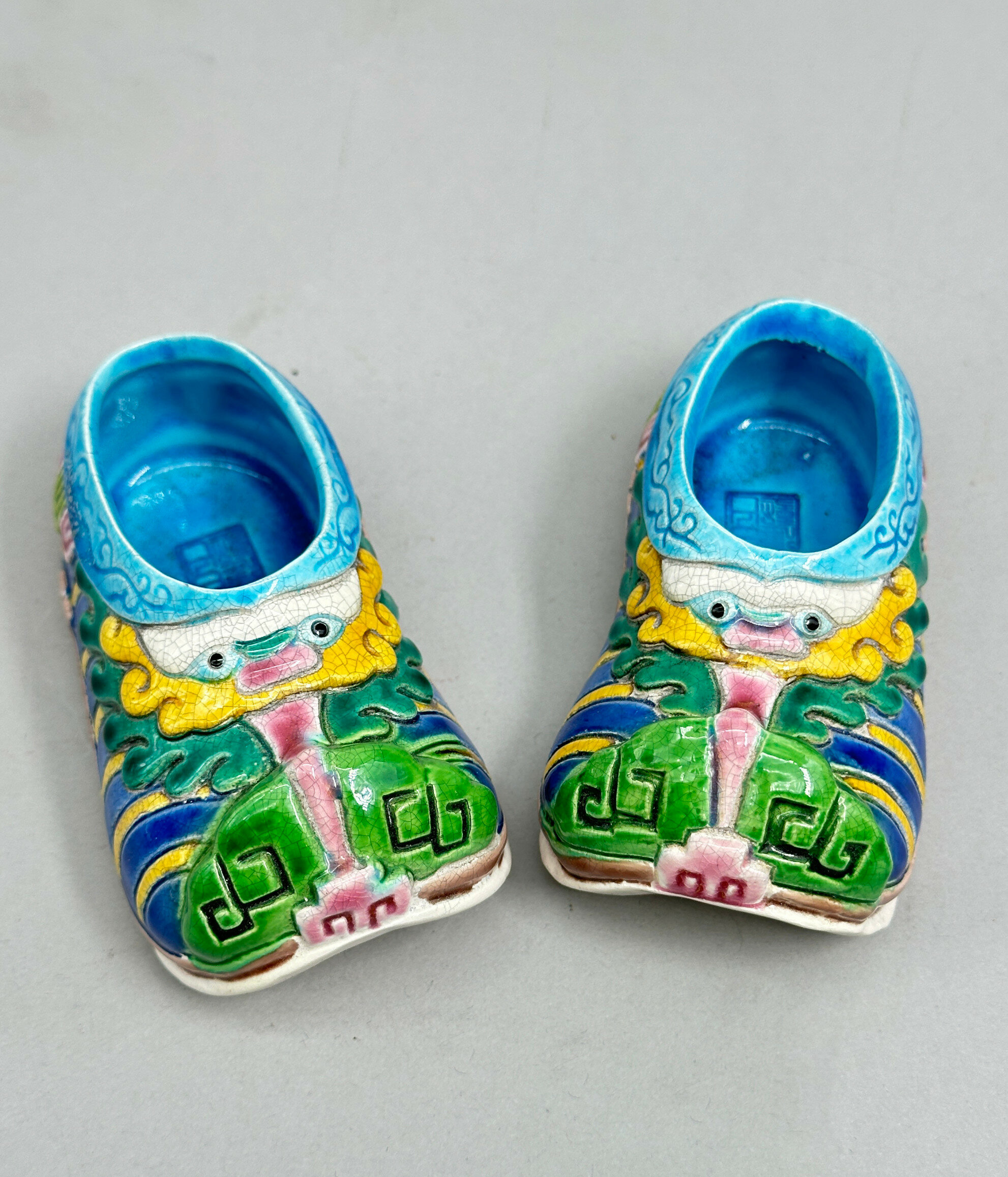
Pair of Chinese Ceramic Shoes, seal mark and with fitted box, C20th
Price: £55
Chinese Cantonese style Vase decorated butterflies, late C20th
Price: £150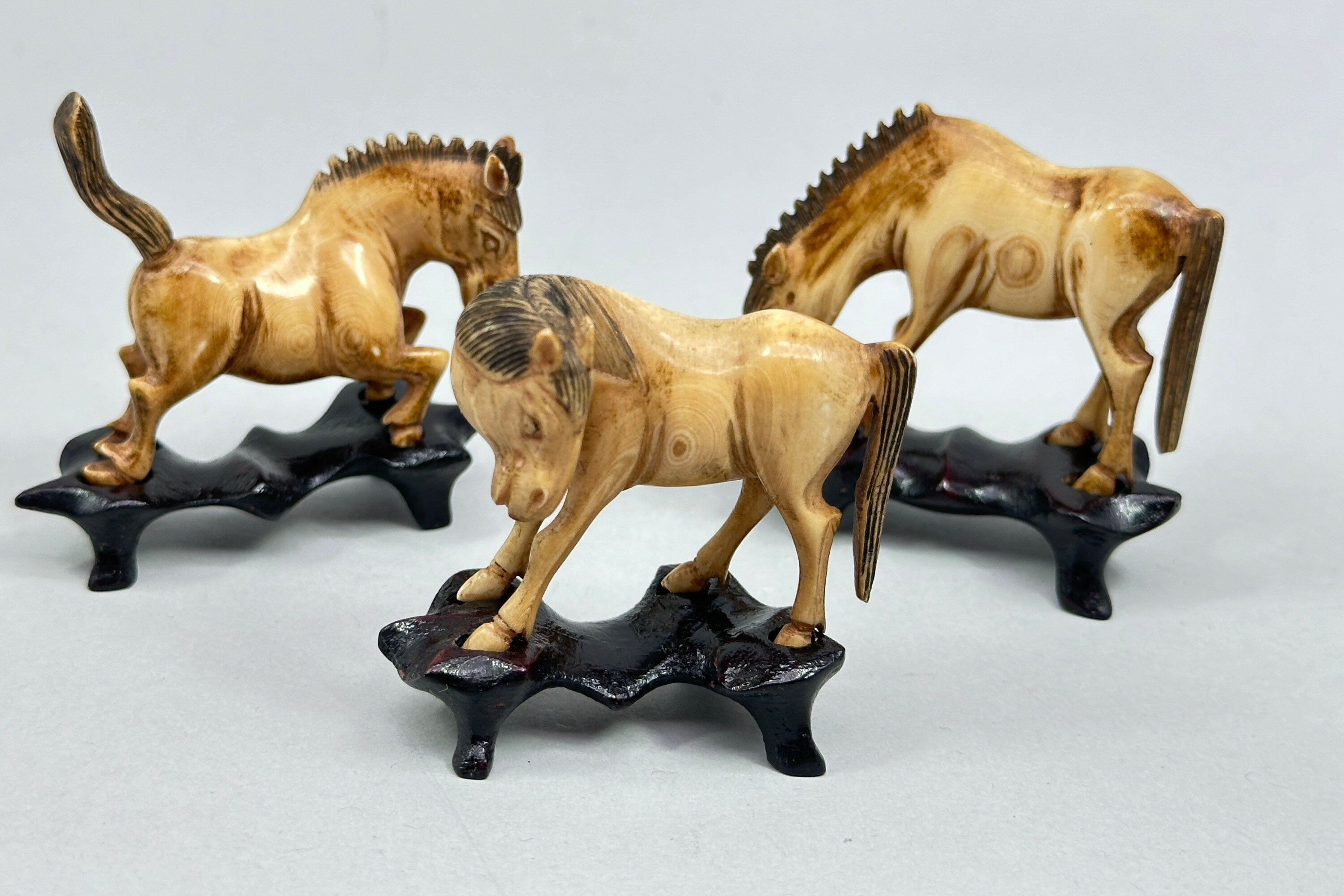
Group of Three Chinese carved bone Horses with wood stands, probably mid C20th
Price: £30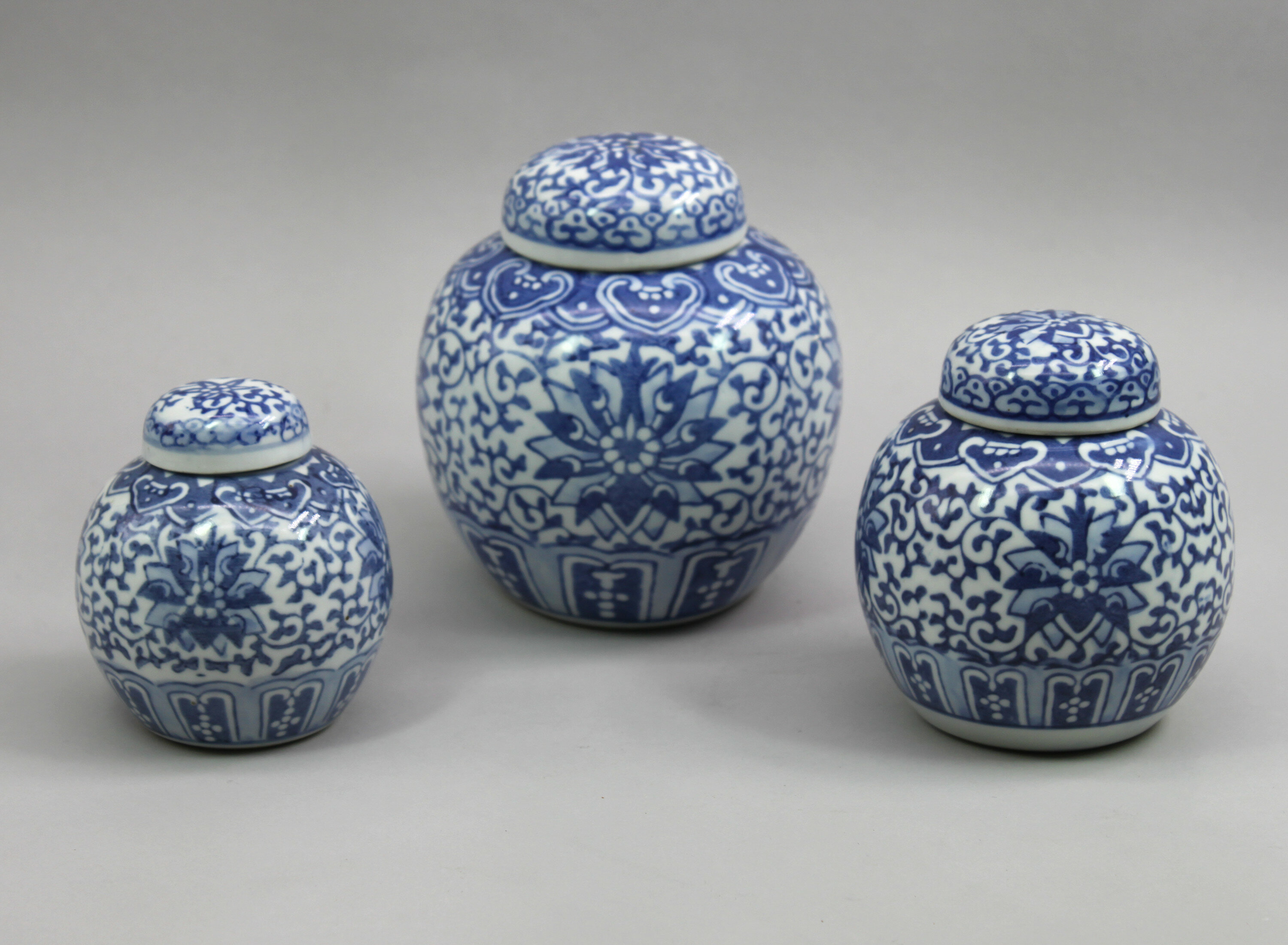
Graduated set of Three Chinese Blue and White Ginger Jars and Covers, 20th Century
Price: £45Although of relatively recent manufacture, the quality of these pieces continues the Chinese ceramic productions of the late nineteenth century and together they form an attractive decorative ensemble for the contemporary interior.
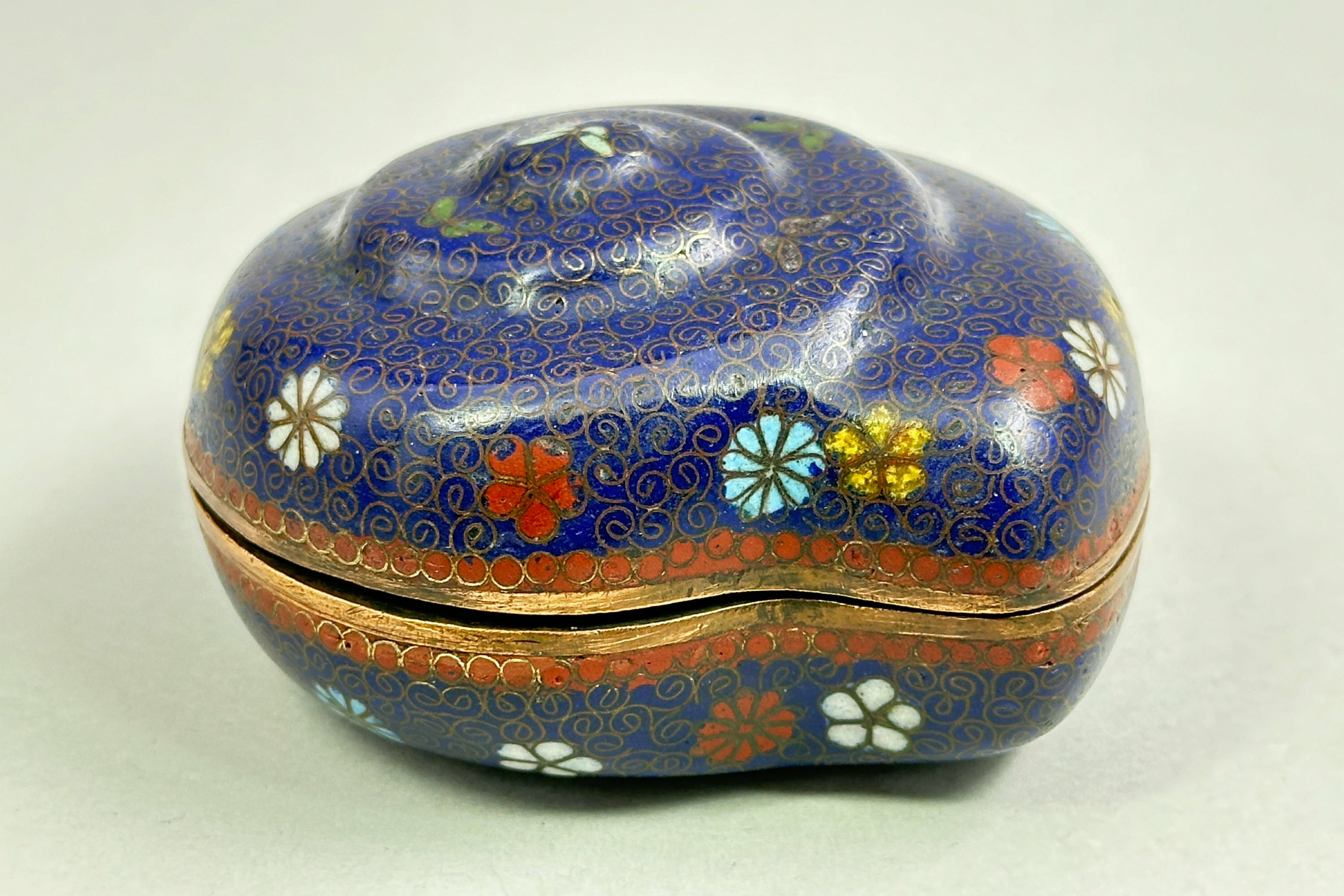
Fine Quality Cloisonne Box and Cover in the form of a Snail, Japanese circa 1880
Price: £95The Japanese produced copies of natural forms in a variety of media. Carved ivory fruit and small animals are well known. Here, cloisonne enamel is used which is less common. The quality of the work speaks for itself and can be judged form the small butterflies on the cover and the green speckle enamel fill at the base. It is typical of the best Meiji period (1868-1912) work and a circa date towards the end of the nineteenth century is most likely.
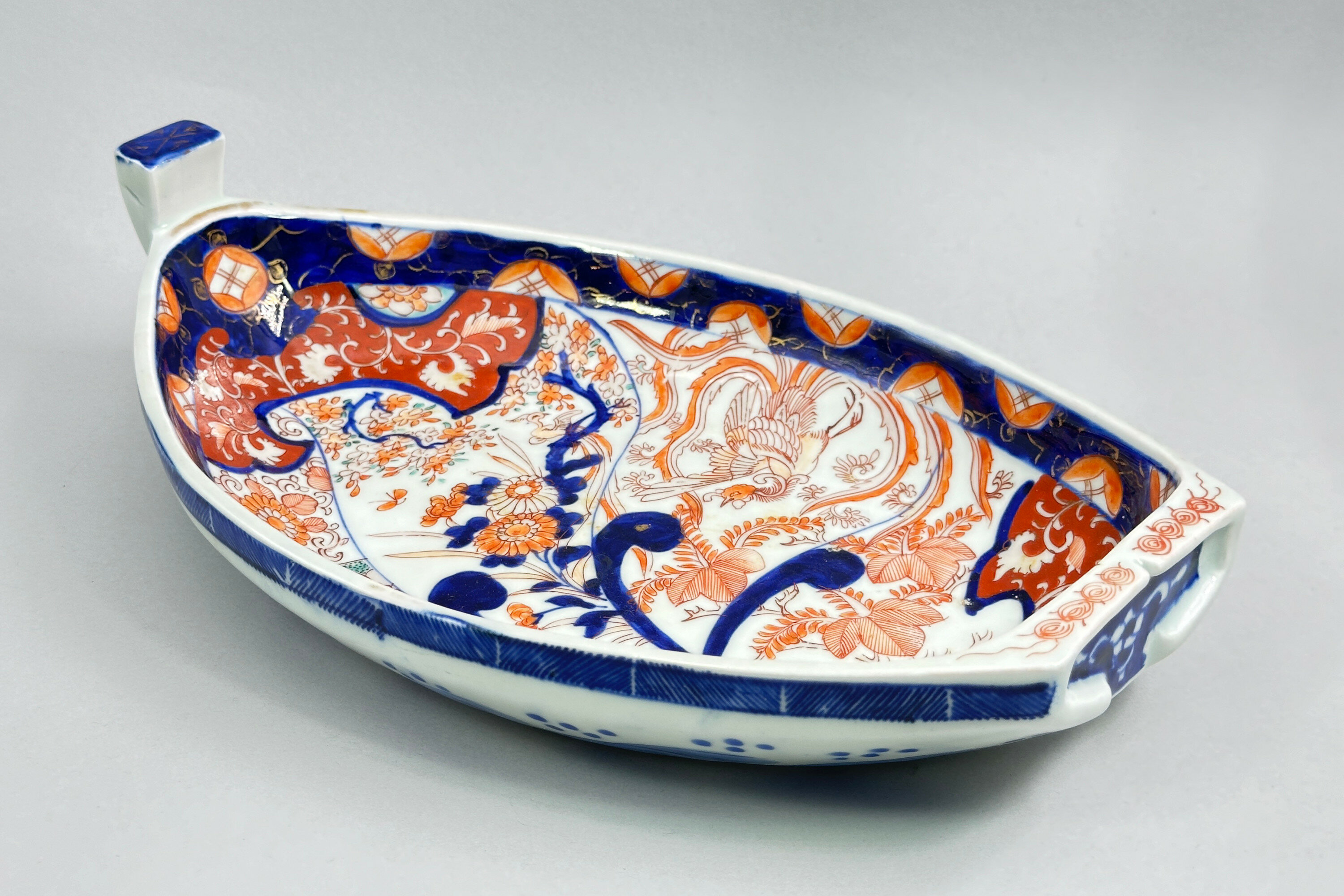
Japanese Imari Dish in the form of a Treasure Boat ‘Takarabune’, Meiji Period, circa 1900
Price: £250In Japanese folklore, the Takarabune or "Treasure Ship", is a mythical ship piloted through the heavens by the Seven Lucky Gods during the first three days of the New Year. Ceramic boat shape dishes were produced during the Meiji period (1868-1912) in both Arita and Imari porcelains. Paste of the foot rim and style of decoration suggest a circa date here towards the end of the nineteenth century.

Chinese Straw Thread Picture on Silk, framed in original box, late C20th
Price: £45